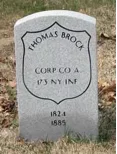
BROCK, THOMAS (1824-1885). Corporal, 173rd New York Infantry, Company A. Born in England, Brock enlisted at Brooklyn as a corporal on September 4, 1862, mustered into the 173rd New York on October 30, and mustered out on October 18, 1865, at Savannah, Georgia. Brock applied for and received an invalid pension in 1876, certificate 176,461, as did his widow, Hattie, in 1885, certificate 221,077. He last resided in Paterson, New Jersey. His death was caused by cancer of the rectum. Section 115, lot 4196, grave 809.
BROCKWAY, FRANK A. (1833-1908). Ordnance sergeant, 13th Regiment, New York State Militia, Company C. A New York City native, he enlisted there as an ordnance sergeant and served for three months in 1861 in the 13th Regiment. In the Civil War Draft Registration records, he is listed as a reporter living on Portland Avenue in Brooklyn. He is listed as a reporter living at 73 Portland Avenue in the Brooklyn Directory for 1863 and the Brooklyn Directory for 1864.
The Brooklyn Directories for 1867-1870 and 1873-1876 list Brockway as a reporter. As per the 1880 census and the 1890-1892 Brooklyn Directory, he was still working as a reporter; the Brooklyn Directory notes that he lived at 167 Willoughby Avenue. His application for an invalid pension was approved in 1896, certificate 849,392. According to his obituary in the Brooklyn Daily Eagle, he was a member of the Brooklyn Masonic Veterans and the 13th National Guard Veterans’ Association. Members of both organizations were invited to his funeral. His last residence was 167 Willoughby Avenue in Brooklyn. Shortly after his death from cancer, Martha Brockway applied for and received a widow’s pension, certificate 659,737. Section 141, lot 23859, grave 2.
Civil War Bio Search

BRODIE (or BRODY), WILLIAM W. (1843-1906). Private, 40th New York Infantry, Company I. Brodie, who was born in Edinburgh, Scotland, enlisted at Yonkers, New York, on July 1, 1861, and mustered into the 40th New York (known as the Mozart Regiment) on the same day. He was wounded at the first Battle of Bull Run, Virginia, and later took part in the Battles of Yorktown, Williamsburg, and the Seven Days fight (all in Virginia). At the Battle of White Oak Swamp, June 30, 1862, which was part of the Seven Days Battle, he was wounded in the thigh and was hospitalized for two and a half months at Cliffburn Hospital in Washington, D.C., before being discharged there for disability on August 6, 1862.
In 1872, Brodie applied for and received an invalid pension, certificate 125,647. He was a mail carrier after returning to civilian life. As per his obituary in the Brooklyn Daily Eagle, which confirms his Civil War service, he became a mail carrier in 1879 and remained at that job for twenty-seven years. He is listed as a letter carrier in the Brooklyn Directories for 1880-1882 and 1890-1892; at the time of the latter directory, he lived at 196 53rd Street. Originally a member of the William Rankin Post #10 of the G.A.R., he then became a charter member of the Ulysses S. Grant Post #327. He was appointed one of the “Relief Guard” when the remains of General Grant lay in state in Albany and subsequently at the City Hall, New York. His obituary notes that he was in charge of placing floral decorations on Grant’s Tomb in New York City every Memorial Day.
Brodie also belonged to civic organizations such as the Royal Arcanum and Freemasons. His obituary reports that veterans and members of the organizations to which he belonged planned to participate in his funeral service and then conduct ceremonies at his grave. He last lived at 318 53rd Street in Brooklyn. Shortly after his death from appendicitis, Emma Brodie, applied for and received a widow’s pension in 1906, certificate 645,170. Section 115, lot 11193, grave 451.
BROLLY, WILLIAM C. (1832-1868). Private, British Guard, 1st Regiment Mobile Volunteers, Alabama, Company C, Confederate States of America. Brolly, who was originally from Ireland, was a private in the Confederate Army. He was a member of the British Guard, part of the 1st Regiment of the Mobile (Alabama) Volunteers. At the time of his death, he lived at 232 West 24th Street in Manhattan. Section 149, lot 19621.
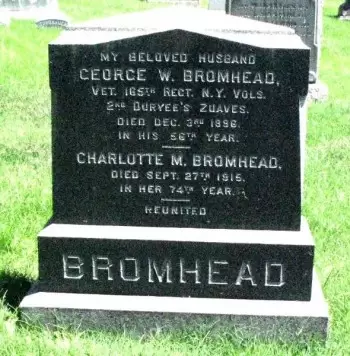
BROMHEAD (or BROOMHEAD), GEORGE W. (1840-1896). Sergeant, 165th New York Infantry, Company A. After Bromhead enlisted as a private on September 16, 1862, at New York City, he mustered into the 165th New York on November 28, 1862, at Camp Washington in Staten Island. He was promoted to corporal of his company at some point before he was reduced in rank to private on October 24, 1863. On April 1, 1864, he was promoted to corporal, and then on May 26, 1865, he was promoted to sergeant. Bromhead mustered out on September 1, 1865, at Charleston, South Carolina.
The New York City Directory for 1875-1876 lists Bromhead as employed in trucks and the 1877 New York City Directory notes that he was a cartman. According to the 1880 census, he was employed as a truckman. In 1891, he applied for an invalid pension, application 1,010,293, but no certificate number is listed. His last residence was 297 Madison Street, Brooklyn. His tombstone is inscribed with information about his service in the 165th and its connection to the 2nd Battalion of Duryee’s Zouaves. After his death, Charlotte Bromhead, who is interred with him, applied for and was granted a widow’s pension, certificate 463,516. Section 137, lot 29572.
BROMLEY, GEORGE W. (1835-1902). Quartermaster sergeant, 32nd New York Infantry; private, 71st Regiment, New York State Militia, Company F. A native of Connecticut, Bromley was living with his parents in Windham, Connecticut, at the time of the 1850 census. After serving in the 71st New York State Militia, Bromley enlisted at New York City on August 29, 1861, as a quartermaster sergeant and mustered immediately into the Field and Staff of the 32nd New York Infantry. He was discharged for disability on June 23, 1862.
As per the 1870 census, Bromely was living in Brooklyn with his parents, his wife and his two children while working as an insurance broker. He relocated to East Orange, New Jersey, before the 1880 census. The 1890 Veterans Schedule confirms his service in the 71st and 32nd Regiments. As per the 1900 census, he was working as a shoe clerk and living in East Orange, New Jersey, with his wife and daughter. Although he applied for an invalid pension in 1902, application 1,283,965, he apparently died before it was certified. He last lived in East Orange, New Jersey. Almira Bromley applied for and received a widow’s pension, certificate 645,089. Section 154, lot 22936.
BRONSON, NELSON (1831-1903). First lieutenant, 8th Connecticut Infantry, Company E; Veteran Reserve Corps. Originally interred at Green-Wood, Bronson’s remains were removed to Riverside Cemetery in Waterbury, Connecticut, on August 5, 1922. After enlisting as a first sergeant at his birthplace of Waterbury, Connecticut, on September 6, 1861, Bronson mustered into the 8th Connecticut on September 25, and was promoted to first lieutenant on March 18, 1862. He was wounded in the arm and back at Antietam, Maryland, on September 17, 1862. After his discharge on January 17, 1863, he re-enlisted later that year and was commissioned as a first lieutenant in the Veteran Reserve Corps on August 19, 1863. He served there until his discharge on October 15, 1866. Subsequently, he was commissioned as a second lieutenant in the 42nd Infantry of the United States Army on July 28, 1866, was promoted to first lieutenant on June 8, 1874, and served until his retirement on November 30, 1879. His last address was 38 East 5th Street in Brooklyn. The stone at Green-Wood is a cenotaph in his memory. Section 128, lot 31394, grave 415.
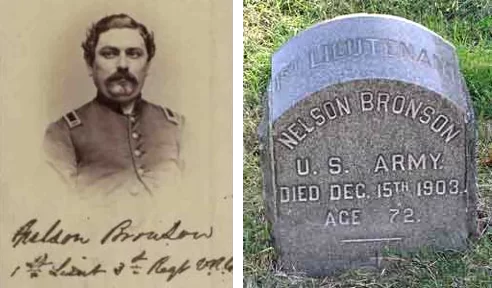
BROOKE (or BROCK, BROOK), WILLIAM CORNELIUS (1833-1911). Private, 26th Virginia Infantry, Company F, Confederate States of America. Brooke was born in King William County, Virginia. On April 5, 1853, he married Mary Ann Garland; they had four children. As per the 1860 census, where he was listed as William C. Brock, he was a sailor living in New York with his wife and children. A mechanic by trade, he enlisted as a private on June 17, 1861, and mustered immediately into Company F of the 26th Virginia Infantry. He was listed as returned on February 2, 1862, and detailed to West Point (Virginia) as a carpenter on gun boats on July 15, 1862. Brooke surrendered with the Army of Northern Virginia on April 9, 1865, at Appomattox Court House, Virginia.
The 1870 census reports that Brooke lived in Brooklyn with his wife and children, had a personal estate of $1,200 and worked as a stevedore. He married Amanda Lockwood, his second wife, on January 4, 1872, in Brooklyn; they had six children. At the time of the 1880 census, he lived at 387 18th Street in Brooklyn with his wife and children and was still working as a stevedore. Brooke is listed as a stevedore in the New York City Directory for 1882-1883, the Brooklyn Directory for 1885-1886 and the New York City Directory for 1891-1892. The 1900 and 1910 censuses indicate that he lived in Brooklyn with his married child’s family and was still employed as a stevedore; his wife, Amanda Brooke, who is interred with him, died in 1901. As per his obituary in the Brooklyn Daily Eagle, he lived in Brooklyn for fifty years and was a member of the South Reformed Church and the Order of the Golden Cross. That obituary also notes that he was a well-known hiring stevedore on South Street in Manhattan. Although the Brooklyn Daily Eagle states that he died at his home in Brooklyn, that is incorrect; other sources state that he died in Jersey City, New Jersey. He last lived at 469 56th Street in Brooklyn. Brooke’s death was attributed to tuberculosis. He was survived by three sons and three daughters. Section 17, lot 17245, grave 426.
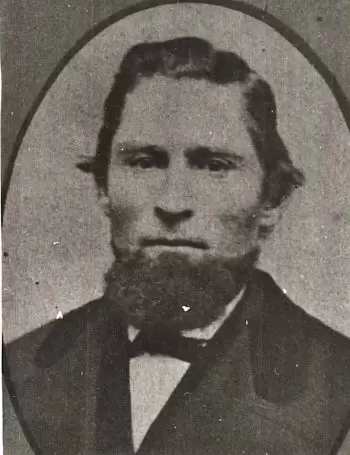
BROOKS, CHARLES STEWART (1842-1862). Captain, 4th California Infantry, Company H; second lieutenant, 5th United States Cavalry. A native of New York City, his father, William Foreman Brooks, was a wealthy metal manufacturer there who made parts for locomotives and firearms. Brooks was educated at West Point. He enlisted as a second lieutenant on October 1, 1861, at Weaverville, California. According to his obituary in The New York Times, he was among the first to raise an order of infantry in California. He mustered into Company H of the 4th California on November 1, and was promoted to captain of his company at some point. After resigning on April 3, 1862, Brooks was commissioned as a second lieutenant in the 5th United States Cavalry and joined the regiment near Richmond, Virginia, in May 1862. His regiment was with General McClellan throughout the War and distinguished itself at Hanover Courthouse, Virginia.
Brooks was at Fortress Monroe, Virginia, on July 1, 1862, sick with typhoid fever, and died six days later, two weeks after contracting the disease. Brooks was deeply respected and beloved by his men and by his commanding officers, including General Burnside, who attributed the highest commendation to his service. Embalmed at Fortress Monroe, he was transported by ship to New York, and was buried with full military honors at Green-Wood. His last address was 49 West 22nd Street, Manhattan. Section 107, lot 10241.
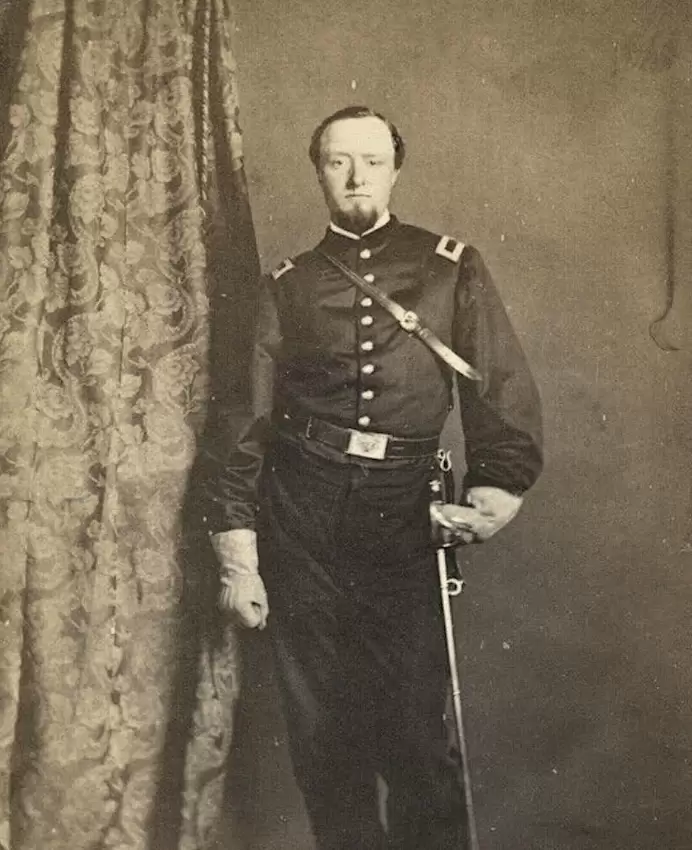
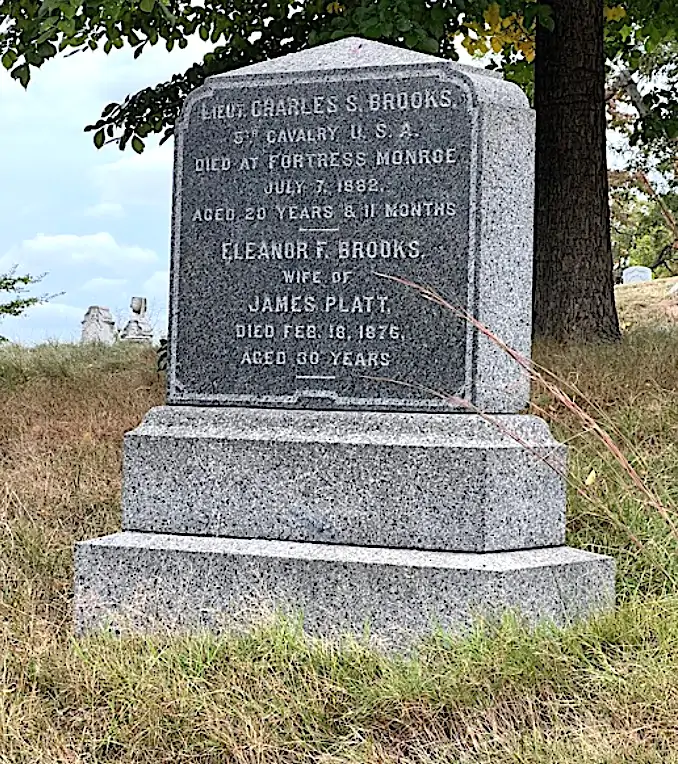
BROOKS, FREDERICK W. (1840-1909). Private, 22nd Regiment, New York State National Guard, Company I. Brooks, a native New Yorker, served in the 22nd New York National Guard for 30 days in 1863. According to census records, he lived in Brookston, Pennsylvania, where he owned a tannery in 1880. He is likely the Frederick W. Brooks who is listed in the New York Directory for 1891-1892 as working in leather. The 1900 census reports that he was an insurance broker in Brooklyn. As per his obituary in the Brooklyn Daily Eagle, members of his Masonic lodge were invited to attend his funeral. He last lived at 759 Eastern Parkway in Brooklyn. His cause of death was nephritis. Section 148, lot 22663.
BROOKS, HENRY SAND (or SANDS, C., L.) (1839-1893). First lieutenant, 83rd New York Infantry, Company E. After enlisting at New York City on April 27, 1861, Brooks, a native of the city, was commissioned into the 83rd New York that same day, and was discharged on October 13. He last resided in Saratoga Springs, New York. Brooks died from gastritis. Section 30, lot 6361.
BROOKS, HORACE (1814-1894). Brigadier general by brevet; colonel, 4th Artillery, United States Army; lieutenant colonel, 2nd United States Artillery. Born in Boston, Massachusetts, he graduated from the United States Military Academy in 1835, and was assigned to artillery. Brooks was the second lieutenant in the 2nd U.S. Artillery as of December 28, 1835, and was brevetted to first lieutenant for “gallantry and good conduct in the war against the Florida Indians.” After he fought in the Seminole Wars, he was an assistant professor of mathematics at West Point in 1836-1839, was promoted to first lieutenant of the 2nd Artillery on February 2, 1837, and then assigned to the dispute on the Canadian border in 1839. In 1840, he was granted a master’s degree from Geneva College. He spent time recruiting and on arsenal duty in New York prior to the Mexican War where he fought at numerous battles and was brevetted to major on August 20, 1847, “for gallant and meritorious conduct in the Battles of Contreras and Churubusco, Mexico.” A month later on September 8, he was brevetted lieutenant colonel “for gallant and meritorious service in the Battle of Molino Del Rey, Mexico.” He was then assigned to the frontier where he was fighting Indians in the West in New Mexico and Utah. After an assignment at Fort Leavenworth, Kansas, in 1857-1860, he was at Fort McHenry, Maryland, in 1861.
Soon after the Civil War began, Brooks was promoted on April 28, 1861, to major of the 2nd United States Artillery where he was at Fort Pickens, Florida, from April through October 1861. Promoted to lieutenant colonel on October 26, 1861, he was in command in Philadelphia, Pennsylvania, in April-May 1862, on leave from May through September, and then on the Board for Retiring Disabled Officers from July through September 1862. In September 1862, he was superintendent of Volunteer Recruiting Service and the chief mustering and disbursing officer at Columbus, Ohio, until September 1, 1863. Upon his promotion to colonel of the 4th U.S. Artillery on August 1, 1863, he was in command of regimental headquarters at Fort Washington, Maryland, as of September 10, 1863, until November 13, 1865. Brooks was brevetted a brigadier general on March 13, 1865, “for faithful services during the War.” He then served at Fort McHenry, Maryland, and in Washington, D.C., and Presidio, California. On January 10, 1877, having reached the mandatory retirement age, he ended his Army career. He last resided at 238 East 34th Street in Manhattan. He died in Kissimmee, Florida, of a concussion. Section 143, lot 26778.
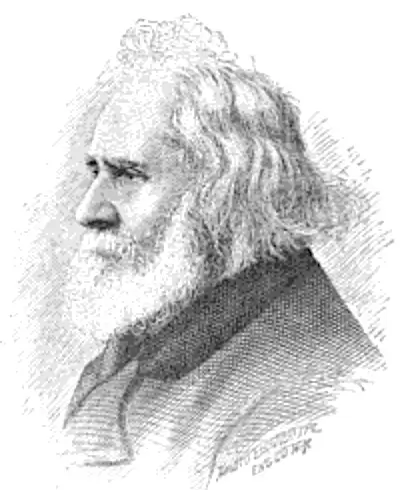

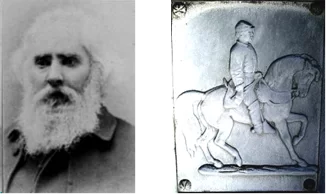
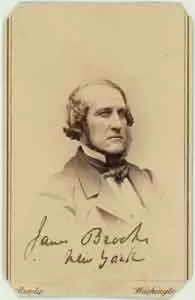
BROOKS, JAMES (1810-1873). Congressman and newspaper editor. Born in Portland, Maine, his father died in the War of 1812. Upon his father’s death, Brooks was bound to a shopkeeper in Maine. He attended the academy at Monmouth, Maine, then taught school in Lewiston at the age of sixteen. In 1831, he graduated from Waterville (now Colby) College at the top of his class. While studying law, he was editor of the Portland Adviser and the paper’s Washington correspondent in 1832. Becoming active in politics, he was elected to the State House in 1835. After an unsuccessful Congressional bid in 1836, he settled in New York City where he founded the New York Express, an association that continued throughout his life, and was elected to the State Assembly in 1837. Elected as a Whig to the 31st and 32nd Congresses (1849-1853), he supported the Compromise of 1850.
During the election of 1860, Brooks supported Stephen Douglas and urged in 1861 that the South be allowed to secede peacefully. An extreme Copperhead Democrat who advocated the overthrow of the Lincoln Administration, he returned to Congress in 1862 and was re-elected to all but one term (1866-1868) until his death. On July 17, 1863, he wrote an article, “The Riot-Its History” in his publication, the New York Express. The slant of the article supported the position that the Draft Riots were a revolt against Republican Party Centralization by suggesting the unsubstantiated evidence that looters and marauders came from near and far to participate.
Brooks advocated a “mild” Reconstruction and opposed both President Andrew Johnson’s impeachment and Radical governments in the South. In October 1867, he was appointed a government director of the Union Pacific Railroad, an association that led to his implication in the infamous Crédit Mobilier scandal in 1872. Accused of taking bribes and censured by the House of Representatives on February 27, 1873, he was, nonetheless, re-elected by his constituents. He died from stomach cancer in Washington, D.C. Section 60, lot 692.
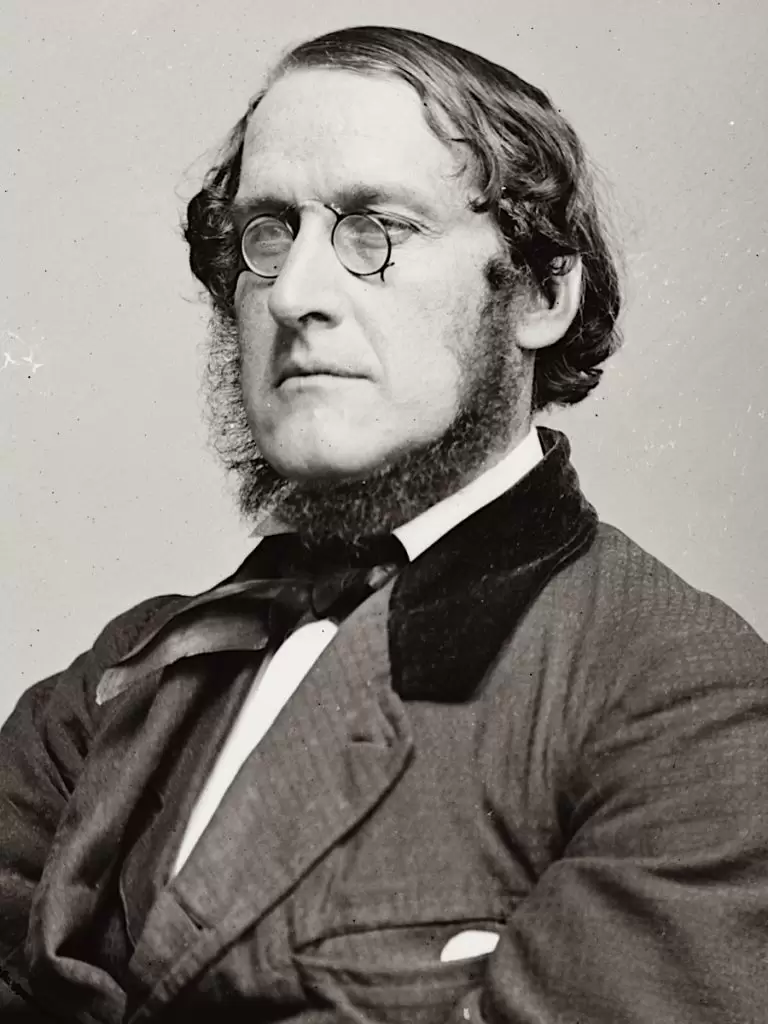
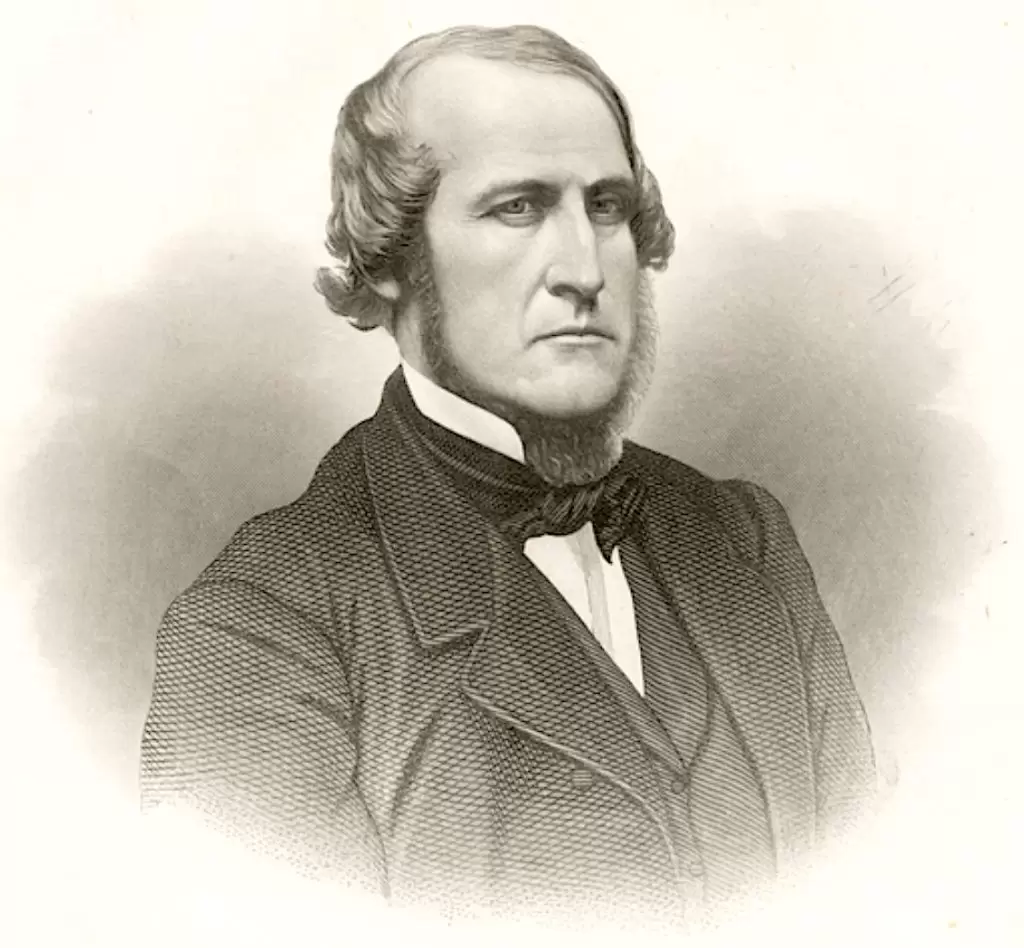
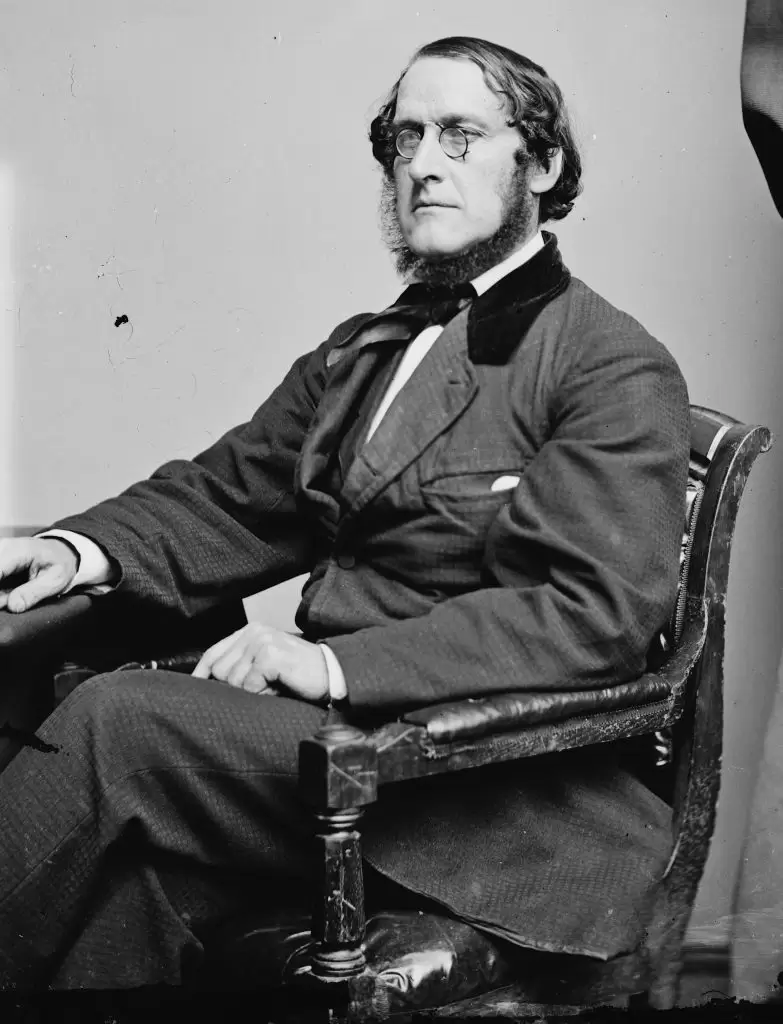
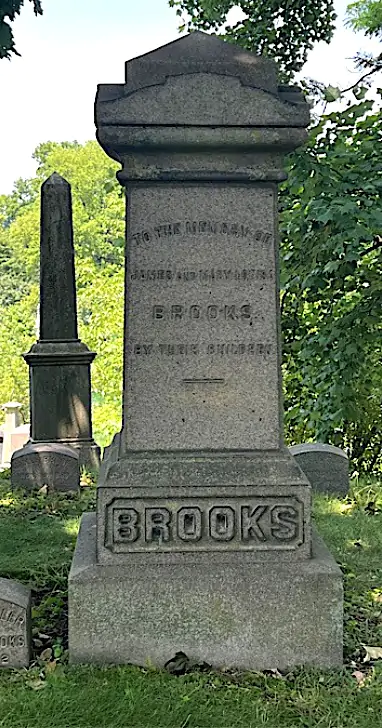
BROOMFIELD, JAMES (1834-1900). Private, 3rd New York Light Artillery, Battery B. Of English birth, he enlisted as a private on February 1, 1862, at Auburn, New York, mustered into the 3rd New York Light Artillery the next day, and was discharged from military service on February 11, 1865, at Hilton Head, South Carolina. He applied for an invalid pension, application 1,158,849 in 1894. Broomfield last lived at 50 Bushwick Avenue, Brooklyn. His death was attributed to pneumonia. In 1900, his wife applied for and was granted a widow’s pension, certificate 510,332. Section 69, lot 11554.
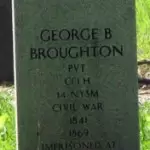
BROUGHTON, GEORGE B. (1841-1869). Private, 84th New York (14th Brooklyn) Infantry, Company H; 5th New York Veteran Infantry, Company I. A Brooklyn native, he enlisted there as a private on October 1, 1862, mustered into the 14th that day, and transferred into the 5th Veterans on June 2, 1864. Broughton was captured on August 19, 1864, at Weldon Railroad, Virginia, was sent to Salisbury, North Carolina, where he was imprisoned on October 9, and paroled on February 27, 1865. He mustered out on June 26, 1865, at McDougall Hospital in New York City. His last address was 146 Elliott Place in Brooklyn. Section 180, lot 15958.
BROWER, BLOOMFIELD (1839-1912). Corporal, 7th Regiment, New York State Militia, Company B. Brower, a native of New York City, served with the 7th Regiment as a private for 30 days in 1861, returned to the same regiment and company for three months as a corporal in 1862 when the regiment was part of the New York State National Guard, and was reactivated as a corporal for 30 days in 1863. The New York City Directories for 1875-1876, 1877, and 1882-1883 list him as a stationer. He last lived at 130 East 24th Street in Manhattan. His death was attributed to nephritis. Section 42, lot 24668.
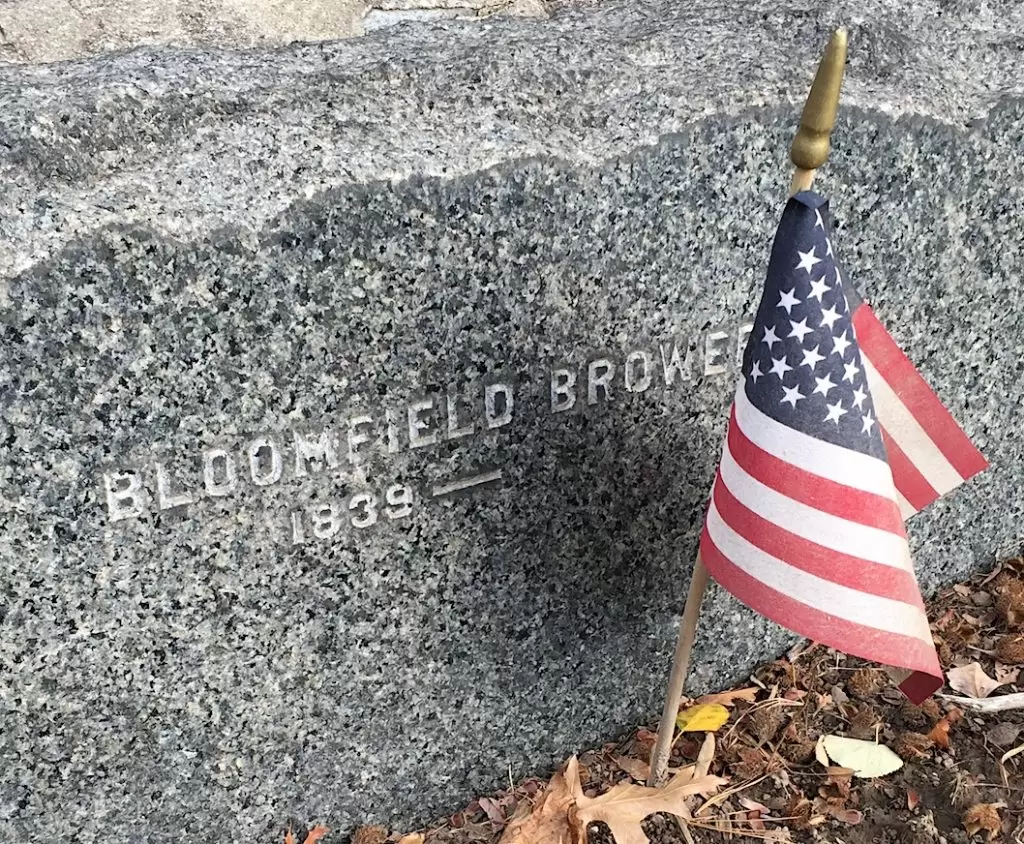
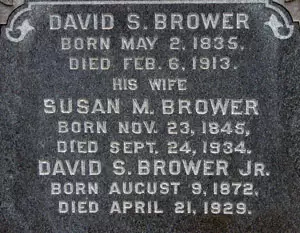
BROWER, DAVID S. (1835-1913). Captain, 56th Regiment, New York State National Guard, Company F; private, 13th Regiment, New York State National Guard, Company H. A native New Yorker, he enlisted at Brooklyn on May 28, 1862, mustered into the 13th Regiment that day, and mustered out at Brooklyn three months later on September 12, 1862. He re-enlisted at Brooklyn as a first lieutenant and was commissioned into the 56th National Guard on June 18, 1863, and mustered out after 30 days on July 24. Brower was promoted to captain and commissioned into the same regiment and company on August 2, 1864, and mustered out after 100 days on November 6, 1864, at New York City.
After the Civil War, Brower worked for Abraham & Straus, a department store. He is listed in the Brooklyn Veterans’ Census of 1890. In 1897, he applied for an invalid pension; his widow, Susan Brower, applied for and was granted a pension under certificate 758,615. In 1910, Brower became a member of the G.A.R.’s William Rankin Post #10 in Brooklyn. As per his obituary in the Brooklyn Daily Eagle, members of the Rankin Post and members of the Independent Order of Odd Fellows, of which he was a member, were invited to attend his funeral. He last resided at 400 Sterling Place in Brooklyn. His death was attributed to apoplexy. Section 194, lot 29692.
BROWER, JOHN (1837-1920). Private, 18th New York Cavalry, Company F. Born in Tappan, New York, Brower enlisted as a private on July 3, 1863, at New York City, having had prior service in Company D of the 32nd New York. He mustered into the 18th New York Cavalry on August 31, 1863, and mustered out on January 30, 1866, at New Orleans, Louisiana. His last residence was on Tenafly Road in Tenafly, New Jersey. Brower’s death was caused by arteriosclerosis. Section 103, lot 1786.
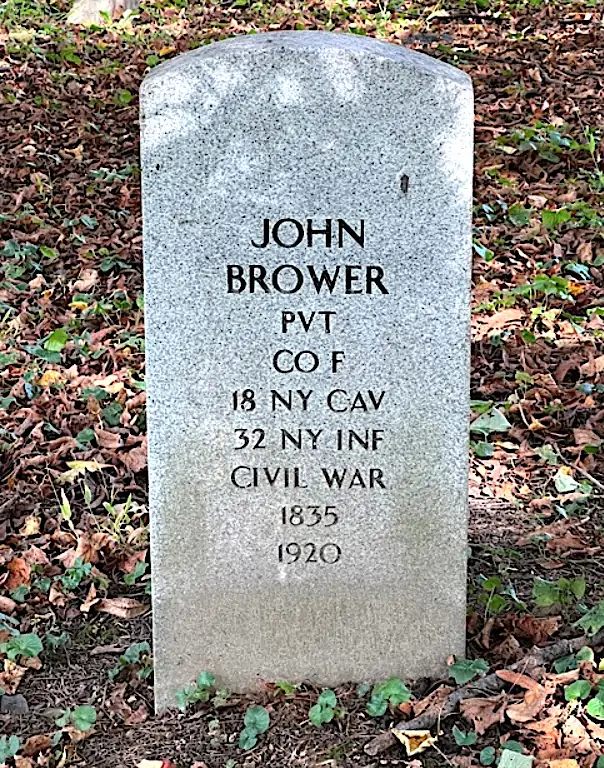
BROWER, JOHN LOVETT (1844-1906). Lieutenant colonel, 3rd United States Colored Infantry (USCT), Company D; private, 7th Regiment, New York State National Guard, Company A. Brower received a Master of Arts from Columbia University in 1862, and became a member of the 7th Regiment that year serving for three months. On August 12, 1863, he was commissioned captain of the 3rd U.S. Colored Infantry, Company D, and was promoted to lieutenant colonel of the same regiment on September 13, 1865.
After mustering out of military service, Brower graduated from Columbia Law School in 1867, and was for many years a member of the New York Bar. He is listed as a lawyer in the Brooklyn Directory for 1885-1886, the New York City Directory for 1891-1892; he lived at 418 East 23rd Street. He was also a member of the G.A.R., belonged to the American Numismatic and Archeological Society, and studied and mastered several foreign languages. His name is displayed on the African American Civil War Memorial in Washington, D.C., plaque A-8. His last home was at 3 West 32nd Street in Manhattan, his death resulting from injuries incurred after being struck by a car at Bowling Green and Broadway. Section 99, lot 6234.
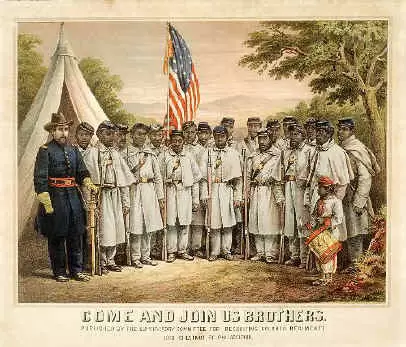
BROWER, SELAH (1844-1889). Private, 13th Regiment, New York State National Guard, Company K. Brower enlisted and mustered into the 13th at Brooklyn on May 28, 1862, and mustered out there after three months on September 12. He last lived in Brooklyn where he died from pneumonia. Section 17, lot 17245, grave 1691.
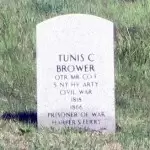
BROWER, TUNIS C. (1818-1866). Quartermaster, 5th New York Heavy Artillery, Company F. He enlisted as a first lieutenant at New York City on March 6, 1862, mustered in on that date, and was officially promoted to first lieutenant on June 10, 1862. Taken as a prisoner of war on September 15, 1862, at Harpers Ferry, Virginia, he was paroled the same day. Brower was promoted to quartermaster on August 15, 1863, and mustered out with his unit on March 6, 1865. He mustered into the same regiment on March 7, 1865, and mustered out at New York City on July 19, 1865. Brower last resided at 10 West 49th Street in Manhattan. His death was attributed to diarrhea. Section 35, lot 4486.
BROWER, WILLIAM V. (1831-1866). Private, 117th New York Infantry, Company C; 48th New York Infantry, Company C. Brower enlisted as a private at Brooklyn on March 9, 1865, and mustered into the 117th that day. On June 8, 1865, he transferred into the 48th New York from which he was discharged. He last lived at 182 Bridge Street in Brooklyn. His death was caused by apoplexy. Section 170, lot 14371.
BROWN, ADAM T. (1832-1910). Private, 173rd New York Infantry, Company B. A Long Island native, Brown enlisted as a private on August 8, 1862, at Williamsburg, New York, and on October 30 of that year mustered into the 173rd New York. He deserted two days later at New York City. He last resided at 333 Lincoln Road in Brooklyn. His death was due to pneumonia, Section 205, lot 31190.
BROWN, ALEXANDER (1828-1864). Private, 84th New York (14th Brooklyn) Infantry, Company B. Of Irish birth, he enlisted at Brooklyn on April 18, 1861, and mustered into the 14th on May 23. Wounded at the Battle of the Wilderness, Virginia, on May 8, 1864, he died on May 22 from those wounds at Alexandria, Virginia, and was interred at Green-Wood on May 28. Section 115, lot 4196, grave 597.
BROWN, BERNARD (or BURNARD) JACKMAN (1843-1914). Corporal, 5th New York Heavy Artillery, Company L; private, 8th Regiment, New York State National Guard, Company G. A native New Yorker, Brown lived in New York City at the time of the 1860 census. During the Civil War, he enlisted as a private at New York City on May 29, 1862, and immediately mustered into the 8th Regiment, known familiarly as the Washington Greys. He mustered out with his company after three months on September 10 at New York City. Brown re-enlisted on May 15, 1864, and mustered into the 5th New York Heavy Artillery ten days later. As per his muster roll, he was a blacksmith who was 5′ 6″ tall with black eyes, black hair and a dark complexion. Brown was promoted to corporal on June 26, 1865, and mustered out on July 19, 1865, at Harpers Ferry, West Virginia.
Brown was living in Brooklyn by 1875. The 1880 census notes that he was married with two children, living in Brooklyn and employed as an upholsterer. At that time, Brown had invested $250 in his business, $200 in materials and had a $750 total product for the year. In 1904, his application for an invalid pension was approved, certificate 1,121,241. At the time of the 1910 census, he was still employed as an upholsterer and lived at 1214 DeKalb Avenue in Brooklyn with three of his children and two members of his wife’s family. He also indicated that he had been married for forty-one years, was literate and was a survivor of the Union Army. His last address was 1219 DeKalb Avenue in Brooklyn. The cause of his death was nephritis. Shortly after his death in 1914, Mary Brown applied for and was granted a widow’s pension, certificate 781,396. Section 154, lot 22050, grave 2.
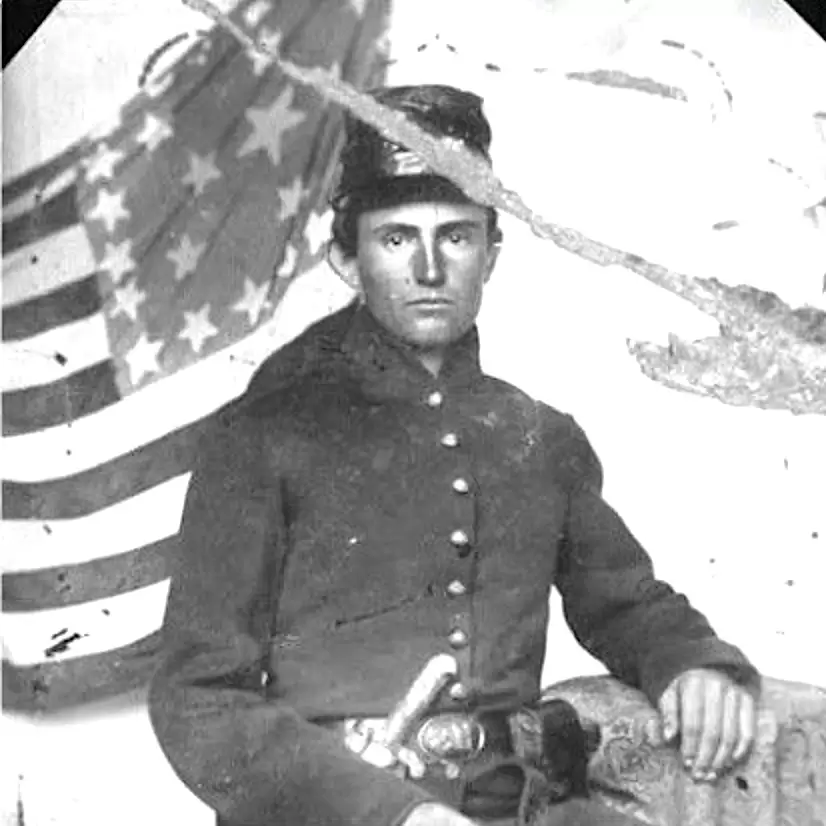
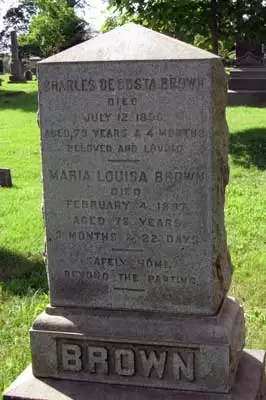
BROWN, CHARLES DeCOSTA (1817-1896). Physician and embalmer. Originally from Philadelphia, Pennsylvania, Brown was a graduate of the University of Pennsylvania, class of 1840. A physician and dentist, he moved to New York City in 1850 where he established a dental practice. Late in the 1850s, he headed Masonic Lodge 330 there. Early in the Civil War, late in 1861, he and Joseph B. Alexander, a doctor from New York, opened an office in Washington, D.C., for “the purpose of embalming and preserving the bodies of such brother Masons, citizens or soldiers who may be so unfortunate as to die or be killed, while at the seat of war and away from their families and friends.” In his letter to Masonic officials dated December 27, 1861, he noted that the bodies would be embalmed using techniques that had been developed in Paris, France, that would eliminate “the gloom of death.” The families of fellow Masons would not be charged for the service.
As the Drs. Brown and Alexander explained in their letter to the Masons:
The truly sympathetic heart must immediately appreciate the advantage of having the body of a deceased friend or relative returned to its sacred home free from the taint and ghastly discolor of a decaying corpse.
By our system persons dying away from their homes can be returned to the bosom of their friends in as perfect condition as that the day of their death, and can be thus retained for months or years without the necessity of immediate burial, as a corpse embalmed by us presents all the appearance of sleeping life, rather than the gloom of death.
In 1862, Secretary of War Edwin M. Stanton, a former dental patient of Brown’s, appointed him Embalmer of the United States Government. On February 20, 1862, President Abraham Lincoln’s beloved son, Willie, just 12 years old, died of typhoid fever. It was Dr. Brown who embalmed Willie. His remains were then temporarily entombed at Georgetown’s nearby Oak Hill Cemetery, in the mausoleum of the Carroll family. A bronze plaque there, placed just a few years ago, reads in part as follows:
William Wallace “Willie” Lincoln (1850-1862). Third son of Abraham and Mary Lincoln rested here from 2/24/1862, until his remains accompanied his father’s to their final resting place in Springfield, Illinois, on 4/21/1865. William Thomas Carroll, Supreme Court Clerk and family friend offered Lincoln a temporary place of repose for Willie in the Carroll Family Mausoleum. The President, sad to leave him cold and alone, visited several times and had the crypt and casket opened.
It would have been Dr. Brown who opened the casket, on these visits, so that the mournful President could see his son.
Dr. Brown also visited Willie’s remains with other Lincoln family members. As the Daily Intelligencer of Wheeling, West Virginia, reported on March 27, 1862,
Mrs. Edwards, the sister of Mrs. Lincoln, had a narrow escape last week . . . . She visited the Oak Hill Cemetery, in company with some friends, for the purpose of gazing on the lifeless remains of ‘little Willie.” While in conversation with Dr. Brown, a few feet from the vault, two Minie musket balls passed within a few inches of her head. They were apparently fired from an encampment over a mile distant.”
Brown embalmed General Phillip Kearny at Chantilly, Virginia, on September 1, 1862, where he had been killed in battle. Soon after the Battle of Gettysburg, at the beginning of July 1863, he went there to embalm dead officers from both sides of the battle.
After Lincoln’s assassination, Brown embalmed the body of the fallen President. He accompanied Lincoln’s body from Washington, D.C., where Brown had his main office, to Springfield, Illinois, traveling through 180 cities and seven states by train, to where Lincoln was laid to rest. The New York Herald, on April 20, 1865, reported: “Dr. Charles D. Brown, the embalmer, is to accompany the remains of the late President to their destination, to be on hand in case of need. He has also been requested by the family to take charge en route of the remains of Willie Lincoln, the favorite son whose death cast such a gloom over the White House in the summer of 1862.” An article in the American Funeral Director (September 1997) described Brown’s work embalming President Lincoln and quoted these words from Dr. Brown’s catalog, “…the mortal remains will be kept in the most perfect and natural preservation, and that cherished countenance looked at once more, by those who may be led to remember and repeat these holy words of consolation: ‘He is not dead but sleepeth,’ until we meet again in a better world.”
Dr. Brown was a 33 degree Mason (an honorary rank given for long or distinguished service by the Scottish Rite, an organization that 3rd degree Masons may join), and conferred the 3rd degree (highest rank given by a Masonic lodge) on Edwin Booth, the brother of John Wilkes Booth, in New York City. As per his obituary in The New York Times, he was a trustee of the Masonic Temple at Sixth Avenue and West 23rd Street in Manhattan and was a past president of the Masonic Veterans. That obituary notes that he was the school commissioner in New York City circa 1870. Brown’s obituary in the New York Tribune reports that a Masonic service was conducted after his funeral. He last lived at 264 West 23rd Street in Manhattan. His death was attributed to heart disease. Brown was survived by his wife, Maria Louisa Knorr Brown, and four children. Section 163, lot 14752, grave 1.
BROWN, CHARLES E. (1842-1917). Corporal, 71st Regiment, New York State National Guard, Company E. Brown, who was born in New York City, enlisted in the 71st Regiment on October 2, 1862. In 1863, he served with the 71st when it was activated for 30 days that year. According to the data in a sketchbook for the 71st Regiment, he was on duty in the field and then participated in suppressing the New York City Draft Riots of 1863.
Remaining in the National Guard, he was elected corporal in 1866, sergeant in July 1867, and first lieutenant in December 1869. Brown was present when the 71st was called upon to quell the City’s Orange Riot in 1871, an episode fueled by tensions between Irish Catholics and Protestants. He resigned from the 71st in 1875. Still active in military affairs, he belonged to the Military Order of the Knights Templar, Lafayette Post #140 of the Grand Army of the Republic, the Masons Veteran Association, and the 71st Regiment’s Veterans’ Association. In civilian life, he was employed as a cashier by the Corn Exchange Bank for many years. He died in Eldorado, Kansas. Although his widow, Louisiana Brown, applied for a pension in 1917, application 1,105,014, there is no certificate number. Section 11, lot 7544.

BROWN, CLARENCE STEWARD (1840-1875). Major and aide-de-camp, 1st Division, United States Army; private, 7th Regiment, New York State Militia, Company F. After enrolling at New York City on April 17, 1861, he mustered in for 30 days with the 7th Regiment on April 26. He mustered into the 1st Division, United States Army, as a major and aide-de-camp to General McDowell on May 22, 1861, and mustered out three months later on August 15. He last lived at 13 Park Avenue, New York City. His death was caused by Bright’s disease. Section 22, lot 2134.
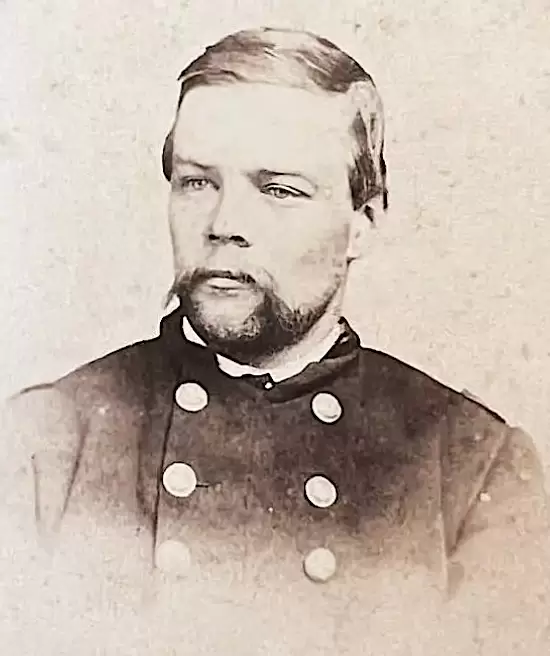
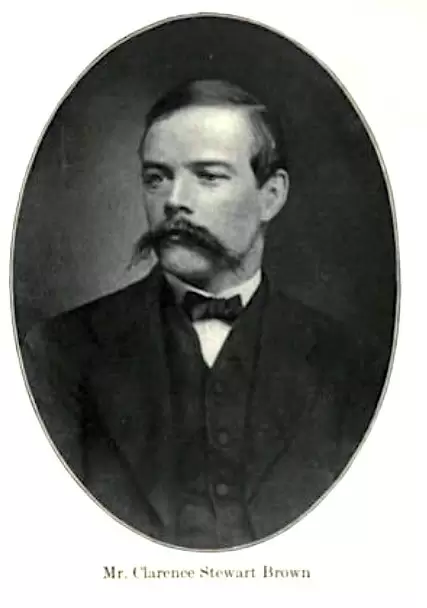
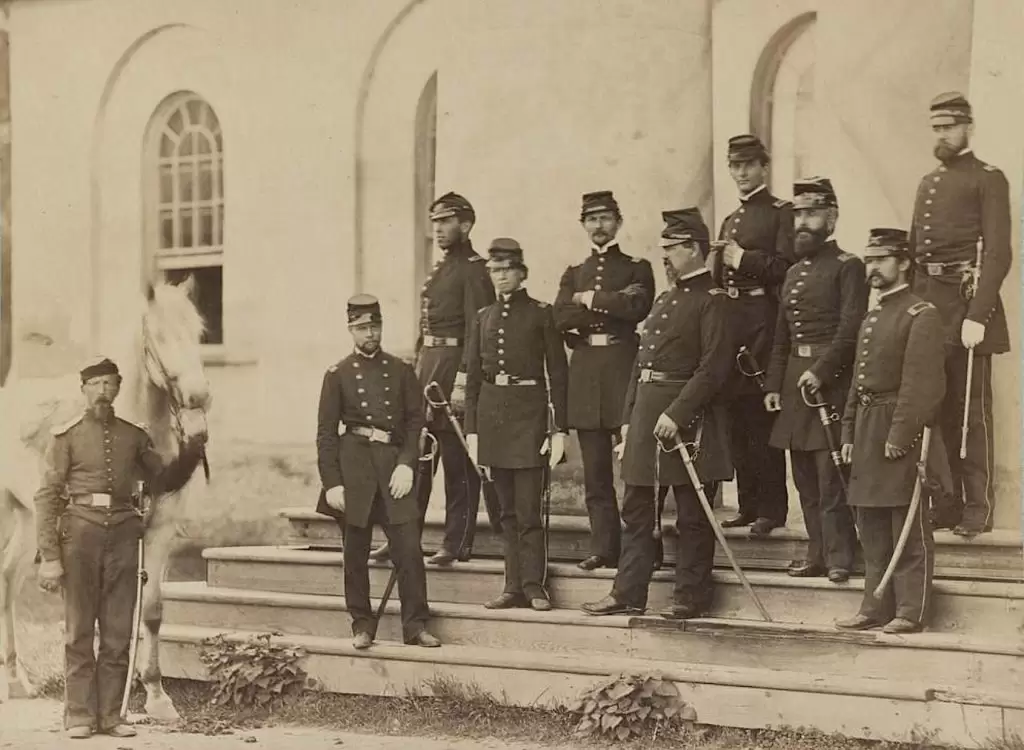
BROWN, DAVID W. (1843-1910). Private, 109th New York Infantry, Company H. A New York City native, Brown enlisted as a private at Binghamton, New York, on August 9, 1862, and mustered into the 109th New York five days later. He mustered out at Delaney House in Washington, D.C., on June 4, 1865.
In 1881, Brown applied for and received an invalid pension under certificate 639,867. A member of the G.A.R., an organization for Civil War veterans, his service in the 109th New York is confirmed in the G.A.R. Mortuary Tables. He last lived in Berkshire, New York. His death was caused by a cerebral hemorrhage. Section 194, lot 27565, grave 2.

BROWN, EDMUND (1818-1892). First class fireman, United States Navy. A native of New York City and an engineer by trade, Brown enlisted there on May 27, 1861, and mustered into the United States Navy as a first class fireman aboard the receiving ship North Carolina. At the time of his enrollment, he was 5′ 6″ tall with black eyes, dark hair and complexion. He saw service on the following vessels: the USS Roanoke from June 21, 1861-January 7, 1862; the USS Whitehead from January 8, 1861-March 7, 1862; and the USS Monitor as of March 8, 1862. He was at the Battle of Hampton Roads, Virginia, known familiarly as the Monitor vs. the Merrimack (CSS Virginia) on March 9, 1862, where he suffered from and was treated for “exposure.” Brown was moved to the United States Naval Hospital at the Washington Navy Yard, in Washington D.C., from which he was discharged on November 24, 1862, as “unfit for military service.”
Brown lived in Brooklyn after his discharge but was unable to work for a year and a half. In 1882, his first application for an invalid pension from the Navy was rejected but he and others soon submitted supporting documents to substantiate his claim. He attributed his lame leg and rheumatism to exposure while aboard the Monitor. In his letter to the Pension Bureau on April 13, 1883, Brown attests that he worked in a machine shop but on account of rheumatism in his hands, was employed as a watchman. A document from the Navy Department’s Bureau of Medicine and Surgery on April 14, 1883, confirms his service on the Roanoke and the Monitor and his treatment for rheumatism aboard those vessels (August 25-27, 1861, and September 13-15, 1861, aboard the Roanoke and November 10, 1862, aboard the Monitor). On February 14, 1888, his pension request was denied for “failure to establish claim.” On February 7, 1889, a fellow worker attested that he worked with Brown for 24 years for a ferry company during which time the aggrieved lost considerable time due to his rheumatism and, at present, could barely walk or do more than light labor. Brown’s pension was granted a few months before he died in 1892, certificate 7,224. He last resided at 298 Wycoff Street in Brooklyn. He died at the New York State Soldiers’ and Sailors’ Home in Bath, New York. His cause of death was gastritis. Section 13, lot 19694, grave 61.
BROWN, EMERY (1842-1896). Sergeant, 67th New York Infantry, Company G. A Brooklyn native, Brown enlisted on May 28, 1861, as a private. On June 20, he mustered into Company G of the 67th New York, was promoted to corporal on April 21, 1862, and rose to sergeant on April 14, 1863. He was discharged from military service at Brooklyn on July 4, 1864.
According to the census of 1880, Brown was a post office clerk. He last lived at 18 Fourth Avenue in Brooklyn. The cause of his death was asthenia (loss of strength and weakness). Section 72, lot 5016, grave 6.
BROWN, GEORGE (1839-1905). Unknown soldier history. He was a veteran and a member of the G.A.R., an organization for Civil War soldiers. He last lived at 309 15th Street in Brooklyn. Brown died from Bright’s disease. Section 191, lot 22799, grave 3.
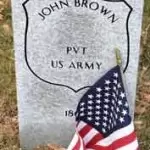
BROWN, JOHN (1818-1864). Unknown soldier history. Brown served in the Civil War but the details of his military record are not known. He died of an aneurysm at Bellevue Hospital. Section 115, lot 13536 (Soldiers’ Lot), grave 108.
BROWN, JOHN S. (1838-1899). First lieutenant, 50th New York Engineers, Company A. After enlisting as a private on November 25, 1861, at Penn Yan, New York, he mustered into the 50th New York Engineers on January 3, 1862. He was promoted to corporal on March 1, 1862, and then promoted to sergeant on or about June 1, 1863. On January 4, 1864, he re-enlisted as a sergeant, returned to the same regiment and company, was promoted to first lieutenant on March 24, 1865, and mustered out on June 13, 1865, at Fort Barry, Virginia. He mustered into the G.A.R. on September 17, 1895. His last residence was 199 Washington Street in Manhattan. Brown died from glycosuria (glucose in the urine). Section 13, lot 19694, grave 60.
BROWN, JOHN S. (1849-1891). Sergeant, 1st North Carolina Colored Infantry; 35th United States Colored Infantry (USCT). An African-American born in South Carolina, and a graduate of Claflin University at Orangeburg, South Carolina, a historically black college, Brown enlisted in 1863 in the 1st North Carolina Colored Infantry, a Union regiment. The regiment was reorganized on February 8, 1864, and given a new designation as the 35th U.S. Colored Troops. The troop was composed primarily of former slaves from Virginia and South Carolina and the officers were white northerners. The 35th USCT was commanded by James Beecher, the brother of Harriet Beecher Stowe and Henry Ward Beecher (see).
Brown, a corporal, served in Florida in 1864 and on February 20 saw action there at the Battle of Olustee; later that year he served in South Carolina and fought in the Battle of Honey Hill on November 30. Returning to duty in Jacksonville, Florida, he remained there until March 1865, when he was ordered to Charleston, South Carolina, where he served at various locations in the Department of the South until June, 1866. He mustered out with the rank of sergeant on June 1, 1866.
According to his obituary in The New York Times, he taught in the public schools of Graham, North Carolina, and then was Deputy Clerk of the Charleston Custom House under President Grant. In 1884, Brown was ordained a minister, serving as pastor of the Bridge Street African Methodist Episcopal Church in Brooklyn starting in 1889. His name is displayed on the African American Civil War Monument in Washington, D.C., plaque B-50. He last resided at 17 Rockwell Place in Brooklyn. He died from heart disease. Section 5, lot 88.
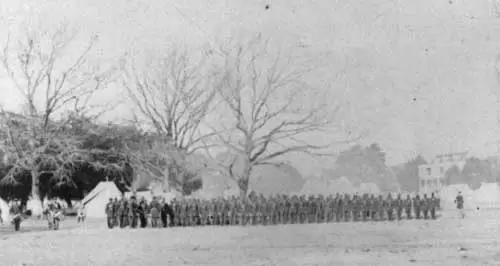
BROWN, JOHN T. (1819-1869). Private, 33rd New York Infantry. Brown, who was born in New Hampshire, enlisted and mustered into the 33rd at Rochester, New York, on August 30, 1862. No company was assigned. Other details of his service are not specified. Brown last resided at 58 Vandam Street in Manhattan. His death was caused by apoplexy. Section 74, lot 1481.
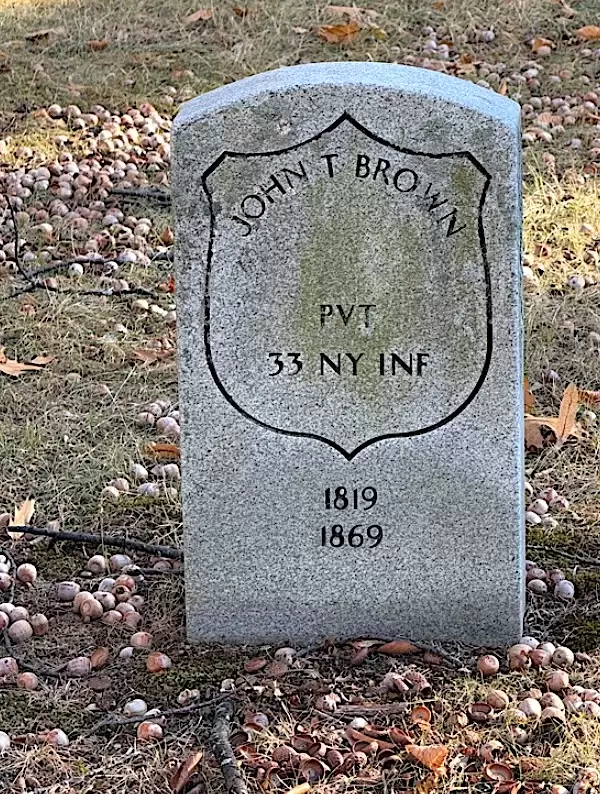
BROWN, JOSEPH (1808-1874). Private, 18th Massachusetts Infantry, Company C. Brown was born in Dudley in the West Midlands, England. After immigrating to the United States in an unknown year, he married Sarah Holmes McDonough in New York City on March 18, 1853; the Browns had three children.
Although 53, Brown served in the Civil War by lying about his age; the maximum age for enrollees was 45. An iron founder (caster of iron) living Boston, Massachusetts, he was recruited in nearby Cambridge on December 27, 1861, and mustered into Company C of the 18th Massachusetts as a private on January 14, 1862. As per his muster roll, he was 5′ 9¾” tall with dark eyes, light hair and a light complexion. His regiment was engaged in the Peninsula Campaign and fought at the Siege of Yorktown and the Battle of Second Bull Run, Virginia. At Second Bull Run, on August 30, 1862, Brown sustained a gunshot wound to his face, resulting in the loss of his right eye. He was subsequently admitted to the United States General Hospital at Newark, New Jersey, on November 11, 1862, then discharged for disability due to blindness of his right eye at New York City on November 28, 1862.
On June 28, 1863, Brown’s application for an invalid pension was granted under certificate 15,775; he received payments of $7.00 per month. He last lived at 887 First Avenue in Manhattan. His death was caused by phthisis (tuberculosis). Although Sarah Brown applied for a pension, application 338,648, her claim was denied because her husband’s death was deemed as not attributable to wounds received during the war. Section A, lot 16610, grave 43.
BROWN, LEANDER L. (or T.) (1841-1896). Private, 5th New York Infantry, Company G. Brown was born in Yonkers, New York. Although soldier records show a birth year of 1841, his death certificate records 1838 (which apparently is incorrect). As per the 1855 New York State census and the 1860 census, he was living in New York City with his parents and siblings; in 1860, he was single and working as a clerk whose personal estate was valued at $500.
During the Civil War, he enlisted as a private on August 12, 1862, at New York City and mustered into the 5th New York Infantry that same day. As per his muster roll, he was a clerk who was 5′ 8½” tall with dark brown eyes, dark hair and a dark complexion. He was wounded through the right shoulder and right forearm at the Battle of Second Bull Run, Virginia, on August 30, 1862, and discharged for disability (inability to raise his arm) on December 18, 1862, at Philadelphia, Pennsylvania. As per his draft registration records, from July 1863, he was single and worked as a clerk.
In 1875, he was living in Brooklyn with his wife Mary; by 1876, the couple had three children, Harvey, Roth and Carrie. The 1878 New York City Directory reports that he was a driver; the street address listed for him is 83 Horatio Street. The 1880 census reports that he was living in Brooklyn with his mother, wife and children, and was employed as a store clerk. He last lived at 83 Horatio Street in New York City. His death was attributed to apoplexy. Section 17, lot 17245, grave 1236.
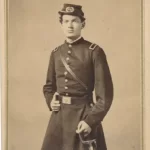
BROWN, MILNOR (1839-1863). Second lieutenant, 124th New York Infantry, Company I; private, 7th Regiment, New York State National Guard, Company K. After enlisting in April 1862, Brown served in the 7th Regiment when it was activated for three months in 1862, from May 25-September 5. The 7th Regiment was assigned to guard duty in Baltimore, Maryland. At some point after returning home, he was assigned to the staff of General Harvey Brown, commander of the New York State Militia. Beginning in August 1862, he was active in recruiting for Willard’s Light Artillery and was stationed at Governors Island and Fort Schuyler in New York Harbor but he then re-enlisted as a second lieutenant at Albany, New York, on December 30, 1862, and was immediately commissioned into the 124th New York. Although he was first seen as an interloper in that regiment because one of its own sergeants had not been chosen to command the company, he was soon accepted because of his devotion to his duty and responsibilities. He served as aide-de-camp on the staff of Brigadier General James Bowen and sailed with him to New Orleans, Louisiana, on January 6, 1863. He rejoined his company that summer and commanded it at Gettysburg, Pennsylvania, where he was killed by a shot to his forehead on July 2, 1863, at Houck’s Ridge. His remains were escorted to Green-Wood by members of Company K of the 7th Regiment on October 10, 1863. Section 22, lot 2141.
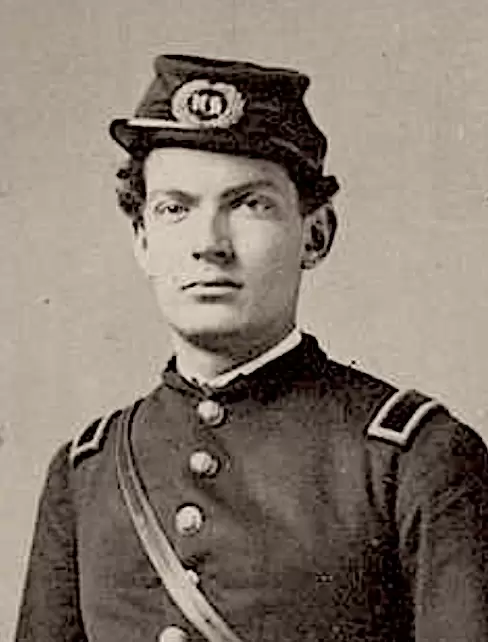
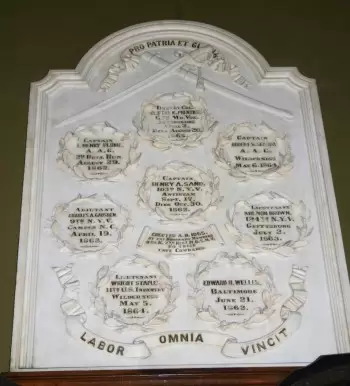
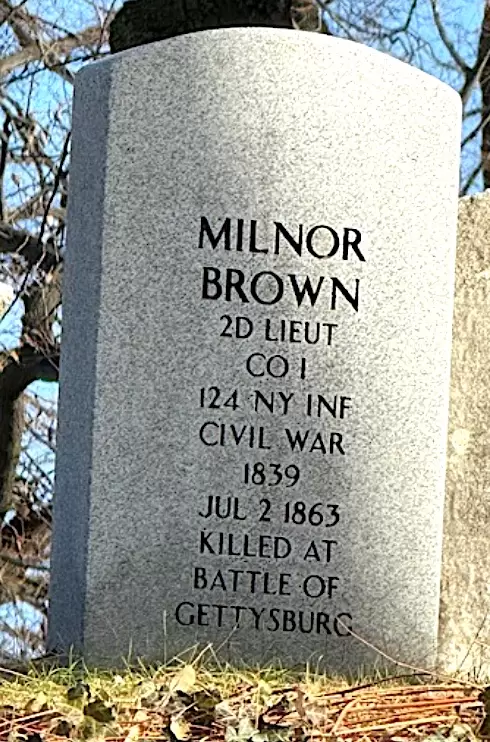
BROWN, OLIVER E. (1849-1932). Private, 1st New Jersey Cavalry, Company E. A New York City native, he enlisted and mustered into the 1st New Jersey Cavalry on September 10, 1864, and mustered out on May 31, 1865, at Cloud’s Mills, Virginia. According to his obituary in The New York Times, “…Brown, then 14 years old succeeded in enlisting in Company E of the First New York Cavalry by representing his age as 19.”
He played professional baseball on the Atlantics, a team that once was famous in Brooklyn. In 1892, he applied for and received an invalid pension, certificate 955,491. Brown last resided at 1139 46th Street in Brooklyn. His death was attributed to heart disease. Section 12, lot 9361.
BROWN, ROBERT (1821-1866). Captain, 89th New York Infantry, Company F. A native of New York, Brown enlisted at Whitney’s Point, New York, on October 4, 1861. On December 18, 1861, he was commissioned into Company F of the 89th New York as a captain. He was discharged on September 28, 1862, and re-enlisted on November 7. He was again immediately commissioned captain and served in Company F of the 89th until his discharge on October 19, 1864. He last lived on 84th Street in New York City. Section 169, lot 14130.
BROWN, SAMUEL (?-?). Private, 82nd New York Infantry, Company I. He enlisted and mustered into the 82nd New York on February 21, 1862, at New York City, and was discharged for disability on July 28, 1862, at Alexandria, Virginia. Section ?, lot ?.
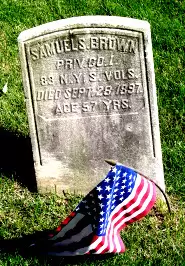
BROWN, SAMUEL STOCKTON (1840-1897). Private, 83rd New York Infantry, Company L; 2nd Battalion, Veteran Reserve Corps. A native of New York City, Brown enlisted at Washington, D.C., as a private on September 4, 1861, and mustered immediately into the 83rd New York. During his service, he saw action at many of the major battles of the War including: Second Bull Run, Virginia; Antietam, Maryland; Fredericksburg, Virginia; Chancellorsville, Virginia; and Gettysburg, Pennsylvania. At some point, he was hospitalized in Frederick, Maryland. He was transferred into the Veteran Reserve Corps on February 14, 1864, due to rheumatism, and was discharged at Baltimore, Maryland, on September 12 of that year.
In the Harry Lee G.A.R. Sketch Book, Brown noted, “The main event of the War was aiding in bursting the shackles from 4,000,000 slaves.” In addition, he noted the pride he felt in continuing his fellowship with fellow veterans in the G.A.R. and listed as his intimate comrades the following men: Chester Southworth, James Ralston, Henry Rogers, and Charles Thompson. He last resided at 393 Keap Street, Brooklyn. His death was attributed to heart valve disease. Section 137, lot 29879.
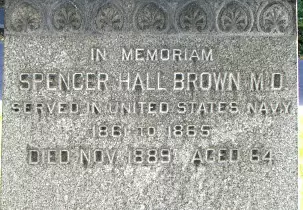
BROWN, SPENCER HALL (1825-1889). Assistant surgeon, 2nd New York Heavy Artillery; United States Navy. A native of New York City, Brown was a graduate of the Columbia College of Physicians and Surgeons, class of 1847. A surgeon at the time of his enlistment, he was 5′ 10″ tall with blue eyes, brown hair and a light complexion. He enlisted as an assistant surgeon at New York City on October 21, 1861, and was commissioned into the Field and Staff of the 2nd New York Heavy Artillery on December 4, 1861, with rank from October 23.
Although Brown was commissioned into the 2nd New York, he never mustered into the regiment but instead, during the time that he came home on sick leave, as per his widow’s report for the 1890 Veterans Census, enlisted and served in the United States Navy. According to an article in The New York Times on January 4, 1862, he was the acting assistant surgeon when the USS Sumter left the Brooklyn Navy Yard that day. His service, from 1861-1865, is confirmed by an inscription on his tombstone. As per the Veterans Census of 1890, he was the surgeon on the USS Memphis and the USS Sumpter (sic). In addition, he was commended by Commander William E. LeRoy in his report from Port Royal, South Carolina, on January 31, 1863, for his attention to caring for the wounded after LeRoy’s ship, the Keystone State, was rammed, took on water, and had many killed and wounded including the ship’s surgeon. Brown, who was the acting assistant surgeon on the Memphis, came to damaged vessel to render assistance to the injured.
He is likely the Spencer H. Brown who is listed as a physician in the New York City Directory for 1877. He last lived at 151 East 34th Street in Manhattan. He died from nephritis. Section 79, lot 722.
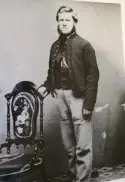
BROWN, THEODORE (1846-1920). Private, 5th New York Heavy Artillery, Company H. A native of Brooklyn, Brown enlisted there on December 26, 1863, and mustered into the 5th New York Heavy Artillery that day. He was taken as a prisoner of war on October 19, 1864, at Cedar Creek, Virginia. According to a descendant, he accepted a Confederate offer to work in a Confederate prison to gain his release. He mustered out on June 10, 1865, at Harpers Ferry, West Virginia. His last address was 247 Bainbridge Street in Brooklyn. Brown died from nephritis. Section 164, lot 16076.
BROWN, WILLIAM C. (1842-1864). Sergeant, 51st New York Infantry, Company G. Of English birth, he enlisted as a private at Brooklyn on September 5, 1861, mustered into the 51st five days later, and was promoted to corporal on October 16, 1862. After re-enlisting on December 1, 1863, he was promoted to sergeant on April 30, 1864, wounded at Wilderness, Virginia, on May 6, 1864, and succumbed to his wounds on July 11, 1864, at Alexandria, Virginia. Section 115, lot 13536 (Soldiers’ Lot), grave 89.
BROWN, WILLIAM H. (1831-1891). Private, 7th Regiment, New York State Militia, Company H. Originally from Boston, Massachusetts, he was employed in the publishing business there and was also a treasurer for the Vermont Central Railroad. After moving to New York City, he worked in the advertising department of Harper Brothers, a book publisher.
During the Civil War, Brown enlisted as a private in 1861 and served with the 7th New York State Militia when it was activated that year for 30 days. After the War, he worked for the government in the manufacture of postage stamps and then became a confidential clerk. His last address was 19 Christopher Street in Manhattan where he died from a fall. Section 52, lot 9374.
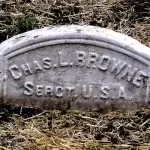
BROWNE, CHARLES L. (1834-1895). Sergeant, United States Army. The details of Browne’s service are unknown. He enlisted as a sergeant and mustered into the United States Army General Service. His military service is inscribed on his gravestone. Section 89, lot 4323, grave 3.
BROWNE, THOMAS (1820-1880). Captain, 162nd New York Infantry, Company I. Originally from Maine, he enlisted at New York City as a captain on August 29, 1862, at age 41. On October 18, he was commissioned into the 162nd New York from which he was dismissed on February 10, 1863, a dismissal that was revoked. His discharge date was April 1, 1863. His last residence was 208 7th Street in Brooklyn. Browne died from enteritis. Section 15, lot 17263, grave 1276.
BROWNE, WILLIAM BLESSINGTON (1826-1919). Acting ensign, United States Navy. Born in New London, Connecticut, he was the son of a Navy captain. According to his pension record, he enlisted as a seaman in 1862, was assigned to the USS Gemsbok and the USS North Carolina, and was discharged as an acting ensign. Further details are unknown. As per his obituary in the New York Tribune, he participated in the Battle of Mobile Bay, Alabama, under Admiral David Farragut during the Civil War.
Following the war, he was a dealer in oils on Maiden Lane in Manhattan then became interested in real estate. Although he was referred to as Captain Browne in his obituary, it is unclear how he obtained that title. Browne applied for and received a pension from the Navy under certificate 3,847. He last resided at 55 Brooklyn Avenue in Brooklyn. His death was attributed to apoplexy. Annie Browne, who is interred with him, applied for and was awarded a widow’s pension, certificate 875,319. Section 196, lot 31789.
BROWNE, WILLIAM E. F. (enlisted as BROWN, FRANK) (1844-1916). First lieutenant, 113th Illinois Infantry, Company G. Born in New York City, he enlisted as Frank Brown at Chicago, Illinois, on October 1, 1862, as a first lieutenant. On that date, he was commissioned into the 113th Illinois where he served until he resigned his commission on January 13, 1863. Although his obituary in The New York Times indicates that he was confined in Andersonville Prison for several months, Andersonville did not open until February 1864, more than a year after his discharge from service.
After the Civil War, Browne was in the hotel business in Chicago but lost everything in the infamous fire there in 1871. A resident of Brooklyn for the last 29 years of his life, he was employed in the real estate business. He last lived at 1227 Fulton Street in Brooklyn. His death was attributed to apoplexy. Section 175, lot 17638, grave 6.
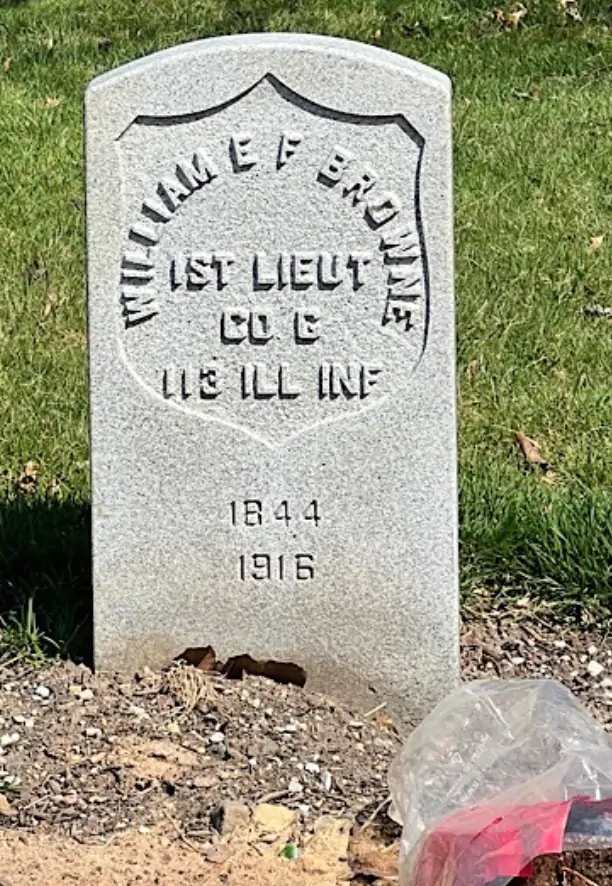
BRUEN, CHARLES T. (1840-1879). First lieutenant, 10th New York Light Artillery. Bruen was originally from the Kingdom of Württemberg, Germany. After enlisting as a first lieutenant at Maryland, New York, on December 15, 1861, Bruen was commissioned into the 10th New York Light Artillery on March 4, 1862. His unit was first sent to Camp Barry in Washington, D.C. He was dismissed and dishonorably discharged on August 18, 1864, by sentence of a general court-martial. As per his muster roll, Bruen was tried for and found guilty of “contemptuous and disrespectful language toward the President of the United States.” In addition, the muster roll notes that he temporarily served with the 5th Independent Battery while he was charged and awaiting trial.
On October 27, 1866, Bruen became a naturalized citizen at the Kings County Court. The 1868 Brooklyn Directory reports that he was a machinist. He is listed in the 1879 Brooklyn Directory with an address of 119 Bergen Street. He died at the County Asylum in Long island. His death was caused by asthenia (decreased muscle strength). His remains were moved to its current location on March 30, 1883. Section 147, lot 23540, grave 423.
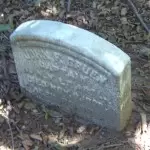
BRUEN, JOHN FRANKLIN (1846-1887). Bugler, 10th New York Light Artillery; Veteran Reserve Corps, 104th Company. After enlisting as a private at Maryland, New York, on December 15, 1861, the Brooklyn native mustered into the 10th New York Light Artillery on March 18, 1862. During his service he was promoted to bugler on February 28, 1863. On November 28, 1863, he was transferred into the 104th Company of the Veteran Reserve Corps. He likely was the son of John T. Bruen (see). He last lived in Rutherford, New Jersey. His death was caused by a gunshot wound to the chest. In 1904, his widow, Martha J. Grimshaw, applied for a pension, application 817,853. Section 147, lot 23540.
BRUEN, JOHN T. (1818-1898). Captain, 71st New York Infantry, Company I; 10th New York Light Artillery. Of German birth, he enlisted on September 21, 1861, at Washington, D.C., was commissioned into the 71st on that date, and served until February 28, 1862. On March 26, 1862, he was commissioned into the 10th Light Artillery. He commanded the 10th Artillery at the Battle of Cedar Mountain, Virginia (August 9, 1862); Antietam, Maryland (September 17, 1862); and Fredericksburg, Virginia (December 1862). He was honorably discharged on June 4, 1863. He was likely the father of John Franklin Bruen (see). His last residence was 498 Third Avenue in Brooklyn. Bruen died from liver disease. Section 147, lot 23540.
BRUEN, MATTHIAS (or MATHIAS) (1830-1890). Private, 84th Regiment, New York State National Guard, Company K. Bruen served for 30 days in 1863 with the 84th National Guard. He last lived at 68 West 106th Street in Manhattan. His death was attributed to Bright’s disease. Section 6, lot 20118, grave 956.

BRÜENINGHAUSEN (or BRÜNINGHAUSEN), EDWARD WASHINGTON (1844-1924). Major by brevet; captain, 58th New York Infantry, Company D; first lieutenant, 119th New York Infantry, Company G. A native of Brooklyn, and a merchant by trade, Brüeninghausen had dark hair and black eyes. After he enlisted at New York City on August 27, 1862, he was commissioned into the 119th New York the next month on September 10. During his service with the 119th, he was an ordnance officer with the Second Brigade and an acting commissary of subsistence, acting aide-de-camp on the staff of Brevet Brigadier General W. Krzyzanowski (see), and acting provost marshal. Upon his promotion to captain on December 11, 1863, he was discharged and immediately commissioned into the 58th New York. On March 13, 1865, he was brevetted to major “for gallant and meritorious service during the War.” He mustered out at Nashville, Tennessee, on October 1, 1865.
In 1873, Brüeninghausen applied for and was granted an invalid pension, certificate 128,099. In his affidavit, he stated that he suffered from and was treated for rheumatism, as well as cataracts from severe eye infections, resulting from the hardship and exposure of the Fredericksburg Campaign (Virginia) on or about December 18, 1862. He subsequently lost the sight of his left eye and the sight of the right was blurred so that he could no longer work as a clerk. He had not been treated in hospital, but by his father, Charles Brüeninghausen, M.D., then surgeon of the 119th and medical inspector on the staff of General Sigel.
Brüeninghausen is listed in the New York City Directory for 1882-1883 as working in frames on Bond Street in Manhattan. In 1912, he applied for an increased pension on grounds of age under the new pension law of that year. Although he resided in Brooklyn after the Civil War, his last residence was at Wallace Lodge, Park Hill, in Yonkers, New York. His death was caused by bronchial pneumonia. In 1924, Adele Brüeninghausen, who is interred with him, applied for and received a widow’s pension, certificate 951,358. Section 131, lot 36170, grave 1.
BRUEY, JR., FRANCIS EDWARD (1843-1922). Landsman, United States Navy. He was born in Elizabethtown, New Jersey, to parents Francis Felix Bruey and Mary Frances Hinriot Bruey, both of whom were from France. Francis worked as a boilermaker until his enlistment in the United States Navy in 1863. At that time, he was described in Navy records at 5′ 7 ½” tall, with dark brown hair and a dark complexion. He served as a landsman on the USS Pawnee, USS John Adams, USS Princeton, and USS North Carolina, according to his Civil War Pension Index Card, before completing his Naval service in 1864.
Returning to civilian life, Bruey married Hester Jane Williams, and they started a family in New York, where he worked as a policeman. By 1880, the United States federal census recorded that he was living in Archbald, Lackawanna, Pennsylvania; he had returned to New York by 1905. Francis shifted into work as a gardener, and continued to work for the Parks Department until his retirement. As per his obituary in the Brooklyn Eagle, he was a Mason and a member of the Gouverneur K. Warren Post #286 of the Grand Army of the Republic, a fraternal organization for veterans of the Civil War. William Bruey (see), his brother, also served in the Navy and was a member of the same G.A.R. Post. His obituary also confirms his Civil War service.
According to New York City’s Index to Death Certificates, Bruey died on January 11, 1922, from cerebral apoplexy and arteriosclerosis. He was survived by his wife and four children– John, Mamie, Elvira, and Ellen– and at least one grandson. His last residence, and where he had resided for at least a decade prior, was 876 Herkimer Street, Brooklyn. Soon after his death, his wife applied for a widow’s pension; it was certified, 915,464. Section L, lot 18696.
BRUEY, WILLIAM H. (or E.) (1845-1919). Seaman, United States Navy. Born in Woodbridge, New Jersey, Bruey was 5′ 8″ tall with a light complexion, blue eyes, and light brown hair. After he enlisted at New York City as a landsman on May 15, 1861, he entered service in the United States Navy on May 28. He served on board the following vessels before his discharge as a seaman at Philadelphia, Pennsylvania, on June 24, 1864: USS North Carolina, USS Wabash, and the USS New Ironsides.
After the War, Bruey was a carpenter and a member of the Gouverneur K. Warren Post #286 of the G.A.R., whose records noted details of his military service. The Brooklyn Directory for 1873-1876 lists him as a builder living at 83 4th Place. Bruey was granted a pension from the Navy, certificate 29,573. As per his obituary in the Brooklyn Standard Union, which confirms his Civil War service and G.A.R. membership, he was a member of Carpenters’ Local 808 and was a lifelong Brooklyn resident; other records note a New Jersey birth. His last residence was 448 Bergen Street, Brooklyn. He died from chronic interstitial nephritis. He was survived by his brother, Francis (see), who also served in the Navy during the Civil War.. Section L, lot 18696, grave 4.
BRUMLEY, JAMES LANHAM (1827-1894). Private, 7th Regiment, New York State National Guard State, Company B. Brumley was born in Lebanon, Connecticut. On June 5, 1848, he married Margaret Ann Sniffen in New York City; the couple had seven children. He is listed as a merchant in the Brooklyn Directory for 1858 living on Clermont Avenue. He was a partner in a large dry-goods commission business, Brumley and Kellogg.
After enlisting as a private at New York City on April 19, 1861, Brumley mustered into service and served in Company B of the 7th Regiment for 30 days. He is still listed as a merchant in the Brooklyn Directories for 1863 and 1864, living at the same home address. His name appears as a merchant in the Brooklyn Directories for 1864, 1865, and 1867-1870; in the latter directory, he lived at 319 Washington Avenue. In his obituary, veterans of his company were invited to attend his funeral. His last residence was 445 Washington Avenue in Brooklyn. Brumley’s cause of death was listed as “congest chill.” Section 105, lot 8767, grave 6.
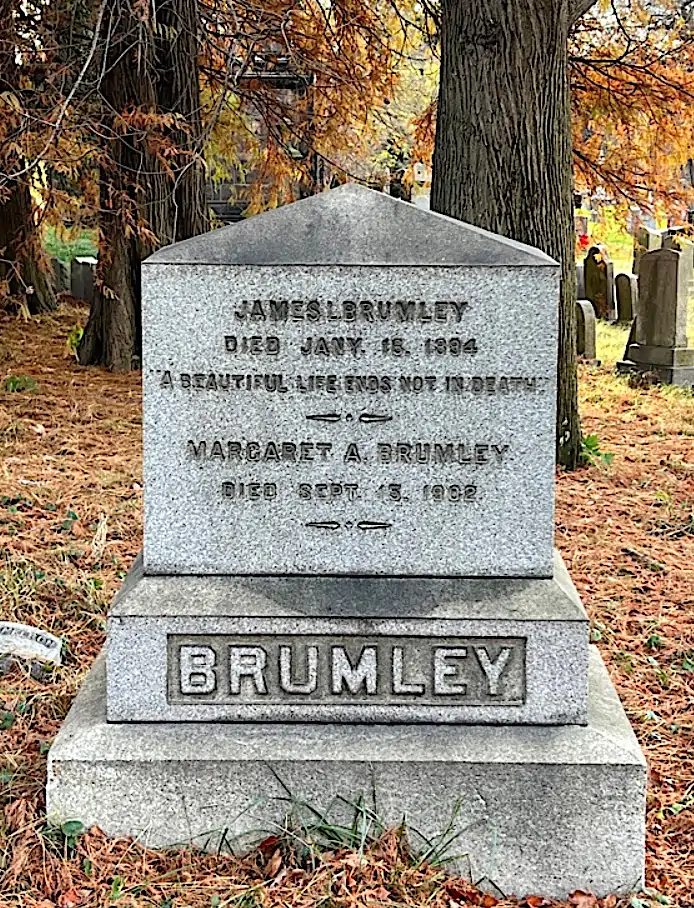
BRUNER (or BRUNNER), DANIEL A. (1835-1897). Sergeant, Pennsylvania National Guard Infantry, Company H; private, 19th Pennsylvania Infantry, Company H; 200th Pennsylvania Infantry, Company B. Bruner was born in Pennsylvania. He is listed as a bookbinder in the Philadelphia Directory for 1861. On May 18, 1861, he enlisted as a private at Philadelphia and mustered into the 19th Pennsylvania Infantry. He mustered out three months later on August 29, 1861, at Philadelphia. On September 11, 1862, he re-enlisted as a sergeant in the Pennsylvania National Guard Infantry and mustered out on September 22, 1862. On August 23, 1864, he re-enlisted at Philadelphia as a private, and mustered into the 200th Pennsylvania from which he was discharged on an unknown date.
Bruner relocated to Brooklyn after the Civil War. He is listed as working in books in the Brooklyn Directory for 1870-1873 and as a bookbinder in the Brooklyn Directories for 1885-1886 and 1890-1892; in 1890, he lived at 396 Douglass Street. In 1894, he filed for and received a pension, certificate 895,988. His last residence was at 283 6th Street in Brooklyn. Shortly after his death from heart disease in 1897, his widow applied for a pension, application 647,636. Remarks on Brunner’s pension record indicate that his widow may have received a widow’s pension from her former spouse William H. Marshall, who served in the 47th New York Infantry and Navy, certificate 938,675. According to a descendant, the alternate spelling, Brunner, on the Green-Wood records, is incorrect. Section 135, lot 27263, grave 2493.
BRÜNNER, PETER (1828-1866). Corporal, 17th Regiment, New York State National Guard, Company E. Of French origin, he served for 30 days when the 17th Regiment was activated in 1863. His last address was 36 Forsyth Street in Manhattan. Section B, lot 11005, grave 408.
BRUSH, CLINTON ETHELBERT (1844-1905). Private, 22nd Regiment, New York State National Guard, Company C; 71st Regiment, New York State National Guard, Company B. Brush, who was born in New York City and whose American roots can be traced back to the “old Hollanders” on his mother’s side, attended the Free Academy, now known as the College of the City of New York. In 1861, he left school in his junior year to join a wholesale trimming business as a clerk.
During the Civil War, Brown enlisted at New York City as a private on May 28, 1862, and mustered into the 22nd Regiment on that date. On June 15, he was listed as absent but returned to his unit on June 22 and mustered out of service three months later on September 5 at New York City. In 1863, he enlisted in Company B of the 71st New York National Guard for its 30-day activation and participated in the suppression of the New York City Draft Riots that year. He remained with the 71st until 1869, participated in all of its public events, and later became a member of the 71st Veterans Association.
In civilian life, Brush was a wholesaler of fancy goods. He is listed as working in fancy goods in the New York City Directories for 1875-1876 and 1877; the business was at 37 Walker Street in Manhattan and he lived in New Jersey. Successful in the business world, he opened a local office of his business in Toronto, Canada, in 1877, which soon became the largest importer of dress trimmings in that country. His fancy goods business is listed in the Phillips’ Business Directory for 1881-1882 as Clinton E. Brush & Bro. at 13 Lispenard Street in Manhattan. In 1885, he returned to New York City where he opened the East Coast branch of the Chicago Corset Company. The Brooklyn Directory for 1885-1886 lists him as the manager of his business on Lispenard Street; at that time, he lived in Orange, New Jersey. The 1891-1892 New York City Directory lists Clinton E. Brush & Brother as dealers in fancy goods at 15 Lispenard Street. His last residence was 175 Irving Avenue in South Orange, New Jersey. His cause of death was listed as “locomotor ataxia.” Section 89, lot 17671.
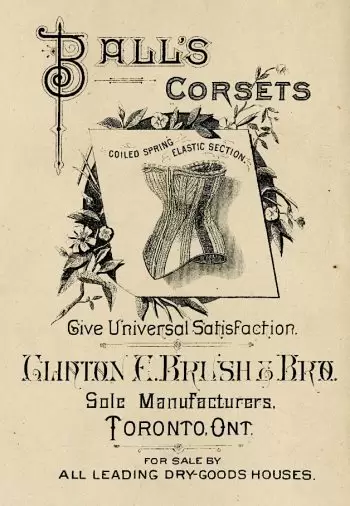
BRUYN, SYLVANUS MILLER (1840-1904). Private, 71st Regiment, New York State National Guard, Company C. Born in Ulster County, New York, Bruyn enlisted at Brooklyn as a private in 1863 and served with the 71st Regiment for 30 days. In 1890, he was employed as a superintendent. The 1891-1892 Brooklyn Directory lists him as working in dry-goods. At the time of his death from cancer, he lived at 367 Macon Street, Brooklyn. Section 205, lot 31726, grave 2.
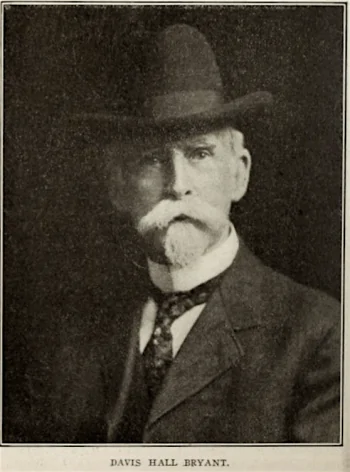
BRYANT, DAVIS HALL (1839-1914). Sergeant, 2nd Florida Cavalry, Companies K and B, Confederate States of America. Bryant was born in Savannah, Georgia; his parents were from prominent Massachusetts families whose lineages trace back to the American colonies. His mother’s grandfather, General Amasa Davis, was a captain in the Revolutionary Army and subsequently the quartermaster general of Massachusetts Commonwealth. Bryant’s obituary in the Brooklyn Daily Eagle, which confirms his service to the Confederate States of America, notes that he was first educated in Boston. The family then moved to Jacksonville, Florida, when he was young and where his family spent time on a country estate on the St. John’s River.
Although his family had strong roots in the North, Bryant loved the South and its customs and, at the onset of the Civil War, first served as a member of the Jacksonville Light Artillery. The dates of that service are not known. A resident of Welaka, Florida, and an accountant by profession, he later enlisted as a private at East Florida on May 16, 1862, and mustered immediately into Company K of the 2nd Florida Cavalry. He was 5′ 7″ tall with hazel eyes, brown hair and a light complexion. Bryant was promoted to corporal on December 1, 1862, and rose to sergeant on February 1, 1863. He was reduced to ranks on June 1, 1863, and transferred intra-regimentally to Company B on November 1, 1863. As per an obituary in Confederate Veteran Magazine (January 1915), he served as a scout and messenger and fought under Generals Joseph Finnegan and Patten Anderson. Bryant took part in the Battle of Olustee, Florida. He took the Oath of Allegiance to the United States on May 20, 1865, at Waldo, Florida.
After the war, Bryant relocated to New York City. In 1870, he was living in Manhattan; in 1880, he was living in Rahway, New Jersey. As per the New York City Directories for 1875-1876 and 1876-1878, he worked as a clerk at 426 Broadway in Manhattan and lived in New Jersey. The New York City Directories for 1882-1883 and 1884-1885 list him as working in the lace business and living in Rahway. The 1891-1892 New York City Directory reports that he was a clerk at 502 Broadway in Manhattan and that he lived in New Jersey. Subsequently, Bryant lived in Brooklyn and after retiring from business in New York City, lived most of the year in Orlando, Florida. The census of 1900 states that he was living in Brooklyn; the census of 1910 reports that he was living in Orlando with his wife Lucy née Stiers (originally from North Carolina), to whom he had been married 60 years.
Bryant was a member of the Confederate Veterans Camp of New York and was anticipating a reunion with Jacksonville veterans at the time of his death. According to his obituary in the Confederate Veteran Magazine, “As a soldier he was plucky and steadfast, with the highest sense of honor, duty and fidelity. As a man he clung always to the finest ideals-a true gentleman of the old school, whose courtesy and courtly manner, whose fine temperament and rare magnetism, drew to him all, of high or low estate, with whom he came in contact…” He died in Orlando. He was survived by his widow, a married daughter and his brother. Section 197, lot 31413.
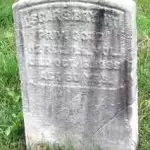
BRYANT, OSCAR S. (1839-1899). Private, 112th Illinois Infantry, Company D; Veteran Reserve Corps, 98th Company. A resident of Clover, Illinois, he enlisted on August 9, 1862, and mustered into the 112th Illinois Infantry on September 20. He was transferred into the 98th Infantry Company of the Veteran Reserve Corps on October 1, 1864. He mustered out on July 15, 1865. He last lived at 359 Kosciusko Street in Brooklyn. Bryant died from angina. Section 4, lot 21316, grave 189.
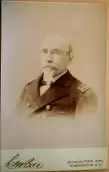
BRYSON, ANDREW (1822-1892). Commander, United States Navy. Bryson, a native of New York City, began his 43-year career in the Navy when he was commissioned as a midshipman on December 21, 1837. After he was attached to the sloop Ontario in the West Indies Squadron from 1838 through 1842, he was at the Philadelphia Naval School from 1842-43, and was promoted to passed midshipman on June 29, 1843. Attached to the sloop Decatur, he was off the coast of Africa from 1843-45, then on the steamer Michigan on the Great Lakes from 1845 into 1849, and on the store-ship Erie from 1850 until 1851. He was promoted to lieutenant on August 30, 1851, and returned to Africa on the Bainbridge from 1851-55. Bryson was aboard the Boston from 1853-55, the Saratoga in the Home Squadron from 1856-58, was attached to the Brazil Squadron 1858-59, and then assigned to the New York Navy Yard in 1861, where he was when the Civil War began.
After being promoted to commander on July 16, 1862, Bryson assumed command of the USS Chippewa on special service beginning in 1862 and into 1863. While at the helm of the ironclad USS Lehigh, he took part in the blockade of the South Atlantic including actions at Fort Macon, North Carolina, and off Charleston, South Carolina, from September 22, 1863 through April 5, 1864, suffering a minor shell wound during that engagement. In 1864 and 1865, he commanded the Essex, an ironclad, in the Mississippi Squadron.
Continuing his service after the Civil War, Bryson rose to captain on July 25, 1866, commanded the steamer Michigan on the Great Lakes 1866-69, and the Boston, a receiving-ship, in 1869, while performing duty at the Boston Navy Yard. He commanded the USS Brooklyn, a sloop-of-war, in the European Squadron from 1871 through 1872. On February 14, 1873, he was promoted to commander, was a member of the Board of Examiners in 1873, then was commandant of the Portsmouth Navy Yard at Kittery, Maine, from 1874 to 1877. He commanded the South Atlantic Squadron from 1879 through 1881, and was promoted to rear admiral on March 25, 1880, the position from which he retired on July 1, 1881.
He last lived at 1822 Massachusetts Avenue in Washington, D.C. His death was caused by ulcers of the stomach. His death and interment at the family vault in Green-Wood was announced in the New York Evening Post. He was survived by his widow, Charlotte Arnold Bryson, a married daughter and a son. Section 99, lot 11302.

BUCHAN, ROBERT C. (1839-1887). Sergeant, 7th Regiment, New York State National Guard, Company B; private, 1st Regiment, New York State National Guard, Company B. After serving as a private with the 7th Regiment’s State Militia for 30 days in 1861, Buchan served with the 1st Regiment, New York State National Guard, for three months in 1862. He returned to the 7th Regiment as a sergeant for 30 days in 1863. He last lived at 234 West 22nd Street in Manhattan. His death was attributed to alcoholism. Section 100, lot 1281.
BUCHANAN, BENJAMIN W. (1823-1893). Sergeant, 71st Regiment, New York State National Guard, Company A. Originally from Baltimore, Maryland, Buchanan enlisted as a sergeant at Newark, New Jersey, on May 28, 1862, and immediately mustered into the 71st New York National Guard. He mustered out three months later on September 2 at New York City.
The New York City Directory for 1877 lists Buchanan as a county court house officer; he lived at 264 Mercer Street. As per the census of 1880, he was a retired “Butcher Court Officer.” Although listed as retired in the 1880 census, he is still listed as a county court officer in the New York City Directories for 1882-1883, 1885-1886, and 1891-1892; his home as of 1885 was at 190 Wooster Street. He last lived at 108 Washington Place in New York City. Shortly after his death in 1893, Lydia Buchanan, who is interred with him, applied for and received a widow’s pension, certificate 384,809. Section 177, lot 13796, grave 2.

BUCHANAN, THOMAS (1843-1867). Private, 5th Independent Battery, New York Light Artillery. Originally from Ireland, Buchanan enlisted as a private at New York City on December 15, 1861, mustered into the 5th New York Light Artillery (company unknown) that day, and mustered out at the end of his term. After re-enlisting on January 1, 1864, he deserted from furlough on February 17, 1864. His last residence was 19 Congress Street in Brooklyn. Buchanan died from a hemorrhage. Section 114, lot 8999, grave 320.
BUCKBEE, OLIVER (1842-1866). Private, 25th New York Infantry, Company E. Born in New York State, Buckbee enlisted as a private on September 1, 1861, at New York City, and mustered into the 25th New York that day. He mustered out at Hall’s Hill, Virginia, on December 2, 1861. His last residence was 83 Forsyth Street in Manhattan where he died from consumption. Originally interred in lot 8999, grave 655, his remains were moved to the current site on October 16, 1867. Section 167, lot 17739.

BUCKE, WILLIAM H. (1837-1915). Major, 52nd Ohio Infantry, Company A. After enlisting as a first lieutenant on October 5, 1862, he was commissioned into the 52nd Ohio that day, and was promoted to captain three days later. On January 31, 1865, he was promoted to major but not mustered in that rank, and mustered out on June 3 of that year at Washington, D.C. He last lived at 248 East 23rd Street in Manhattan. The cause of Bucke’s death was cancer. Section 83, lot 20996.
BUCKEN, WILLIAM T. (1827-1869). Private, 7th Regiment, New York State Militia, Company B. In 1850, Bucken, a New York native, was working as a clerk. The 1857 New York City Directory lists him as a merchant at 160 Franklin Street.
During the Civil War, Bucken served as a private in the 7th Regiment when it was activated for thirty days in 1861- from April 19 through June 3. According to the 1868 New York City Directory, he was in the auction business. He last lived at 6 College Place in New York City. His death was attributed to phthisis (tuberculosis). Section 72, lot 9115.
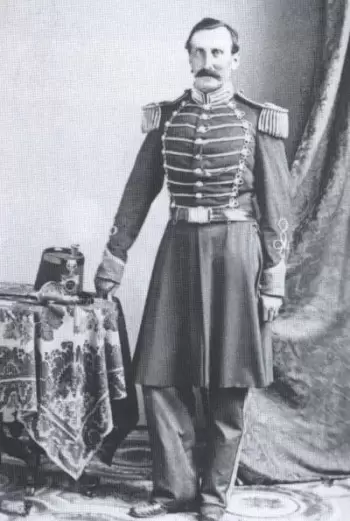
BUCKINGHAM, GEORGE ANDREW (1817-1882). Colonel, 53rd New York Infantry; 183rd New York Infantry; major, 71st Regiment, New York State Militia. As a young man, Buckingham moved from his native Connecticut to New York City and worked in the dry goods and auction trades. He was a member of the Volunteer Fire Department for 15 years, and defeated William H. Tweed in an election for school commissioner around 1850. He enlisted on April 19, 1861, in the 71st Militia as its major, was commissioned into its Field and Staff on May 3, 1861, and fought on July 21 at the first Battle of Bull Run, Virginia. He mustered out with the 71st on July 31, 1861, at New York City.
Buckingham was one of several officers who were authorized by the War Department, in August of 1861, to recruit the Eagle (Scrogg’s) Brigade. As a result, he was appointed on July 4, 1862, as lieutenant colonel of the 53rd New York Infantry (second organization), but that regiment, when recruiting lagged, was soon consolidated with the 132nd and 162nd Regiments. In March 1864, Buckingham was authorized to recruit the 183rd Regiment, as its colonel. However, that authority was revoked in August of that year.
He was a War Democrat and a nativist. Following the Civil War, he pursued a career as a Wall Street broker in gold and foreign currencies and was active in the Native American Party. Buckingham is listed as a broker at 65 Wall Street in the 1876-1878 New York City Directory. He then lived at 341 East 119th Street. He is also listed as a broker at 64 Wall Street in the 1891-1992 New York City Directory; he lived at 406 East 118th Street which was his last address. Both of his sons, George, Jr. (see) and Charles E., served in the Union Army. His death was attributed to pneumonia. Initially interred in another New York City cemetery (St. Michael’s Cemetery), he was removed to Green-Wood on November 10, 1883, almost two years after his death. Section 73, lot 1171.
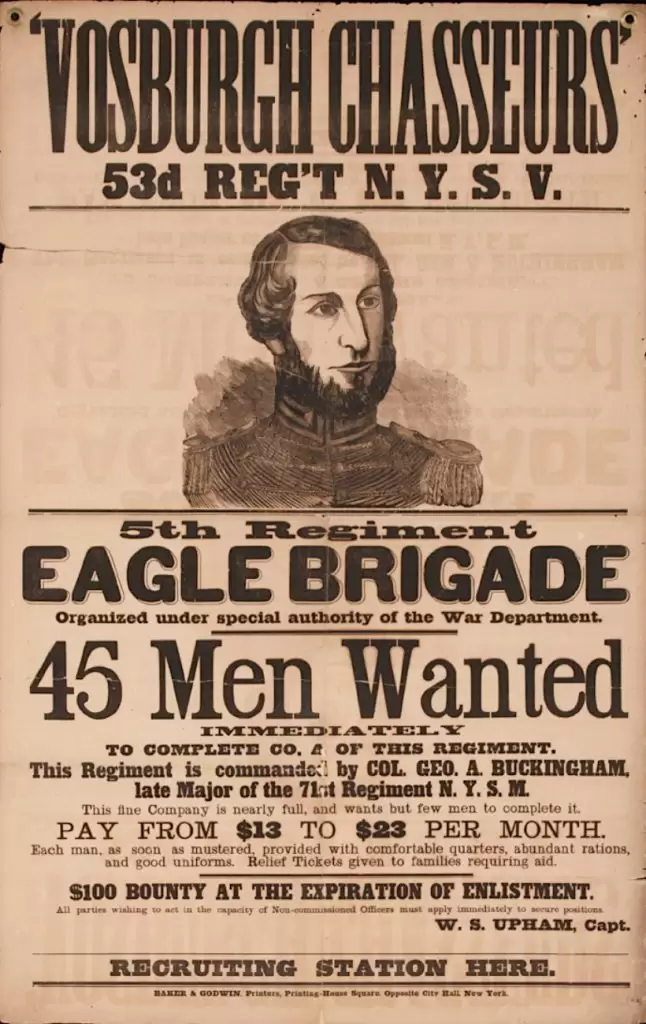
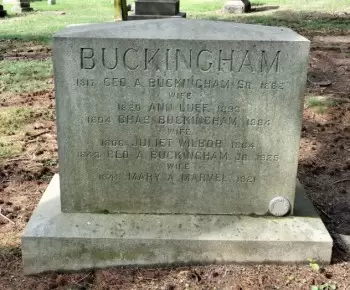
BUCKINGHAM, JR., GEORGE ANDREW (1843-1925). Second lieutenant, 13th New York Provisional Cavalry, Company L; 3rd New York Cavalry, Company K. A native of Tappan, New York, Buckingham was living in New York City when he enlisted there as a private on February 25, 1864, and mustered into the 13th New York Cavalry that day. He was promoted to command sergeant on March 15, 1864, and to second lieutenant on November 17 of that year. On August 17, 1865, he transferred into Company K of the 3rd New York Provisional Cavalry, and mustered out a month later on September 21 at Camp Barry, Washington, D.C. His father, George A. Buckingham (see), was a Union colonel. His brother, Charles, also served in the Union forces.
After the war, Buckingham lived in Manhattan, Astoria, and Tappan, New York. As per the 1876-1878 New York City Directory, he was a surveyor; he lived with his father at 341 East 119th Street. A civil engineer, he served as paymaster, yeoman 3rd class in the U.S. Navy, on the survey steamer Arago from April 1 through April 30, 1881, when he was honorably discharged. According to the 1891-1892 New York City Directory, he was a surveyor at 64 Wall Street, the same address where his father was a broker; he lived on Long Island. He applied for a disability pension in 1906, certificate 1,129,733. His last residence was in Tappan, New York. Buckingham died from chronic nephritis. Section 73, lot 1171.
BUCKINGHAM, GEORGE W. (1829-?). Sergeant, 53rd New York Infantry, Company H; 85th New York Infantry, Company I; Veteran Infantry. Born in New York City, Buckingham enlisted there as a private on September 11, 1861, mustered into the 53rd New York (first organization), was promoted to sergeant at some point, and was discharged on March 20, 1862, at Washington, D.C., by order of the War Department when his regiment was disbanded. He re-enlisted as a private at New York City on April 1, 1862, mustered into the 85th New York, and fought on April 17-May 4, 1862, in the siege of Yorktown, Virginia, before being promoted to sergeant on May 10. On May 31, 1862, Buckingham fought at Fair Oaks, Virginia, and was wounded in the shoulder by a shell. Returning to action, he was at the Seven Days Battle, Virginia, from June 25-July 2 of that year. He joined the Veteran Infantry on January 1, 1864, was captured at Plymouth, North Carolina, on April 20, released on an unstated date, and transferred into the 61st New York on July 6, at Plymouth when he was promoted to first lieutenant, but never mustered. After the War, he was a member of the Henry M. Lee Post #21 of the G.A.R. Section ?, lot ?.
BUCKINGHAM, NATHAN N. (1830-1864). Second assistant engineer, United States Navy. Originally from Connecticut, he enlisted as a second assistant engineer on May 17, 1861, served in the U.S. Navy aboard the USS Huntsville and was transferred to the USS De Soto in January 1864. While awaiting orders at the Portsmouth Navy Yard on June 20, 1864, he died of typhoid fever on June 29, 1864. He last lived at 18 Sixth Avenue in Manhattan. His minor children, Ellen, Elbert, and Emma Buckingham, received a pension of $10 a month from the Navy in 1872, certificate 1,686. In 1908, Jane Peeke, who is interred with him, applied for and received a widow’s pension, certificate 712. Section 167, lot 15533.
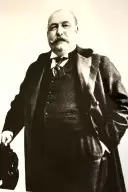
BUCKINGHAM, OLIVER W. (1843-1903). Private, 37th Regiment, New York State National Guard, Company A. Born in Connecticut, he mustered into service on May 6, 1864, served in New York Harbor with the 37th New York National Guard for 30 days, and mustered out on June 6, 1864.
As per the 1875-1876 and the 1877 New York Directories, Buckingham was a merchant. He was listed as being in the yarn business in the 1882-1883, 1884-1885 and 1885-1886 New York City Directories; his business was at 83 Leonard Street and he lived at 50 West 50th Street. According to the 1891-1892 New York City Directory, he was employed in the twine business at the same address; his home address was unchanged. Remaining active in military affairs, he was a member of G.A.R.’s Lafayette Post #140. He last resided at 31 West 50th Street in Manhattan. His death was attributed to apoplexy. Section 161, lot 9273, grave 11.

BUCKLEY, CHARLES K. (1845-1929). Private, 13th Regiment, New York State National Guard, Company E. He enlisted at Brooklyn on May 28, 1862, mustered in that day, and mustered out after three months on September 12 at Brooklyn. He was granted an invalid pension in 1908, certificate 1,146,225. He last lived in West Haven, Connecticut. His cause of death was arteriosclerosis. Section 154, lot 24364.
BUCKLEY, JR., JAMES (1827-1871). Private, 131st New York Infantry, Company H. Buckley was born in Connecticut. On August 14, 1862, he enlisted as a private at New York City and mustered into the 131st New York on September 6. He deserted on July 9, 1864, at Algiers, Louisiana. Buckley last resided at 735 8th Avenue, Manhattan. He died from tuberculosis, Section 114, lot 8999, grave 1000.
BUDDEN, THOMAS (1842-1895). Private, 22nd Regiment, New York State National Guard, Company G. Budden served with the 22nd New York National Guard for 30 days in 1863. He last lived in Brooklyn where he died from anthrax. Section 182, lot 21278, grave 2.
BUDELMANN, JOHN WILLIAM (1837-1888). Commissary sergeant, 14th Infantry, United States Army, Company B; 23rd Infantry, United States Army, Company B. Born in Bremen, Germany, he was a 5′ 6″ tall clerk with hazel eyes and a light complexion when he entered military duty. Budelmann served in the United States Army in both the 14th and 23rd Infantries. Further details are not available. Though he is listed in the National Park Service’s Civil War Soldiers and Sailors website, he may have served only after the Civil War.
In 1867, Budelmann became a naturalized citizen and was working as a bartender. That same year, he married Anna Margaretha Doscher; the couple had seven children. As per the New York City Directory for 1877, he worked in the beer business at 64 Beekman Street. According to the New York City census records for 1880, he was employed as a saloonkeeper. The New York City Directory for 1881-1882, the Phillips’ Business Directory for 1881-1882, the Brooklyn Directory for 1885-1886 and the New York City Directory for 1891-1892 list him in the liquor business at the same Beekman Street address; he lived at 66 Gold Street. His remains were moved to the present location on October 19, 1889. Section 190, lot 26805.
BUDINGTON, WILLIAM GUNTON. (1845-1917). Private, 80th New York Infantry, Company C. Originally from Massachusetts, Budington enlisted as a private on March 9, 1864, at Kingston, New York, the same date that he mustered into Company C of the 80th New York. He served until January 29, 1866, when he mustered out at Portsmouth, Virginia. He last lived at 222 West 23rd Street in Manhattan. His death was attributed to pleurisy. Section 196, lot 31744, grave 2 and 3.
BUEL, WILLIAM PETER (1807-1888). Surgeon, 131st New York Infantry. Born in Sheffield, Massachusetts, his family moved to Litchfield, Connecticut, in 1816, where his father was an esteemed physician and president of the State Medical Society. A graduate of Yale College, class of 1826, he taught in Litchfield before beginning medical school at Yale. He ultimately graduated from the College of Physicians and Surgeons in New York City in 1830. A physician in New York City, he was honored for his work during the cholera epidemics of 1832 and 1849. From 1850-1855, he was surgeon on the line of mail steam-ships from New York City to Panama, then from 1855 until the onset of the Civil War was employed in a similar capacity for the Pacific Mail Company, traveling between San Francisco and Panama.
At the age of 54, Buel enlisted as a surgeon at New York City on August 8, 1862, mustered into the 131st New York’s Field and Staff, and mustered out on July 26, 1865, at Savannah, Georgia. He then served on garrison duty in Wyoming and Colorado until 1871 when he retired and moved to Staten Island. In 1874, he applied for an invalid pension, application 197,284, but there is no certificate number. He last lived at 64 Brooklyn Avenue in Brooklyn. His cause of death was listed as “old age.” Section 98, lot 75.
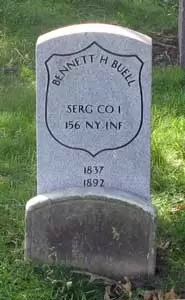
BUELL (or BUERLL), BENNETT H. (1837-1892). Sergeant, 156th New York Infantry, Company I. After enlisting as a sergeant at Castleton, New York, on August 31, 1862, Buell mustered into the 156th New York on November 18. He was reduced to the rank of private on February 6, 1864, and mustered out on October 23, 1865, at Augusta, Georgia.
He is likely the Bennett H. Buell who is listed as a jeweler in the 1876-1878 Brooklyn Directory. In 1891, his application for an invalid pension was granted under certificate 798,353. His last residence was 350 Decatur Street in Brooklyn. He died from albuminuria (kidney disease). His wife applied for and received a widow’s pension a year after his death, certificate 352,664. A minor child received a pension in 1904, certificate 570,774. Section 185, lot 22668.
BUEMAN (or BUEMANN, BURMAN), CHARLES (1844-1926). Private, 53rd New York Infantry, Company K; 162nd New York Infantry, Company F. A native of Denmark, he immigrated to the United States in 1862, as per the 1920 census. During the Civil War, Bueman enlisted as a private at New York City on June 30, 1862, and mustered into Company K of the 53rd New York on August 22. On September 15, 1862, he transferred into Company F of the 162nd New York, was wounded at Cane River Crossing, Louisiana, on April 23, 1864, and was discharged for disability on May 26, 1865.
On June 5, 1865, Bueman applied for and received an invalid pension, certificate 99,796. His naturalization papers were filed at the Court of Common Pleas in New York City on August 21, 1883; at that time, he lived at 259 Delancey Street in Manhattan. As per the census of 1910, he was a single lodger who lived in Manhattan and worked as a shipping clerk for a steamship company; that census notes that he had become a naturalized citizen and could read and write. The 1920 census notes that he was a lodger living on 61st Street in Manhattan. Bueman is listed as a registered voter living on Beach 46th Street in Rockaway, Queens, on the New York City Voting Rolls for 1924. He last lived at 429 Beach 46th Street in Edgemere, Queens. He died from chronic myocarditis at Rockaway Beach Hospital. Section 164, lot 16455.
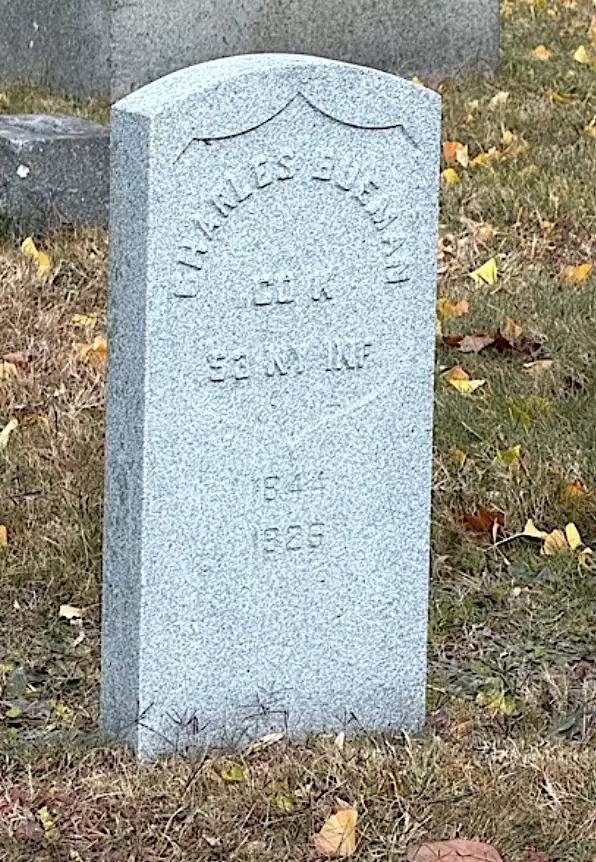
BUGBEE, GEORGE S. (1842-1902). Private, 6th Massachusetts Infantry, Company E. Bugbee, who was born in Dover, Vermont, was a resident of Boston, Massachusetts, where he worked as a clerk at the time of his enrollment. He enlisted as a private on July 15, 1864, and mustered into the 6th Massachusetts three days later. Bugbee was 5′ 5″ tall with hazel eyes, brown hair and a light complexion. The 6th Massachusetts, a militia unit that was activated for 100 days, mustered out on October 27, 1864, at Readville, Massachusetts. At the time of muster out, his clothing account was settled for $22.55.
In 1894, Bugbee applied for and was granted an invalid pension, certificate 1,019,085. He last resided at 271 14th Street in Brooklyn. His death was attributed to apoplexy. Elizabeth Bugbee, who is interred with him, applied for and received a widow’s pension in 1902, certificate 540,421. Section 137, lot 31328, grave 2.
BUGGY, RICHARD (1818-1866). Private, 84th New York (14th Brooklyn) Infantry, Company G. On August 21, 1862, Buggy enlisted at age 44 at Brooklyn as a private. He mustered the next day into the 14th Brooklyn from which he was discharged for disability on an unknown date. His last residence was at 31 Fulton, Brooklyn. He died from dysentery. Section 59, lot 295, grave 51.
BULL, JAMES H. (1814-1862). Lieutenant colonel, 66th New York Infantry. Originally interred at Green-Wood on December 26, 1862, his remains were removed on December 4, 1894. A native and resident of New York, he enlisted at New York City on October 29, 1861, and was commissioned into the Field and Staff of the 66th six days later. Bull was killed in battle on December 11, 1862, at Fredericksburg, Virginia.
BULL, WILLIAM (1831 or 1841-1910). First lieutenant and adjutant, 49th New York Infantry; 12th Battery, New York Light Artillery. Of English birth, he enlisted as a second lieutenant at Buffalo, New York, on March 25, 1862, and was immediately commissioned into Company E of the 49th New York Infantry. His soldier record indicates that he was 20 years old at the time of his enlistment; Green-Wood birth records note that he was about 10 years older than that. He was promoted to first lieutenant and adjutant on October 4, 1862, and transferred to the Field and Staff. He was discharged on April 8, 1863. On April 23, 1863, he was commissioned into the 12th Battery, New York Light Artillery as a first lieutenant. He was discharged on March 23, 1865.
Although he applied for a pension in 1905, application 1,335,118, there is no evidence that it was certified. Bull belonged to the G.A.R. He last lived at 131 Valentine Street in Mount Vernon, New York, where he died from hemiplegia (paralysis on one side of the body); another document indicates that he died in Buffalo, New York. Section 112, lot 17054.
BULMER, CHARLES ALFRED (1841-1890). Private, 132nd Pennsylvania Infantry, Company K. A New Yorker by birth, Bulmer was a resident of Luzerne County, Pennsylvania, when he enlisted as a private and mustered immediately into Company K of the 132nd Pennsylvania Infantry. He was discharged for disability on October 14, 1862.
According to the 1883 Brooklyn Directory, he was in the lumber business living at 38 Fifth Avenue in Brooklyn. The 1890 Veterans Census confirms his Civil War service. He last lived at 28 Lefferts Place in Brooklyn with his wife and five children. His death was caused by Bright’s disease. As per his will, he left personal property valued at $15,000. Section 193, lot 27627.
BULTMAN (or BULTMANN), WILLIAM (1823-1871). Private, 11th New York Cavalry, Company B. Born in Germany, Bultman enlisted at New York City as a private on December 29, 1861, and mustered into the 11th New York on that date. He re-enlisted in the same regiment and company on December 18, 1863. While at the Army General Hospital in Washington D.C., he deserted on April 1, 1865. His last residence was 2 Richard Place in Brooklyn. He died from cholera morbus (gastrointestinal disease). Section 85, lot 1595, grave 64.
BUMSTEAD, JOHN HENRY (1829-1868). Second lieutenant, 65th New York Infantry, Company B; private, 67th New York Infantry, Companies I, D, and B. A native of New York State, Bumstead enlisted as a private at Brooklyn on May 1, 1861, and mustered into the 67th New York on June 20 of that year. He re-enlisted on December 25, 1863, and returned to the same regiment. On June 1, 1864, he was wounded in action at the Battle of Cold Harbor, Virginia. Later that month, he was transferred intra-regimentally to Company D on June 19 and then to Company B on July 4. Subsequently, he transferred into the 65th New York on September 1, 1864, as a sergeant. On October 19, 1864, he was wounded at Cedar Creek, Virginia, was promoted to second lieutenant on January 21, 1865, and mustered out on July 17, 1865, at Hall’s Hill, Virginia.
In 1868, Bumstead applied for an invalid pension, application 132,522, but he apparently died before it was granted. His last residence was on Hickory Street in Brooklyn. His widow, Rosetta Bumstead, applied for a pension in 1868 that was awarded, certificate 123,109. A minor child received a pension in 1882, certificate 200,963. Section D, lot 7078, grave 393.
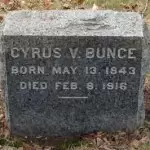
BUNCE, CYRUS V. (1843-1916). Corporal, 23rd Regiment, New York State National Guard, Company K. Brooklyn-born, Bunce enlisted in 1863 and served with the 23rd Regiment as a private when it was activated for 30 days that year. The 23rd mustered in on June 16, 1863, at Harrisburg, Pennsylvania, was at Carlisle, Pennsylvania, on July 1, and mustered out at Brooklyn on July 22.
As per the 1865 Brooklyn Directory, Vance was in the hardware business at 94 Fulton Street and lived on Gates Avenue: his father, John Bunce, who died in 1907 at age 90, began that business and was well-known on Fulton Street. The 1866 Brooklyn Directory lists him as a clerk at the same home address. His last residence was 248 Division Avenue in Hasbrook Heights, New Jersey. Bunce died from arteriosclerosis. Section 1, lot 8238.

BUNCE, LYMAN BEECHER (1833-1864). Corporal, 52nd New York Infantry, Companies A, K, and F. Bunce was born in Suffolk County, New York. he is listed as a painter in the 1857-1862 Brooklyn Directory and lived at 372 Atlantic Avenue. He was married to Rosanna Howard; the couple had one son, born in 1859.
During the Civil War, he enlisted as a private at Brooklyn and mustered into Company A of the 52nd New York on August 31, 1863. He was reduced to ranks on an unknown date and promoted to corporal on October 1, 1863. He was transferred to Company K on August 2, 1864, and to Company F on October 15, 1864. He is still listed as a painter in the 1864 Brooklyn Directory. While on furlough, Bunce died of chronic diarrhea at Brooklyn on December 25, 1864. Section 126, lot 2454, grave 655.
BUNCE, THEODORE DEWIT (1837-1893). Private, 7th Regiment, New York State Militia, Company C. A New York City native, Bunce enlisted as a private at New York City in 1861 and mustered into the 7th New York State Militia for 30 days. When the 7th was reactivated in 1862 and part of the New York State National Guard, he served for three months with the same company. He last lived at 239 East 27th Street in Manhattan. His death was attributed to heart disease. Section 169, lot 14894, grave 14.

BUNCE, WILLIAM G. (1837-1897). Sergeant, 8th New York Infantry, Company F. Bunce enlisted as a sergeant at New York City on May 28, 1862, when the 8th New York was activated for three months. He mustered out with his company on September 10 of that year at New York City. His application for an invalid pension was granted in 1866, certificate 78,821. He last resided at 1210 Eighth Avenue in Brooklyn. He died from nephritis. Section 92, lot 4914, grave 5.
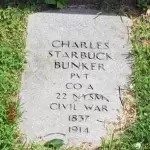
BUNKER, CHARLES STARBUCK (1837-1914). Private, 22nd Regiment, New York State National Guard, Company A. A native New Yorker, he enlisted there on May 28, 1862, for three months of service. According to his pension record, he also served in the 2nd United States Army.
In 1905, Bunker applied for an invalid pension from Minnesota, certificate 1,119,861. Most likely, he was a brother of William R. Bunker (see). He last lived at 401 Ashland Avenue in St. Paul, Minnesota. Bunker died from tuberculosis. Lilly Bunker applied for and received a widow’s pension in 1914, certificate 785,514. Section 147, lot 22251, grave 3.
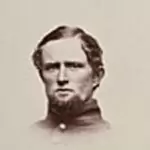
BUNKER, DUMONT (1838-1898). Captain and commissary of subsistence, United States Commissary Department; captain, 19th Maine Infantry, Company K; Maine Coast Guard Infantry, Company E; corporal, 3rd Maine Infantry, Company F. Born in Maine and a resident of Skowhegan, Maine, he enlisted as a corporal on June 4, 1861, mustered into the 3rd Maine Infantry the same day, was reduced in rank to private on June 24 of that year, and was discharged for promotion to second lieutenant on August 26, 1862, the date that he was commissioned into Company K of the 19th Maine Infantry. Bunker became a first lieutenant on October 28, 1862, was promoted to captain on March 3, 1863, and was commissioned captain in the Maine Coast Guards on January 7, 1865. On April 10, 1865, he was promoted to captain and commissary of subsistence and held that position until he mustered out on August 18, 1865.
An 1880 census report of Brooklyn indicated that Bunker was a conductor on the railroad. In 1893, he successfully applied for an invalid pension, certificate 270,842. Shortly after his death in 1898, Josephine Bunker, applied for a widow’s pension, application 676,235, but no certificate number is given. Section 130, lot 36673.

BUNKER, WILLIAM R. (1840-1925). Second lieutenant, 23rd Regiment, New York State National Guard, Company C. A native of New York City, Bunker enlisted at Brooklyn and was commissioned into the 23rd as a second lieutenant on June 18, 1863. He mustered out after 30 days on July 22, 1863, at Brooklyn. Most likely, he was a brother of Charles S. Bunker (see). His last residence was in Greenwich, Connecticut, but he died in Goshen, New York. Section 147, lot 22251, grave 2.
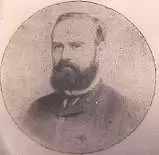
BUNNELL, JESSE H. (1843-1899). Operator, Union Military Telegraph Service. Born in Massillon, Ohio, Bunnell began working in a telegraph office when he was just eleven years old. He was a pioneer in his field, delivering telegraph messages in Ohio, Pennsylvania, and West Virginia from 1859-1861. Among his transmissions was the one sending President Buchanan’s last message to Congress.At the start of the Civil War, Bunnell joined the Union Military Telegraph Service (UMTS) which was organized by Andrew Carnegie. A civilian post, his job was to relay troop movements and report on casualties, a position that replaced, in part, the military courier. As per his obituary in the New York Tribune, he (along with 50 other operators) set up an office on the field at the Battle of Antietam, Maryland in September 1862, and sent and received messages under fire. In December 1862, he successfully petitioned the military to raise the pay of telegraphers and to provide more support.
First serving in Washington, D.C., Bunnell subsequently served in the field with the Army of the Potomac from June 1862 to August 1864, as Major General George B. McClellan’s personal telegrapher and then was with Sherman’s Army of the Cumberland in Tennessee and Atlanta. His obituary notes that he was attached to General William S. Rosencrans’s headquarters in the Department of the Cumberland and worked as an operator at Chattanooga and Missionary Ridge before he was sent to Atlanta. Suffering from exposure and starvation, he was greatly weakened and resigned on August 16, 1864.
His work led him to Philadelphia from 1864 to 1872, where he and James Partrick formed the firm, Partrick, Bunnell & Co., a manufacturer and dealer in telegraph and electrical instruments. In 1878, in New York City, he started J. H. Bunnell and Company, a manufacturing enterprise that specialized in telegraph apparatus and electrical supplies; the next year, he formed a partnership with Charles McLaughlin, who focused on sales. Bunnell introduced and patented numerous devices including a “side-swiper” key that prevented the ailment known today as carpal tunnel syndrome. He last resided in the St. George Hotel in Brooklyn. His funeral took place at St. John’s Episcopal Church on Seventh Avenue in Brooklyn. He was survived by his widow, Mary Thomas Bunnell, whom he married in 1874, and their four children.
Bunnell’s family continued the business with a newly named company, the Bunnell Telegraphic and Electrical Company, a year after the patriarch’s death. Although McLaughlin continued to use the name J. H. Bunnell & Co. as the surviving business partner, the Bunnell family’s business was a strong competitor. Jesse Bunnell left an estate of $300,000 (of which $30,000 was allocated to his widow), the equivalent of $9,350,000 in 2020 money, which gave the new company substantial capital. In September 1902, McLaughlin was bought out by the Bunnell family, merging the two companies. The company today is in Kings Park, Long Island, where it continues to supply industry and the military with electrical and communications items as well as highly sought after miniatures. Section 146, lot 24400.
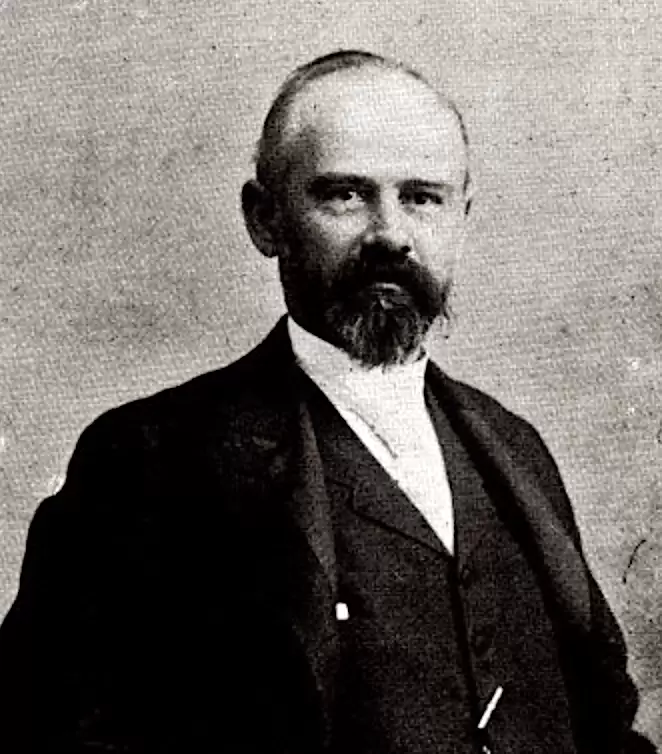
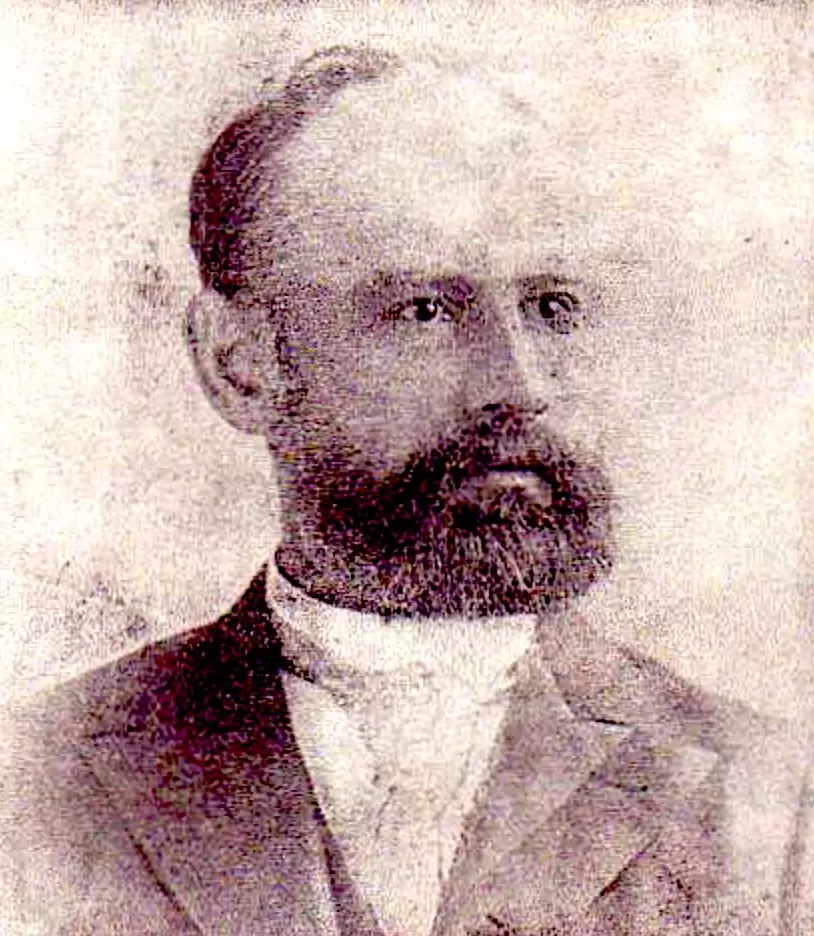
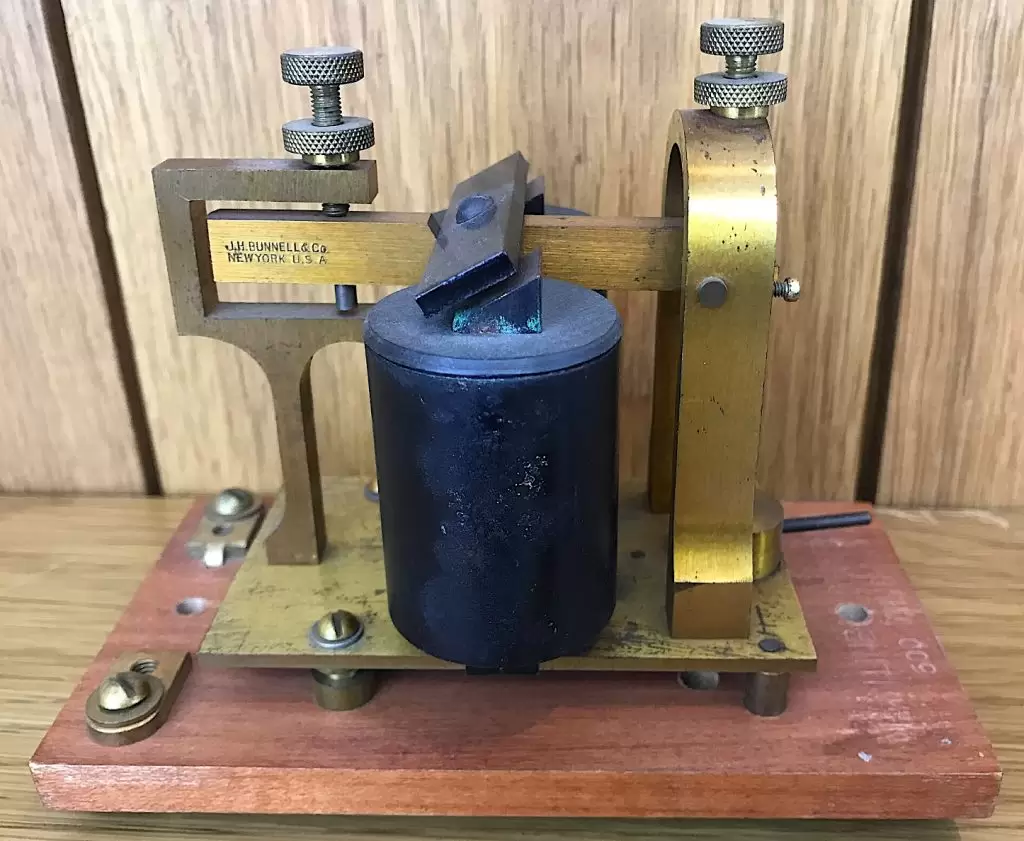
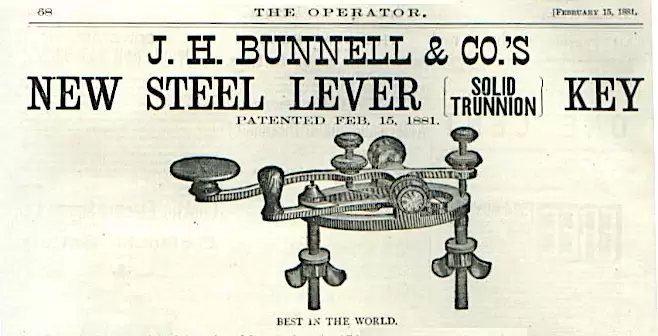
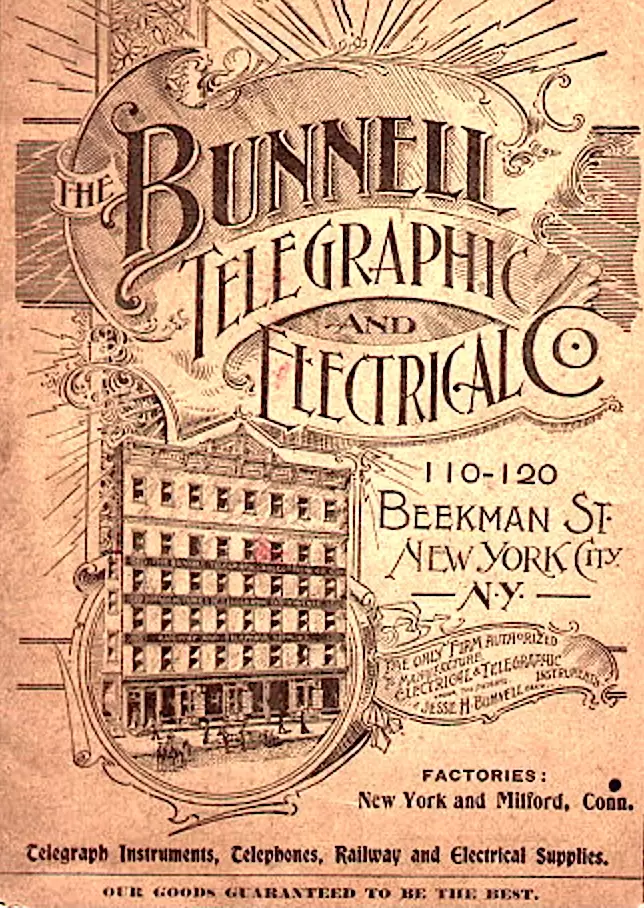

BUNTA (or BUNTY, BONTA), FREDERICK W. (1843-1905). Private, 10th New York Cavalry, Company A; 13th New York Heavy Artillery, Company E; 6th New York Heavy Artillery, Company I. Born in Germany, he enlisted at Schenectady, New York, on November 14, 1861, and mustered into the 10th New York Cavalry the next day. He was discharged for disability on December 5, 1862. He re-enlisted as a private on February 1, 1864, at Glenville, New York, mustered into the 13th New York Heavy Artillery on March 10, 1864, and was transferred into the 6th New York Heavy Artillery on July 18, 1865.
In 1892, Bunta applied for and received an invalid pension under certificate 1,133,799. He last lived on Fourth Avenue in Brooklyn. His cause of death was bronchitis. Lizzie Bunty’s application for a widow’s pension was granted in 1907, certificate 627,613. Section 2, lot 5499, grave 1356.
BUNZENTHAL, HENRY (1832-1865). Corporal, 15th New York Heavy Artillery, Company A; Veteran Reserve Corps. Of German origin, he enlisted as a private on September 15, 1862, at New York City, and mustered immediately into the 15th Heavy Artillery. On September 13, 1863, he rose to corporal of his company, was reduced to ranks at some point, and transferred into the Veteran Reserve Corps on December 18, 1864. He was discharged on June 28, 1865, at Washington, D.C. His last residence was 84 Hudson Street, New York City. Section A, lot 7078, grave 214.
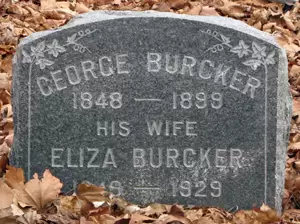
BURCKER (or BURKER), GEORGE (1848-1899). Private, 3rd Pennsylvania Cavalry; 5th Pennsylvania Cavalry. Enlisting as a private on October 26, 1864, he mustered that day into an unassigned company of the 3rd Pennsylvania Cavalry where he served until June 6, 1865, when he was transferred into the 5th Pennsylvania Cavalry.
Burcker joined the G.A.R. on April 1, 1887. As per his obituary in the New York Herald, members of the George G. Meade Post #38 of the G.A.R. were invited to attend his funeral. He last lived at 525 Hudson Street in Manhattan. His death was attributed to ulcers. Section 135, lot 30010, grave 675.
BURDELL, LOUIS (1840-1866). Corporal, 38th New York Infantry, Company D. Born in Brazil, Burdell enlisted at New York City as a corporal on May 7, 1861, mustered into the 38th on June 3, and was discharged for disability on January 14, 1862, at Alexandria, Virginia. His last residence was 403 West 23rd Street in Manhattan. He died from an overdose of morphine. Section 44, lot 3799.
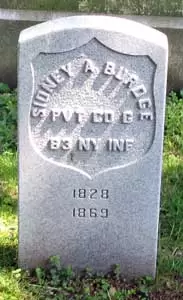
BURDGE, SIDNEY A. (1828-1869). Private, 83rd New York Infantry, Company G; Veteran Reserve Corps, 2nd Battalion, 76th Company. Burdge, who was born in New Jersey, enlisted as a private at New York City on May 27, 1861, mustered immediately into the 83rd New York, and transferred into the 76th Company of the Veteran Reserve Corps on October 14, 1863, from which he was discharged. He last lived at 218 East 28th Street in New York City. Emma Burdge, his widow, applied for a pension after his death from tuberculosis, application 261,869, but there is no certification number. Section 186, lot 18509.
BURDORFF, ERNST C. (?-1890). Private, 35th New Jersey Infantry, Company H. A German native, Burdorff enlisted as a substitute in the 35th New Jersey on March 14, 1865, for one year. He deserted from the line of march from Washington, D.C., to Fairfax Seminary, Virginia, on June 20, 1865. Burdorff was apprehended by the provost marshal of D.C. the next day at the Ohio Railroad Depot in citizen’s clothing, without a pass and with a railroad ticket home. He was turned over to Captain E. M. Camp on June 23, then confined at Slave Pen, Virginia, from June 24 until June 26, 1865, at which time he went home. Captain Camp signed a receipt noting that $235 was taken from Burdorff at the time of his arrest; Burdorff never returned to his company which officially mustered out on July 20, 1865.
In 1866, he applied to the New York County Superior Court for citizenship and renounced his allegiance to the King of Hanover On June 20, 1876, Burdorff’s petition as “an old and poor soldier” for the return of $235 and other monies was the subject of a report by the Committee on Military Affairs in the United States Senate. Burdorff claimed that when he enlisted, he was entitled to a total of $800 in bounties, $220 of which he was paid and the remainder held as security. Further, after he was paid $400 and admittedly deserted on June 20, 1865, half of his pay was sent home, $5 given to him, and $235 was kept by the provost marshal. He now wanted the $235 plus interest and the remainder of his bounty claiming that Congress passed a bill stating that those who deserted after April 18, 1865, were entitled to their claims.
Senator F. M. Cockrell reported that the bill pertaining to deserters never became law and that in effect, Burdorff deserted twice by never returning to his company. The auditor ruled that he was not entitled to any bounty whatsoever because all bounties for substitutes were discontinued as of September 5, 1864. Further, Burdorff was an admitted deserter and was not entitled to additional money or allowances of any kind. The auditor ruled that Burdorff would be reimbursed the $235 if further investigation determined that he had not been repaid that sum. He last lived at 49 Stanton Street in New York City. Section 203, lot 26978.
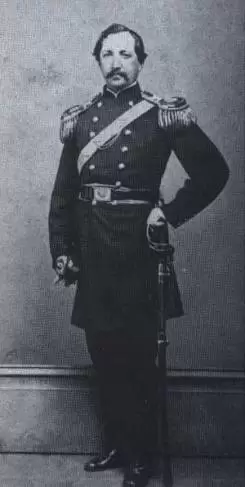
BURGER, LOUIS (1821-1871). Brigadier general by brevet; brigadier general, 2nd Brigade, New York State National Guard, 1st Division; colonel, 5th Regiment, New York State National Guard. Burger came to the United States from Germany in 1849 and established himself as an architect in New York City. In 1854, he organized the engineer corps of the 5th Regiment of the New York State National Guard. Enlisting at New York City on April 19, 1861, he was commissioned lieutenant colonel on May 1, and mustered out at New York City on August 7, 1861. On July 5, 1863, he was again commissioned into the 5th, this time as its colonel, and mustered out on July 22 at New York City. He was brevetted brigadier general, and in 1865 elected brigadier general of the 2nd Brigade, 1st Division of the New York State National Guard.
Burger was twice president of the “Liederkranz,” a German musical society in New York, and was a director of the Bowery National Bank and the German Savings Bank. Thousands of citizens and many fellow veterans from the 5th Regiment and the 2nd Brigade attended his burial, which was held with full military honors on May 28, 1871. His sword, belt, epaulettes, and hat adorned his coffin and he was buried in his uniform. He last lived at 91 Pineapple Street in Brooklyn. His death was attributed to heart disease. Section F, lot 21022.
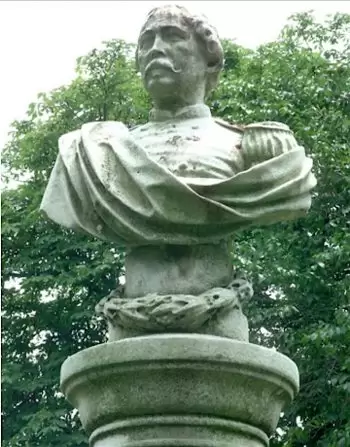
BURGESS, DANIEL MAYNARD (1824-1911). Assistant surgeon, United States Volunteers. Born in Richfield, New York, Burgess graduated with a medical degree from the University of the City of New York, class of 1855. During the Civil War, he entered service as an assistant surgeon in 1862 and was medical officer on the hospital transport ship R. S. Spaulding under General George B. McClellan. That vessel was in charge of transporting sick and wounded from the Army and Navy from the Chickahominy and St. James Rivers to Philadelphia, Boston, and New York City. Later, he was detailed as a surgeon on the staff of Generals E. O. C. Ord and Ulysses S. Grant. In an ironic twist, he was wounded at the Battle of Burgess Mill, on his uncle’s farm, near Petersburg, Virginia. He described the incident in his memoir:
During my Army service, the engagement known as that of the “Burgess Farm” occurred. This took place on a farm near Petersburg, Va., owned by my father’s brother, William Burgess. I was under severe fire at this occurrence, and candidly admit that I did not relish the reception of my comrades and myself upon my visit to my own uncle’s home. To be sure, neither he nor his family were then occupying it, for the house was in the direct line of fire between the two armies, and although occupied as a temporary hospital for a time, had become riddled by gun fire and the family had moved temporarily to a quieter and less dangerous residence.
An unsought for honor, during my army life, was that of exchanging the position of surgeon for that of the patient. My left arm was torn open by a fragment of a shell which burst close by me while I was dressing a wounded soldier. This little pleasantry took place between City Point and Petersburg.
Burgess was known for his knowledge of and exploration of the Americas. At the start of the Spanish-American War, Burgess was the first physician to reach the battleship Maine when it exploded in Havana, Cuba, on February 15, 1898. At that time, he was the sanitary commissioner for the U.S. government, stationed in Havana Harbor, a position that he held for thirty years. He wrote about that day in his memoir, Personal and Professional Recollections, which was completed right before his death in 1911. He recalled that the Captain Sigsbee of the Maine summoned him to come at once:
I immediately responded to his call for assistance, and, upon my arrival, started in to do all that was in my power to aid the poor fellows who had met misfortune on board the ill-fated ship, and who passed through the awful horrors of that explosion. The harbor, as I rowed over it, seemed literally covered with dead and dying, wounded and drowning members of the crew of that stricken ship. When I reached the wreck itself, I found a number of survivors, most of them wounded, and all in need of assistance. I got to work at once and directed the transportation to the hospitals of such as were in condition to be moved. At the same time, I did all that I could do to alleviate the suffering of those who were the less seriously injured and who were the most anxious, like the true men they were, to try to help in the rescuing of their shipmates who had been less fortunate.
This awful catastrophe to one of my own country’s Men-of-War, with the loss of over two hundred and fifty of my fellow countrymen men, was a most tragic affair, and one which has left a lasting impression upon me.
In his memoirs, he reminisces about his many famous acquaintances including Presidents Grant, Chester B. Arthur, and Grover Cleveland; Generals Winfield Scott, Philip Sheridan, and Robert E. Lee; and other luminaries including Daniel Webster, Mark Hanna, Roscoe Conkling, William Tweed, Charles Dana, F. Hopkinson Smith, and King Edward VII of England. Burgess belonged to the New York State and County Medical Societies. He last resided at the Hotel San Remo on Central Park West in Manhattan. He died from pneumonia. Section 16, lot 29709.
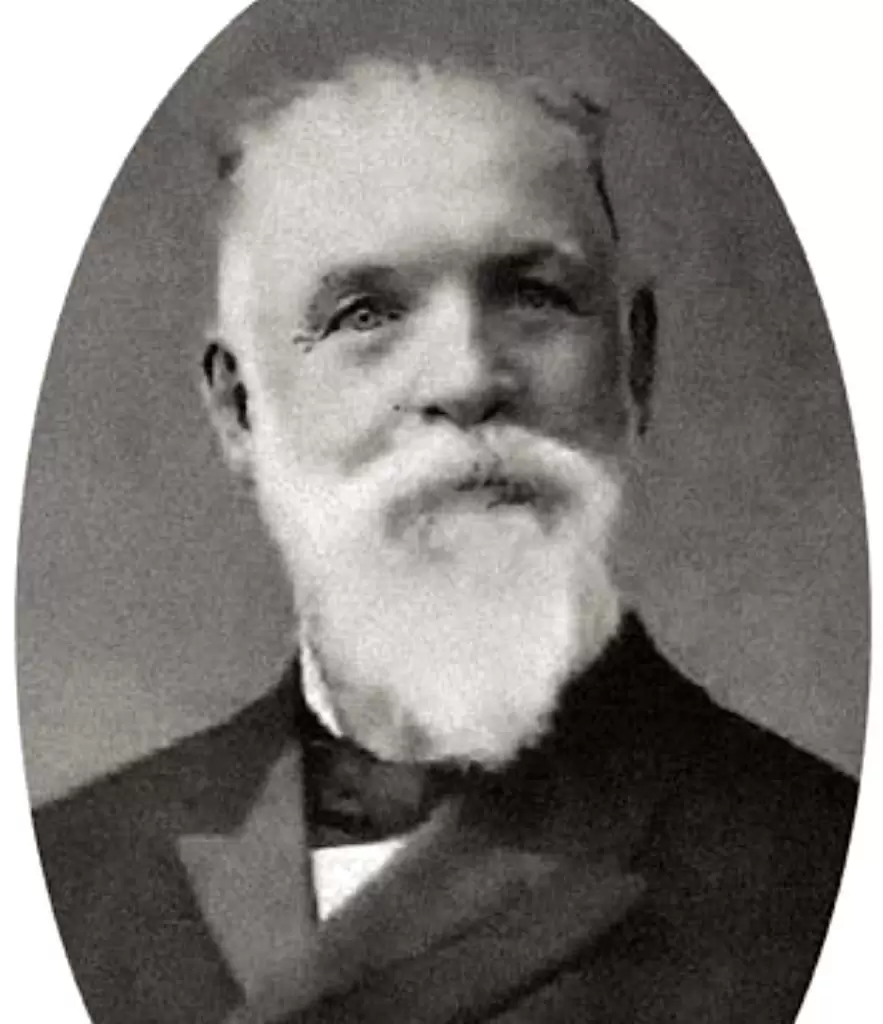
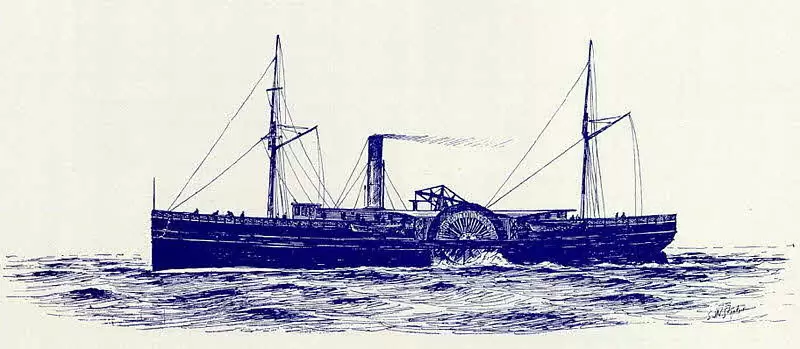

BURGESS, JAMES W. (1828-1887). Major, 6th New York Infantry, Company A. After enlisting as a captain at New York City on April 25, 1861, he was commissioned into the 6th New York five days later. On June 21, 1862, he was promoted to major and transferred into the Field and Staff. He mustered out on June 25, 1863. His last residence was in New York City. Burgess died from nephritis. Section 2, lot 5499, grave 1711.
BURGH, ADOLPH (1841-1887). Private, 9th New York Infantry, Company B. German-born, Burgh enlisted as a private at New York City on April 23, 1861, and mustered into the 9th New York on May 4. His muster roll notes that he was paid $3.96 by New York State for his service from April 23 to May 3, 1861. He mustered out at New York City on May 20, 1863.
As per the New York City Directory for 1875-1876, he was an expressman (wagon driver or person responsible for delivery of goods on a railroad car) who lived at 191 Mott Street. At the time of his naturalization on October 9, 1880, he was employed as a truckman. He last lived at 191 Mott Street in Manhattan. He died from cellulitis. In 1890, Margaret Burgh applied for and received a widow’s pension, certificate 333,627. Section 3, lot 21025, grave 297.
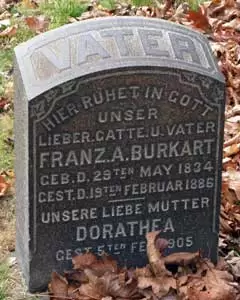
BURKART (or BURKHARDT), FRANZ (or FRANCIS) A. (1834-1886.) Private, United States Infantry, Company E. Burkart, who was born in Germany, enlisted as a private and served in Company E of the United States Infantry. Further details about his service are unknown. His last residence was 50 Bergen Street in Brooklyn. Section 2, lot 5499, grave 1769.
BURKITT, THOMAS (1843-1916). Private, 10th Regiment, New York Infantry, Company G; 37th Regiment, New York Infantry, Company H; 1st Connecticut Cavalry, Unassigned Company. Burkitt was born in England and immigrated to the United States in 1852. A resident of Monroe, Connecticut, Burkitt enlisted as a private on December 8, 1864, and mustered into an unassigned company of the 1st Connecticut Cavalry on that same date. He was discharged on October 19, 1865. As per Burkitt’s pension index card, he also served as a private in Company G of the 10th Regiment, New York Infantry, and in Company H of the 37th New York Regiment, but those service dates are not known.
As per the 1875-1876 and 1876-1878 New York City Directories, Burkitt was a policeman who lived at 356 Bleecker Street. The 1880 census notes that he was married with one child, lived in Manhattan and worked as a policeman. The 1885-1886 Brooklyn Directory reports that he was still working as a policeman and living at the same Bleecker Street address. As per the Veterans Schedule of 1890, he was a private during the Civil War; at that time he was living at 626 Hudson Street in Manhattan. In 1895, he applied for and received an invalid pension, certificate 942,122. The census of 1910 indicates that he was living in Manhattan, working as a policeman, had been married for forty-one years, was able to read and write and was a naturalized citizen. He last lived at 67 West 107th Street in Manhattan. Burkitt’s death was attributed to arteriosclerosis. In 1917, Annie Burkitt applied for and received a widow’s pension, certificate 844,375. Section 196, lot 27900, grave 1.
BURKLE, WILLIAM (1837-1907). Private, 73rd New York Infantry, Companies D and H. Burkle, a native of New York, served with the 73rd New York in Companies D and H but there are no further details about his enlistment. As per his obituary in the New York Herald, members of the Association of Exempt Firemen (volunteer firefighters who served for more than five years) were requested to attend his funeral. He last resided at 272 West 141st Street in Manhattan. Burkle died from mitral regurgitation (heart valve disease). Section A, lot 8100, grave 663.
BURLEIGH, LeMOYNE (or LeMOINE) (carried on the rolls as BURLEIGH LeMOYNE) (1845-1907). Second lieutenant, 1st New York Cavalry, Company H. Born in Connecticut, he enlisted as a private on October 21, 1864, at Brooklyn, and mustered into the 1st New York Cavalry. He was carried on the rolls as Burleigh LeMoyne. On June 10, 1865, he was commissioned as a second lieutenant but was not mustered in that rank, and mustered out on June 27, 1865, at Alexandria, Virginia.
He is likely the Lemoyne Burleigh listed as a reporter in the 1884-1885 New York City Directory. In 1907, he applied for an invalid pension, certificate 1,135,387; the next year, a minor child was granted a pension, certificate 643,696. He last resided at 151 Henry Street in Brooklyn. His death was attributed to apoplexy. In 1918, Margaret L. Burleigh’s application for a widow’s pension was granted, certificate 854,490. Section 169, lot 14933, grave 6.
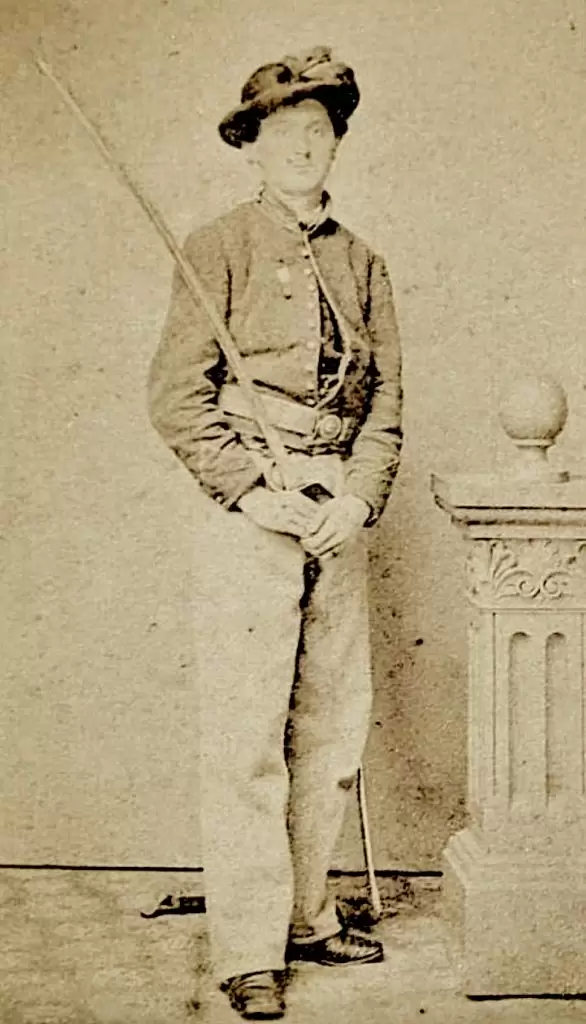
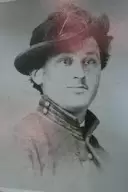
BURLEW, HENRY (1842-1878). Private, 7th Regiment, New York State Militia, Company E. Burlew, who was born in New York, served as a private for 30 days in 1861 with the 7th Regiment. He last resided in Bloomfield, New Jersey. Burlew died from tuberculosis. Section 21, lot 10220.
BURMAN, JAMES (1835-1870). Private, 10th New York Infantry, Company A. Of English birth, Burman enlisted as a private on January 25, 1864, and mustered into the 10th New York that same day. On May 6, 1864, he was wounded at the Battle of the Wilderness, Virginia, and mustered out the next month on June 7 at Munson’s Hill, Virginia. He last lived at 25 Laurens Street in New York City. Burman’s cause of death was asphyxia. Section 126, lot 2458, grave 864.
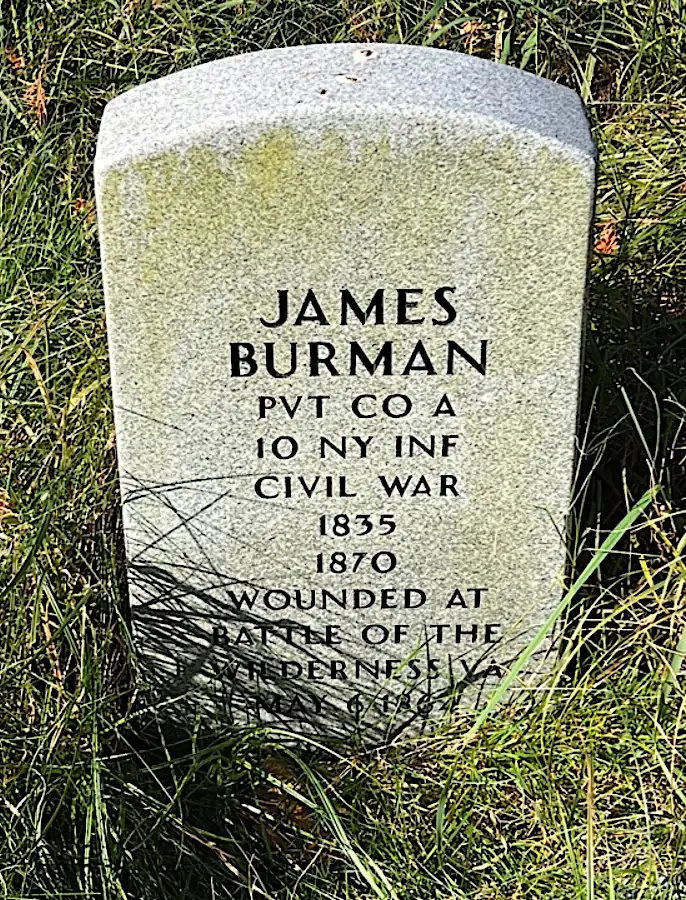
BURNETT, WARD BENJAMIN (1810-1884). Helped organize Union regiments and led impromptu militia during the New York City Draft Riots. Born in Pennsylvania, Burnett entered the United States Military Academy at West Point in 1828 and graduated in July 1832 with the rank of second lieutenant. He saw action in the Black Hawk Expedition in 1832 and was on special duty making drawings at West Point later that year. Subsequently, he was assigned to garrison duty at Fort Jackson, Louisiana, then taught infantry tactics at West Point until 1834 when he was dispatched to topographical and then ordnance duty in Florida.
A civil engineer from 1836-1844, Burnett resumed his military career as colonel of the 1st New York Volunteers in the Mexican War as of December 3, 1846. He saw action at Vera Cruz, Cerro Gordo, Contreras and Churubusco, where he was severely wounded on August 20, 1847. In August 1848, Burnett was brevetted brigadier general for gallant and distinguished service. He was bestowed with many honors for his service in the Mexican War including a silver medal from the New York City, a gold medal from his old regiment and gold snuff-box that had originally been presented by the City of New York to Major General Andrew Jackson in 1819. (The last mentioned award was presented to Burnett in 1859.) He was superintendent of the dry docks at Philadelphia Navy Yard from 1849-1852, then headed the Brooklyn Navy Yard until 1855 during which time he was chief engineer of the Brooklyn Water Works. In 1856, he was head of the Water Works at Norfolk, Virginia. From 1858-1860, Burnett was surveyor of the Kansas and Nebraska Territories.
During the Civil War, the Herald Tribune reported Burnett was nominated for the post of brigadier general; that appointment did not materialize. He sent an envoy, Colonel Alexander S. Diven (107th New York), to meet with President Abraham Lincoln to discuss the issue, thinking incorrectly that Lincoln had a bad impression of him. Lincoln wrote directly to Burnett, on March 7, 1863, “…As I remember, you were nominated last year, and the nomination fell, with many others, because the number nominated exceeded, the law. I call to mind no reason why you have not been re-nominated, except that you have not been in active service, while others more than sufficient to take all the places, have been.” Burnett then enlisted the support of New York City’s Mayor George Opdyke, who after writing to Secretary of War Edwin M. Stanton, received a similar reply.
In spite of his rejections by Lincoln and Stanton, Burnett participated in quelling the New York City Draft Riots in July 1863. According to William O. Stoddard, an aide to President Lincoln who was in New York City during the Draft Riots, Burnett headed a hastily formed militia unit that Stoddard joined. Stoddard recalled, “When we reached the corner of the sub-Treasury, there on the steps was General Ward B. Burnett, organizing a company of volunteers that promised to be a good one. I knew that he had commanded the First New York Volunteers during the Mexican War and was accounted a brave, capable officer. That was the man to serve under, and we at once fell in line, recounting our experiences in the Rifles. The General swore us in, looked very cool but a little bloodthirsty, and we were posted. That is, we were put temporarily in charge of the Treasury, under the impression that there was to be an immediate attack on it. Later, we were transferred to the portico of the Custom House, where we kept company with a wide-mouthed howitzer.”
On July 6, 1864, Burnett wrote again to President Lincoln offering his services. He wrote that he had helped organize about thirteen regiments and that “…I have expended all the money that I possess, or could command, in doing so-and without the aid of City, County, State or nation, to the amount of one dollar.” Burnett added that he had convalesced from a long and painful illness but did not want to remain idle in the midst of the intense conflict. The aforementioned correspondence is in Lincoln’s papers in the Library of Congress.
He is likely the Ward B. Burnett listed as an engineer at 20 Nassau Street in the 1875-1876 and 1877 New York City Directories. His wife, Emily Watson Ward Burnett, and he, had two children. She died in 1881. He last lived in Washington, D.C., where he was an invalid for several years. On obituary incorrectly reported that he was interred at West Point. Section 62, lot 6548.
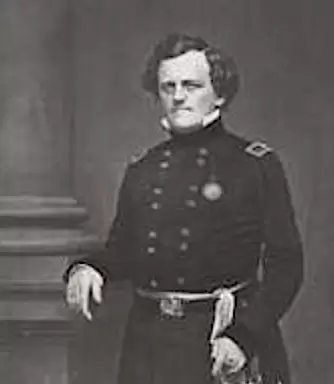
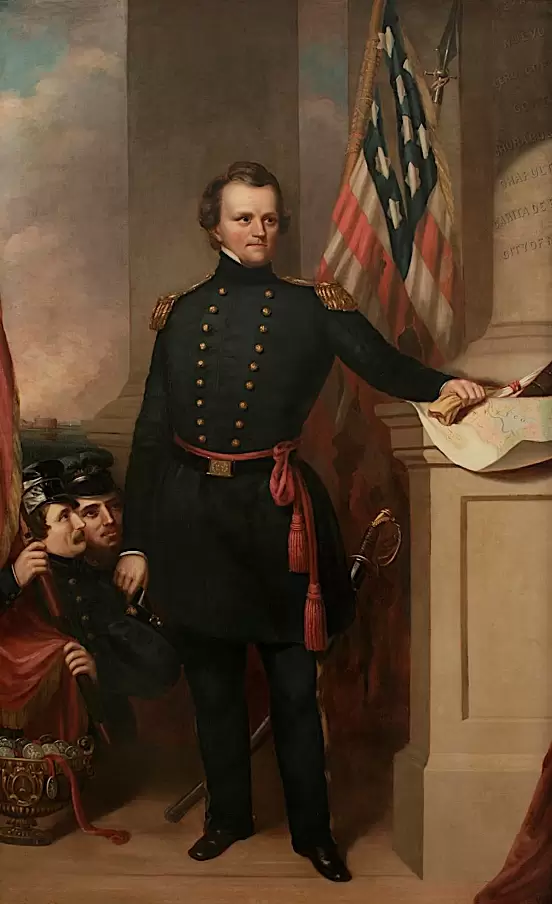
BURNETT, WILLIAM MARLING (1809-1889). Major, 158th New York Infantry; captain, 84th New York (14th Brooklyn) Infantry, Company C. As per his online family tree on the Ancestry website, he was born on November 21, 1809, in Bungay, Suffolk, England, to parents William and Rachel. He was baptized in Bungay on November 15, 1811, and arrived in New York City on June 3, 1831. The passenger manifest for the Isaac Hicks notes that William was 22 years of age and was a tailor by trade.
Burnett’s aforementioned online family history notes that he married Eliza Ann Coffin on June 17, 1832. Census data from 1840, 1850, 1855 and 1860 report that he was living in Brooklyn. In 1835, they were living in New York City and William was working as a tailor. Both he and his wife are listed on United States Presbyterian Church Records as being baptized on September 25, 1836. His petition for naturalization was approved on October 21, 1839.
The 1840 census indicates six free white persons living in the Burnett’s Brooklyn household, four under the age of 20. At the time of the 1850 census, William and Eliza were living in Brooklyn’s Ward 3 with children: William H. (17), Emma (11), Thomas (9), Washington (5) and Cornelius (2). George Lippencot (38), relationship unknown, also lived in the household. William was a tailor. By the time of the 1855 New York State census, there were two more children, Ann (6) and Benjamin (2). Four other individuals were part of the household, three were from the Semnyeh family and a fourth was Peter Holden; William H. was no longer listed on this census. The 1860 census shows the couple living in Brooklyn with six children and William working as a master tailor.
During the Civil War, Burnett served with two different units. On April 18, 1861, he enlisted as a captain at Brooklyn and mustered into Company C of the 84th New York (14th Brooklyn) Infantry on that same date. He mustered out on June 30, 1861. On October 16, 1862, he enlisted as a major at Brooklyn at age 52 and was commissioned into the Field and Staff of the 158th New York on October 20. As per his muster roll for that enlistment, William was 5′ 6½” tall, with blue eyes, dark hair and a ruddy complexion. The document confirms his birth in England and his occupation as a tailor. His Draft Registration, filed in July 1863, details that he was a soldier who lived on Lawrence Street in Brooklyn but incorrectly reports that he was born in the United States. Burnett was discharged on November 18, 1863. His muster roll notes that his discharge was per Special Order 121 Virginia and North Carolina.
Burnett’s online family history shows that he lived in Brooklyn in 1865, 1877, and 1880. As per the 1865 New York State census, William and Eliza were living in Brooklyn with children Washington, Cornelius, Ann and Benjamin. The Jourdan family, including Emma, his daughter, and her husband and two children, and Maggie Scully (18), relationship unknown, comprised the household. The 1880 census reports that William and Eliza were living at 118 Prospect Street in Brooklyn with five members of the Deacon family, possibly their daughter Ann Eliza Deacon and her husband and children. Eliza Burnett died in 1882.
On September 28, 1887, a puzzling obituary appeared in the Brooklyn Daily Eagle that reported the death of William Burnett at Madison Street in Brooklyn. That article noted that William had a tailor shop on Henry Street in Brooklyn for many years and that he had been captain of the City Grenadiers, afterward known as Company C of the 14th Regiment. It also confirms his rank as major in an unnamed regiment, serving under Colonel now General James Jourdan (see), who was married to his daughter Emma. That article mentioned that William’s son Thomas was a captain in the 14th during the Civil War (though Find A Grave records that Thomas is interred at Green-Wood in an unspecified lot, no record of his interment appears in the cemetery’s records). Remaining active in his community, William Burnett was a member of the Society of Old Brooklynites and other local organizations.
The day after the above obituary appeared, the Brooklyn Daily Eagle published another article headlined, “Major Burnett Is Not Dead.” In that article, General James Jourdan, the president of the Municipal Gas Company, requested that the Eagle report the error and stated that William Burnett was alive and in good health living in Brainard in Rensselaer County. Jourdan said, “The old gentleman has lived for fifty years in Brooklyn and is now a subscriber to the Eagle. Last night’s paper will reach him this afternoon and he will then have the pleasure of reading his own obituary, which, by the way, is correct in every detail, except that which I have referred to.” When Burnett’s actual obituary appeared in the Brooklyn Daily Eagle on November 17, 1889, it was repeated that Burnett was prominent in the fighting Fourteenth Regiment prior to the Civil War and that his death would be mourned by old militia men. In addition, the obituary mentioned that William had taken great pleasure in reading his own obituary, published about two years before his death, when he was still in good health. William’s son-law, James Jourdan, died about two months after him in November 1889.
A widower, William’s last residence was in Renssalaer City, New York, where he died from Bright’s disease. His death certificate notes Emma Burnett Jourdan as his daughter. Section 142, lot 24090.

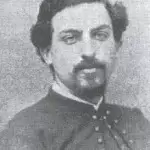
BURNS, ALBERT M. (1844-1887). Second lieutenant, 84th New York (14th Brooklyn) Infantry, Companies C and F. After enlisting as a private on April 18, 1861, and mustering in on May 23, he was promoted to sergeant on January 1, 1863, to sergeant major on March 13, 1863, and to second lieutenant on August 18, 1863. His last promotion was effective upon his intra-regimental transfer to Company F on January 9, 1864. On June 14, 1864, he mustered out at New York City. He last lived on Tenth Avenue in Manhattan. The cause of his death was tuberculosis. In 1887, Sarah Burns, applied for and received a widow’s pension, certificate 250,306. Section 59, lot 3775.
BURNS, WILLIAM J. (1833-1889). Sergeant, 69th Pennsylvania Infantry, Company B. He enlisted as a sergeant on September 1, 1861, mustered into the 69th Pennsylvania, and mustered out on September 6, 1864. According to his obituary in the Brooklyn Daily Eagle, Burns also served in the 71st Pennsylvania Infantry. He joined the G.A.R. in Brooklyn on October 6, 1882. He last resided at 258 Bainbridge Street, Brooklyn. His death was attributed to pneumonia. Section 1, lot 8298.

BURNSIDE, WILLIAM (1832-1898). Private, 98th Pennsylvania Infantry, Company A. A New Jersey native, Burnside enlisted as a private on September 3, 1861, mustered immediately into the 98th Pennsylvania, and mustered out on June 29, 1865, at Washington, D.C.
On September 1, 1890, Burnside joined the G.A.R. In 1895, he successfully applied for an invalid pension. His last residence was 546 Fourth Avenue in Brooklyn. Burnside died from apoplexy. His wife applied for and received a widow’s pension, certificate 467,874. Section 3, lot 18372, grave 160.
BURR, FREDERICK STANLEY (1835-1904). Quartermaster sergeant, 5th New York Infantry, Company B. Burr was born in Brooklyn, into a prominent family; his father, Jonathan S. Burr, was a founder of the Williamsburgh Savings Bank. Frederick Burr enlisted on May 8, 1861, and mustered into Company B of the 5th New York as a private on June 28. As per his muster roll, he was a clerk who was 5′ 7″ tall with blue eyes, brown hair and a light complexion. He was detailed to the Quartermaster Staff on May 12, appointed quartermaster sergeant on July 9, tendered his resignation from that post on September 8 and returned to Company B the next day. He suffered from chronic nephritis, “excessive obesity” and rheumatism. On September 28, 1861, Burr was discharged for disability at Camp Federal Hill, Baltimore. He later served as a civilian employee and clerk for the Quartermaster Department at Fort Monroe, Virginia.
On December 31, 1863, he married Susanna E. Pinner at Magnolia, Virginia; the couple had three sons. By 187o, Burr was living in Brooklyn with his wife and three sons; the census of that year shows a Greenpoint postal address and lists his occupation as block manufacturer. The Brooklyn Directory for 1873-1876 also lists him as a block manufacturer. As per the 1880 census, he lived with his family at 85 Ross Street in Brooklyn, and identified himself as an iron founder, the same profession that is reported in the 1880-1882 Brooklyn Directory. On June 17, 1884, Burr mustered into the Post #35 of the G.A.R. (the Mansfield Post) and listed his occupation as manufacturer.
In 1890, he lived at 176 Stanhope Street in Brooklyn. On September 18, 1890, he wrote to Hiram Duryea, thanking him for his assistance: “The cordial greeting you extended to me as a comrade in distress, ready to give up the struggle and fall by the wayside, has given me fresh courage to renew the conflict against the ills of life.” The 1900 census notes that he was retired, lived in a house that he owned in Babylon, New York, with his wife of 38 years, three adult sons and a housekeeper. As per his obituary in the Brooklyn Daily Eagle, his funeral was held at his late residence on South Country Road in Lindenhurst, Long Island, with carriages meeting the trains there and in Babylon. His death was attributed to hepatic (liver) disease.
The Brooklyn Daily Eagle published the obituary of his son, Henry Pinner Burr, a well-known Brooklyn lawyer, on December 4, 1940. That obituary noted that Henry Burr, 72, was born in Suffolk, Virginia, the hometown of his mother and that his father was an officer in the Union Army. That obituary notes that he had two brothers who predeceased him; one, who bore his father’s name, had been a member of the New York State Assembly. Section 188, lot 31670, grave 1.
BURR, HENRY AARON (1810-1884). Recruiter, 11th New York Infantry, and businessman. As per his obituaries in the Yonkers, New York Statesman and The New York Times, he was born in Canaan, New York, and was the last distant relative of Vice President of the United States Aaron Burr. His parents were from prominent Connecticut families; his mother was a sister of theologian Jonathan Edwards. In about 1830, Burr settled in New York City where he became an accountant in a millinery firm of Elisha Bloomer at 102 Broadway. He married Harriet Ann Riblett in 1832; the couple had four children, two of whom died before the Civil War. Within five years of working in the millinery field, he opened his own rival store a few doors away from Bloomer’s and, by 1845, was experimenting with hat-making machines with Henry A. Welles; Welles died before their plans were completed. A self-made businessman, Burr’s greatest success was his invention of a hat-forming machine that was patented in 1852; previously, all hats were formed by hand. In an era when virtually every male wore a hat, nearly six million of Burr’s machines were in use in the United States in 1856. His factory was at 5 Hague Street in Manhattan.
He was president of the Board of Trustees of New York City’s Volunteer Fire Department for 17 years, and at the outbreak of the Civil War he helped to organize a famous regiment, the Ellsworth Fire Zouaves (the 11th New York), that marched off outfitted in red coats. When five men from his factory enlisted in the Union for three months of service, Burr continued to pay them their wages during their activation.
Both obituaries note Burr’s Civil War service; his obituary in the Statesman indicates that when his hat-forming machine patent expired in 1872, he was a very wealthy man. He was a director of the Mechanics’ National Bank and a charter member of the Union League Club. Burr last lived at 44 East 34th Street in Manhattan. His death was attributed to apoplexy. Section K, lot 13173.
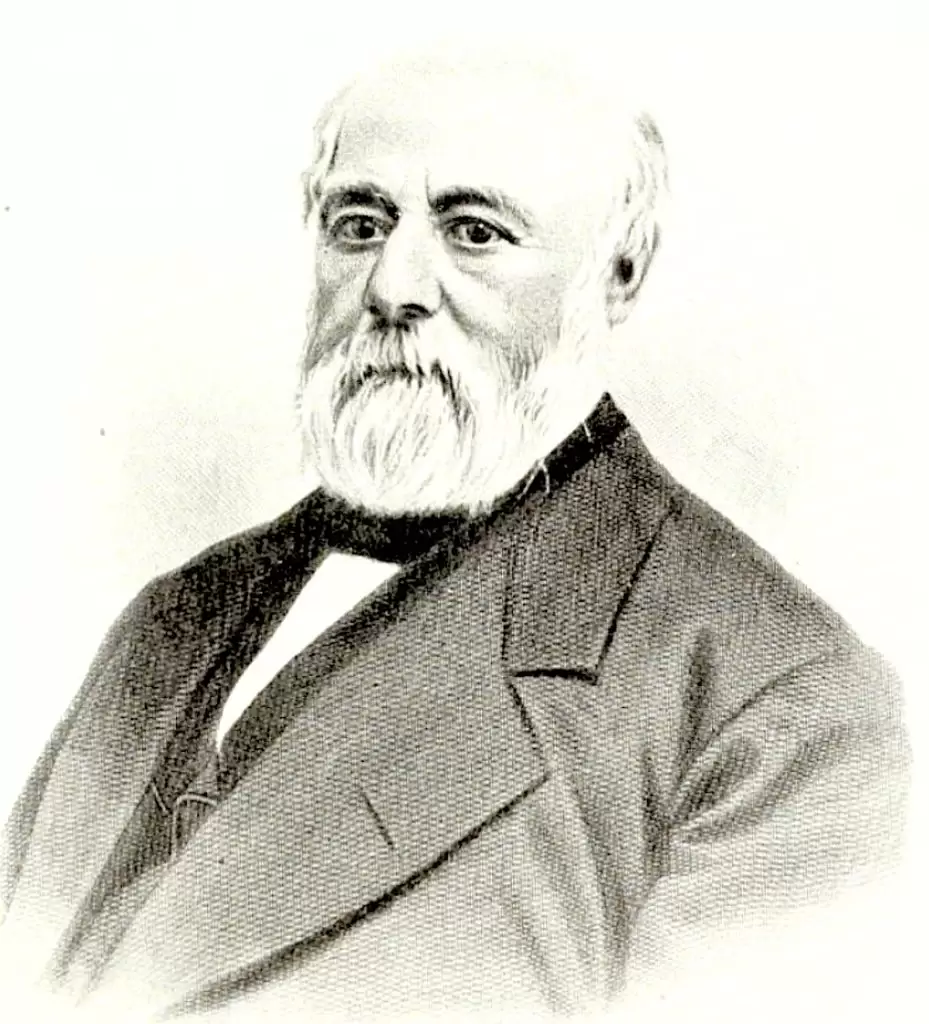
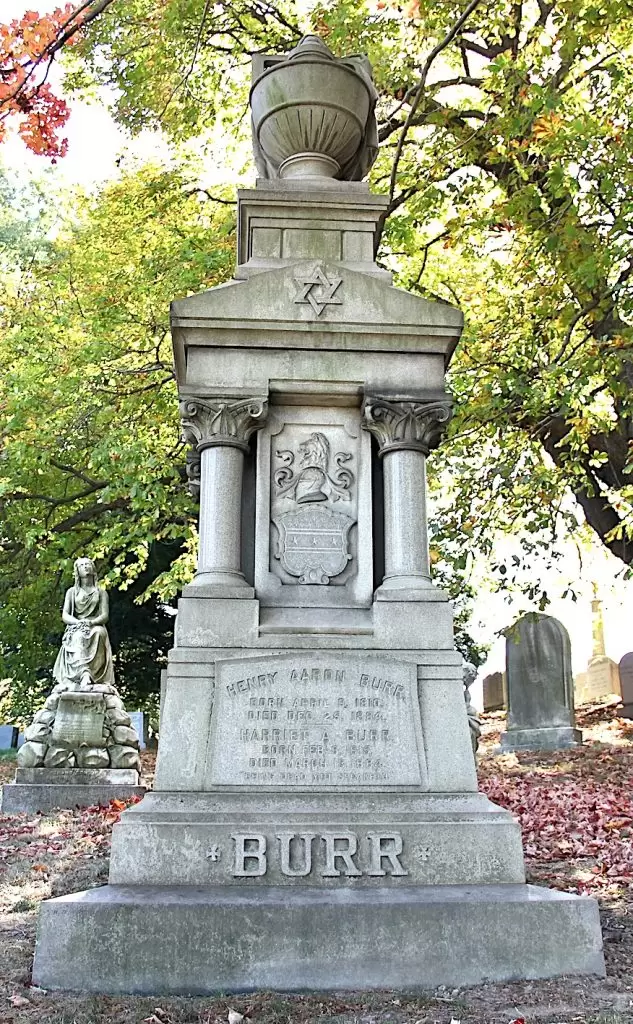
BURRALL, FREDERICK AUGUSTUS (1830-1908). Acting assistant surgeon, United States Volunteers. Born in Machias, Maine, his father, also Frederick Augustus, was a direct descendant of Colonel Charles Burrall, a Revolutionary War general. Burrall was a graduate of Williams College, class of 1850, where he was a member of the Philogian Society (an organization for the study of language and literature) and Sigma Phi Fraternity. He then spent three years in Europe studying languages and literature before settling in New York in 1853 to study medicine. He graduated from the College of Physicians and Surgeons of the University of the City of New York, class of 1858. After graduation, he was attending surgeon at the Northern Dispensary. On April 19, 1859, he married Mary Lee; they had one son.
During the Civil War, Burrall was connected with various relief organizations and served for a time as an acting assistant surgeon on the hospital ship St. Mark. In 1866, he wrote “Burrall on Asiatic Cholera” which established him as a leading medical writer. In addition, he wrote “Nitrate of Amyl as an Antidote to Chloroform” and “A Case of Drowning with Resuscitation,” a text that encouraged other physicians to keep up their efforts to restore consciousness. He also contributed for some time to The Hour, a weekly publication. Burrall was a physician at the Northern Dispensary (1857-1871), then served as consulting physician at the Home for Aged and Indigent Females (1874), manager of the New York Infant Asylum (1875), and visiting surgeon at Charity Hospital on Blackwell’s Island (1866) and the Presbyterian Home (1875-1885).
Burrall is listed as a physician in the New York City Directories for 1875-1876, 1876-1878 and 1891-1892. In 1892, he lived at 48 West 17th Street. Among his professional memberships were the New York State Charity Aid Association, American Medical Association, New York Academy of Medicine, American Geographic Society, Alumni Association of the College of Physicians and Surgeons in the City of New York and New York County Medical Societies. In addition, he was a member of the Society of the Sons of the Revolution and was a deacon of the University Place Presbyterian Church. Admired by others, a colleague said, “Dr. Burrall is a man who has been thoroughly prepared and who has the ability to bring all that he has learned to the attainment of his results.” He was the brother of Stephen E. Burrall (see). He last lived at 48 West 17th Street in Manhattan. His death was attributed to senile dementia. He died in White Plains, New York. As per his obituary in The New York Tribune, his funeral was held at the University Place Presbyterian Church in Manhattan. Section 68, lot 412.
BURRALL, STEPHEN ERASTUS (1827-1868). Private, 37th Regiment, New York State National Guard, Company C. Born in Lubec, Maine, his father was a direct descendant of Colonel Charles Burrall, a Revolutionary War general. An outstanding student, Burrall earned a bachelor’s degree from Williams College in 1847, and studied law at Harvard from 1849 to 1850. During his college years, he was elected to Phi Beta Kappa, the renowned honor society, and won the Moonlight Prize as a sophomore. Burrall was admitted to the bar in New York City in 1850, then traveled abroad for three years before starting his law practice in Brooklyn. A poet and orator he gave an oration before the Laurel Hill Association in Stockbridge, Massachusetts, in 1855, and at the Summer Alpha Convention in Massachusetts in 1857. (The Summer Conventions were sponsored by Sigma Phi, a college fraternal society at its various chapters.) The 1859 New York City Directory lists Burrall as a lawyer at 24 William Street who lived in Gramercy Park. He is listed as a member of the New-York Historical Society in 1859.
During the Civil War, Burrall served three months with the 37th Regiment in 1862; the regiment was assigned to garrison duty in Baltimore, Maryland. He was an orator at the Delta New York Convention in 1864 and was a poet at the Alpha Summer Convention in Massachusetts in 1867. The poem he presented at the latter conference, which coincided with the 40th Convention of Sigma Phi, was published posthumously in Boston in 1868 as a memorial to him. His younger brother, Frederick Augustus Burrall (see) was an acting assistant surgeon during the War. His last residence was 28 West 20th Street in Manhattan. His cause of death was marasmus (severe malnutrition and loss of energy). Section 68, lot 412.
BURRELL, JAMES P. (1842-1923). Corporal, 22nd Regiment, New York State National Guard. After enlisting as a private at New York City on June 2, 1862, Burrell immediately mustered into the 22nd New York (company unknown). He was promoted to corporal on June 15, and mustered out after three months on September 5 at New York City. He last lived at 1 West 82nd Street in Manhattan. Burrell died from heart disease. Section 154, lot 22521, grave 4 and 5.
BURRELL (or BURRILL), WILLIAM ALEXANDER (1828-1863). Sergeant, 36th New York Infantry, Company I. William Burrell was born in Kent, England on November 28, 1828. As per the Find A Grave website, he was baptized at Saint Mary Magdalene Church in Kent on December 21, 1828. On October 25, 1852, he married Mary Ellen Judd. The couple had two sons and a daughter before they immigrated to the United States. He is listed on the manifest of the Isaac Webb as William Burrill, leaving from Liverpool and arriving in New York City on May 8, 1858.
As per the New York Register of Officers and Enlisted Men and the General Index to Pension Files, 1861-1864, Burrell enlisted as a sergeant in April 1861 and mustered into Company I of the 36th New York Infantry. Whereas the New York State Register lists an enlistment place of New Lots, Brooklyn, the Pension Index indicates Rikers Island. William’s muster roll indicates that he mustered into his regiment on July 4 at Rikers Island and was paid $28.60 by New York State from May 14 through July 3, 1861. Although a promotion is listed for July 22, 1861, no rank other than sergeant is noted. He was discharged for disability on February 4, 1862. He died on September 29, 1863, at New York City’s Bellevue Hospital, of liver disease, survived by his wife, Mary E. A. Burrell. On April 25, 1864, Mary applied for and received a widow’s pension, certificate 281,315. She is listed as William’s widow in the 1878 Brooklyn Directory and as working in groceries. Section 127, lot 8259, grave 143.
BURRILL, SAMUEL NORTHROP (1827-1916). First lieutenant, 8th Regiment, New York State National Guard, Company H. Born in Litchfield, Connecticut, he enlisted as a first lieutenant at New York City on April 23, 1861, and was commissioned into the 8th New York on April 25. His company fought at Bull Run, Virginia, during its tour of duty. On August 2, 1861, he mustered out at New York City.
Burrill is listed as an undertaker in the Brooklyn Directories for 1863 and 1873-1876. His family was in the undertaking business for almost a century and at the time of his retirement in 1908, he was the oldest living undertaker in Brooklyn. His obituary in the Brooklyn Standard Union, which confirms his Civil War service, notes that he headed his family’s undertaking business for fifty years.
A member of the Henry M. Lee Post #21 of the G.A.R., he listed William Halsey as his intimate comrade in the post’s sketch book. Burrill was also a member of the Anglo-Saxon Lodge of the Freemasons. In addition, he was for many years a sexton at the Nostrand Avenue Methodist Episcopal Church in Brooklyn. He last lived at 336 Princeton Avenue in Jersey City, New Jersey, where he resided for three years. His death was attributed to senility As per his obituary in the Brooklyn Daily Eagle, his funeral was held at the home of his daughter at 455 Lafayette Avenue in Brooklyn. He was survived by one son, who was also an undertaker, and three daughters. Section 42, lot 242.

BURRILL (or BURRELL), WILLIAM HENRY (1848-1915). Private, 139th New York Infantry, Company E. A native of Augusta, Maine, Burrill enlisted at New York City as a private on August 20, 1862, and mustered into the 139th New York on September 9. According to a descendant, he left home and lied about his age when he enlisted. (Service documents state that he was 20 when he enrolled.) During his service, he was taken prisoner of war at Vicksburg, Mississippi. He was discharged on July 19, 1865, at New York City.
In 1889, Burrill’s application for an invalid pension was approved, certificate 694,281. He attended the 50th anniversary of the 139th Regiment as per an article in the Brooklyn Daily Eagle on September 12, 1912. His last residence was 181 Prospect Park West in Brooklyn. Shortly after his death from angina, Helen Burrill received a widow’s pension, certificate 794,084. Section 63, lot 21581.
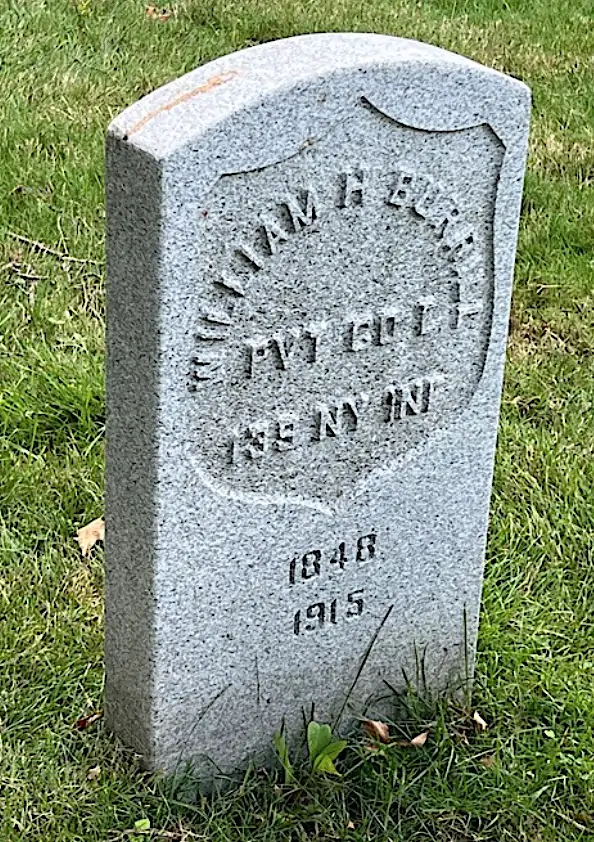
BURROUGHS, CHARLES W. (1844-1924). Private, 11th New York Cavalry, Companies H and C. A Brooklynite by birth, Burroughs enlisted as a private on January 16, 1864, at Clay, New York, and mustered into Company H of the 11th New York Cavalry four days later. On July 21, 1865, he transferred intra-regimentally to Company C, and mustered out of service on September 30, 1865, at Memphis, Tennessee.
A fur merchant, Burroughs remained active in military affairs, and was a member of the Abel Smith Post #435 of the Grand Army of the Republic. His last residence was 11 Linden Avenue in Brooklyn. His death was attributed to an intestinal obstruction. Section 204, lot 33547, grave 2.
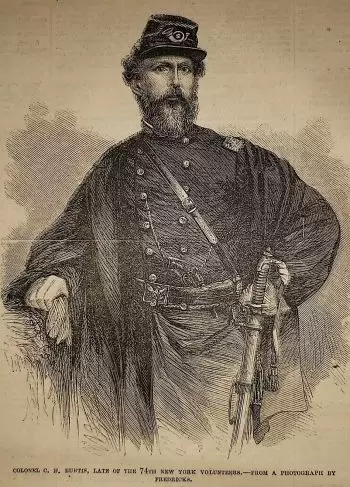
BURTIS, CHARLES H. (1832-1893). BURTIS, CHARLES H. (1830-1893). Colonel, 15th New York Infantry; lieutenant colonel, 74th New York Infantry. As per an undated issue of Civil War Records: Town of Oyster Bay, compiled by town historian John E. Hammond, Charles was born circa 1830 in Oyster Bay, Long Island. He was the son of Townsend Weeks Burtis and Sarah née Lowe. He was a descendant of Pietro Caesar Alburtus, who was the first Italian immigrant to America in 1635. In 1642, Albertus married Janse Meynje in New Amsterdam. Hammond notes that over time the surname Albertus evolved to Burtis.
At the time of the onset of the Civil War, Charles was the tax assessor of his hometown of Oyster Bay, having been elected to that position on April 2, 1861. As per the Report of the New York State Adjutant General, he enlisted on June 1, 1861, in Staten Island, as a lieutenant colonel in the 74th New York Infantry. He was commissioned into that regiment three months later, and served until he was discharged in September, 1862. As per Hammond, the 74th mustered on June 30, 1861, at Camp Scott, Staten Island, and received training there. In August 1861, the unit was assigned to Sickle’s Brigade, part of General Hooker’s Division of the Army of the Potomac. In April 1862, the 74th engaged in the siege of Yorktown, Virginia, and played a major role in the Battle of Williamsburg, Virginia, where 143 soldiers of the 74th were killed. Hammond cites The Honors of the Empire State in the War of the Rebellion for including this quote about Burtis: “He was with his gallant regiment in the various battles on the Peninsula, and fought not only wisely, but too well, as the fatigue he underwent resulted in illness, which compelled him to resign.” Soldier records confirm that Charles was discharged for disability on account of exposure, fatigue, and fever contracted during the Peninsula Campaign.
On June 6, 1864, he re-enlisted at Flushing, Queens, and was mustered into the 15th New York Infantry as its colonel. As per The Union Army, the 15th had its roots in the 74th. The 15th was mustered into United States service for 30 days, and served in New York Harbor before it, and Burtis, were discharged.
In civilian life, Burtis married Martha Davis of Morris, New York, on April 6, 1864. On December 22, 1865, still living in Oyster Bay, Charles was elected trustee of Oyster Bay School District 9, a position he held for one year. The Burtises then moved to Brooklyn, living at 135 Decatur Street. Martha died in 1878 and was buried at Green-Wood.
After the war, several corporations involved with railroad bonds employed him. Colonel Burtis was a member of the John A. Roebling Post #185 of the Grand Army of the Republic. As per his obituary in The New York Herald, comrades from the G.A.R. were invited to attend his funeral. He last lived at 135 Decatur Street in Brooklyn. His sudden death was attributed to a stroke; he was buried next to his wife. As per his will, probated on June 30, 1893, in Kings County, Burtis left his property in Oyster Bay to his surviving son, Charles Ernest Burtis. Section 78, lot 928.
BURTIS, CLARENCE A. (1835-1894). Sergeant major, 83rd New York Infantry, Company H. Before the Civil War, Burtis was considered the best baseball player on the Gothams of the National Association. He had the third highest runs-per-game ratio in the league and in a game against the Mutuals on September 4, 1860, hit two home runs. He played for the Gothams in 1859-1860, but he did not play in 1861 when he served his nation in the Civil War. After enlisting as a private at New York City on May 24, 1861, Burtis mustered into the 83rd New York three days later, and was promoted to sergeant major on June 8, 1861. On June 16, 1862, he was discharged for disability at Georgetown, Washington, D.C.
A sketch of his baseball career, which confirms his Civil War service, indicates that Burtis returned to baseball in the summer of 1862 and played through 1865. In addition to his baseball playing, he was a house painter. He is listed as a house painter in the New York City Directory for 1878; at that time, he lived at 204 West 10th Street. Remaining active in baseball, he played in the 1888 old timer’s game. He was still working as a painter according to the New York City Directory for 1891-1892. Like many ball players of his era, he was active in the Fire Department. As per his death certificate, he was a house painter; his baseball sketch referred to him as “a boss painter in the Ninth Ward.” He last lived at 99 Barrow Street in Manhattan. Section 69, lot 11400.
BURTIS, GEORGE ALVAN (1841-1898). Sergeant major, 165th New York Infantry, Company F; corporal, 5th New York Infantry, Company E. A clerk and native of Brooklyn, Burtis enlisted on April 23, 1861. He was 5′ 5½” with gray eyes and a dark complexion. After mustering into the 5th New York as a private on May 9, he was promoted to corporal on October 15, 1861, and fell sick on August 9, 1862. Later detailed as a nurse at West’s General Hospital in Baltimore, Maryland, he returned to his unit on March 23, 1863, was court-martialed for deserting the hospital and not returning to camp when ordered, acquitted of the charge, and mustered out with his company on May 14, 1863.
Subsequently, he re-enlisted as a private on February 10, 1864, mustered into the 165th New York, and was promoted to corporal a month later on March 24. Burtis was wounded in the left forearm at Pleasant Hill, Louisiana, on April 9, 1864, and hospitalized in New Orleans until June 30, 1864. After returning to service, he was promoted to sergeant on October 21, 1864, to sergeant major on March 2, 1865, and mustered out on September 1, 1865.
Burtis was an accountant after the Civil War. His wife, Elizabeth Proctor Burtis, the sister of Clara Morris, a famous actress, had been given away to another family as an infant. Mrs. Burtis suspected this but did not learn of its truth until a New York Times reporter discovered it shortly before her death. In 1894, Burtis applied for an invalid pension that was granted under certificate 970,082. The pension bureau contested Burtis’ pension application for several years due to lack of a confirmed diagnosis of nervous disease and cirrhosis. His last residence was 62 West 50th Street in New York City. He died from a hemorrhage. Elizabeth Burtis applied for a widow’s pension in 1906; her certificate was 684,051. Her request for a pension increase was denied because the date of their marriage, 1882, was after the time of his service. Section 78, lot 929.
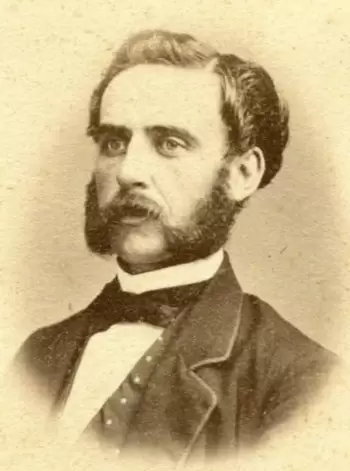
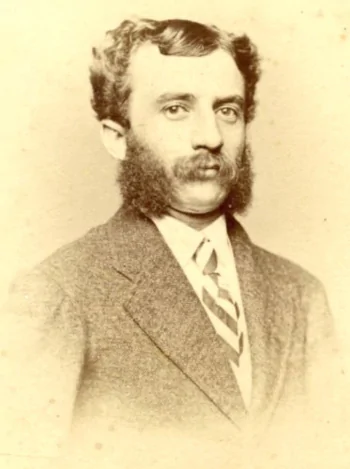
BURTON, FREDERICK W. (1837-1872). Quartermaster sergeant, 137th New York Infantry. Originally from Nova Scotia, Canada, he enlisted as a quartermaster sergeant on August 20, 1862, at Binghamton, New York, and mustered into the Field and Staff of the 137th New York the same day. On November 24, 1862, he was reduced in rank to private. Further details of his service are unknown. His last residence was in New York City. Section 86, lot 18066, grave 38.
BUSH, ABRAHAM V. B. (1829-1915). Captain, 56th Regiment, New York State National Guard, Company H. Bush was born in Brooklyn. As per his obituary in the Brooklyn Daily Eagle, his mother, Maria Paynton, was the daughter of a a noble lady in England, who, before her marriage to Abraham’s father, ran away from home to marry a poor man and settled in the southern United States. Apparently, Bush could have been titled an earl if he had the papers of his descent. He is listed as a builder in the Brooklyn Directory for 1857-1862. During the Civil War, Bush enlisted as a captain and was commissioned into the 56th National Guard at Brooklyn on June 18, 1863, and mustered out the next month on July 24.
The Brooklyn Directories for 1873-1876 and 1894-1896 list Bush as a builder. According to his obituary in the Brooklyn Daily Eagle, which confirms his Civil War service, he was also a master mechanic and draftsman for the Waterbury Rope Company. His plans led to that company building of a rope making plant in Beverley, New Jersey. As per the census of 1900, he had been married for fifty years and lived in Brooklyn.
Bush belonged to the Knights of Phythias and was chancellor commander of his lodge. He was also a member of the 12th Street Reformed Church. His obituary in the Brooklyn Standard Union notes that he was a prominent builder. He last lived with his son at 265 Seventh Avenue in Brooklyn. His death was attributed to senility. He was survived by four sons; his wife, Phoebe, who died in 1909 and their daughter, Gertrude, who died in 1903, are interred with him. Section 59, lot 871, grave 12.
BUSHNELL, DARIUS G. (1837-1886). Corporal, 77th New York Infantry, Company C. A native of Newark, New Jersey, Bushnell enlisted as a private at Albany, New York, on August 6, 1862, and mustered into the 77th New York the same day. He was promoted to corporal at some point during his service. On September 17, 1862, he was wounded at the Battle of Antietam, Maryland, and was discharged for disability at Philadelphia, Pennsylvania, on November 11, 1862.
The New York City Directories for 1875-1876 and 1876-1878 report that Bushnell worked as a clerk at City Hall; during those years, he lived at 20 Prospect Place in Brooklyn. At the time of the census in 1880, he was still employed as a clerk at City Hall. In 1885, he applied for an invalid pension, application 549,171, but he apparently died of Bright’s disease before it was certified. His last address was in Orange, New Jersey. Lydia Bushnell, his wife, applied for and received a widow’s pension in 1890, certificate 591,360. Section 111, lot 11827.
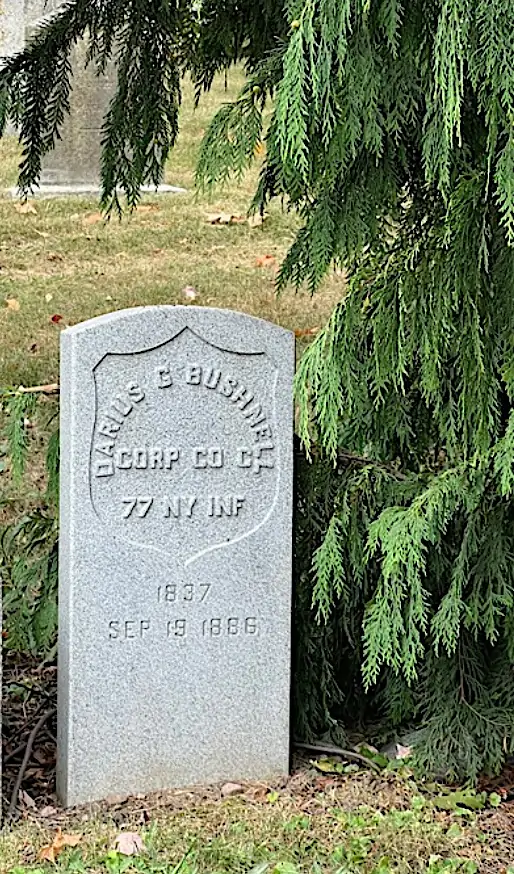
BUSSING, THOMAS DEWITT (1840-1900). Private, 38th Pennsylvania Infantry, Company A; 2nd Veteran Reserve Corps, Company 109. New York City-born, Bussing enlisted as a private on August 26, 1862, and mustered into the 38th Pennsylvania the same day. On February 15, 1864, he transferred into Company 109 of the 2nd Battalion, Veteran Reserve Corps from which he was discharged on an unknown date. On September 4, 1865, his application for an invalid pension was approved under certificate 52,310.
According to the 1880 census, Bussing was employed as a plate printer. He last lived at 5 Greene Avenue in Brooklyn. His death was attributed to nephritis. Ella Bussing, who is interred with him, applied for and received a widow’s pension, certificate 504,103. Section 131, lot 34990, grave 2.
BUTCHER, ABRAHAM (or ABRAM) B. (1847-1920). Private, 37th Regiment, New York Infantry, Company H. A New Yorker by birth, his pension index card shows that he served in Company H of the 37th New York. That document indicates additional service in Company F of the 84th New York Infantry. The 1890 Veterans Schedule lists him as a veteran and gives his rank as private. No further information is available.
The 1870 census notes that Butcher lived in New York City with his parents and siblings and, following in his father’s footsteps, worked as a plumber. He is listed as a plumber in the Brooklyn Directory for 1873-1876; he lived during those years at 217 Sands Street. According to the 1890 Veterans Schedule, he was living at 1081 Hancock Street in Brooklyn. He is listed as a plumber on Water Street in Manhattan in the New York City Directories for 1894-1895 and 1896-1897 and was living in Brooklyn. The census of 1900 indicates that he been married for twenty-six years, lived in Brooklyn with his wife and an adult child, and worked as a plumber. In 1904, his application for a pension was approved, certificate 1,079,434. As per the 1910 census, he was a plumber at a shipyard, lived with his wife at 79 Cooper Street in Brooklyn, and was able to read and write. At the time of the 1920 census, the last year of his life, he and his wife were living at the same Cooper Street address but he was not working. His death was attributed to arteriosclerosis. Shortly after his death, Harriet Butcher, who is interred with him, applied for and received a widow’s pension, certificate 893,118. Section 171, lot 9856.

BUTCHER, HENRY (1830-1917). Private, 62nd New York Infantry, Companies A and I. Born in England, Butcher enlisted as a private on May 1, 1861, at Union Square, New York, and mustered into Company A of the 62nd New York. On June 27, 1861, he had an intra-regimental transfer into Company I, and mustered out of service on February 11, 1865, at Petersburg, Virginia. Butcher last resided at 245 Classon Avenue in Brooklyn. His death was attributed to asthenia (loss of strength). Section 3, lot 33566.
BUTLER, AUGUSTUS P. (1825-1878). Captain, 2nd Regiment, United States Veteran Volunteer Infantry; second lieutenant, 83rd New York Infantry, Companies C, A, and H. A native of New York, he enlisted at New York City as a private on May 27, 1861, and mustered into Company C of the 83rd New York that day. Rising through the ranks, he became corporal of his company, sergeant and second lieutenant, filling the last position on February 20, 1863, upon his transfer that day to Company A. He was commissioned into Company H of the regiment on November 27, 1863, and mustered out at New York City on June 23, 1864. Returning to service on January 9, 1865, he was a captain in the 2nd Regiment, United States Veteran Volunteer Infantry, and was discharged on March 19, 1866. He last lived in the Occidental Hotel in New York City. Butler died from heart disease. Section L, lot 19858.
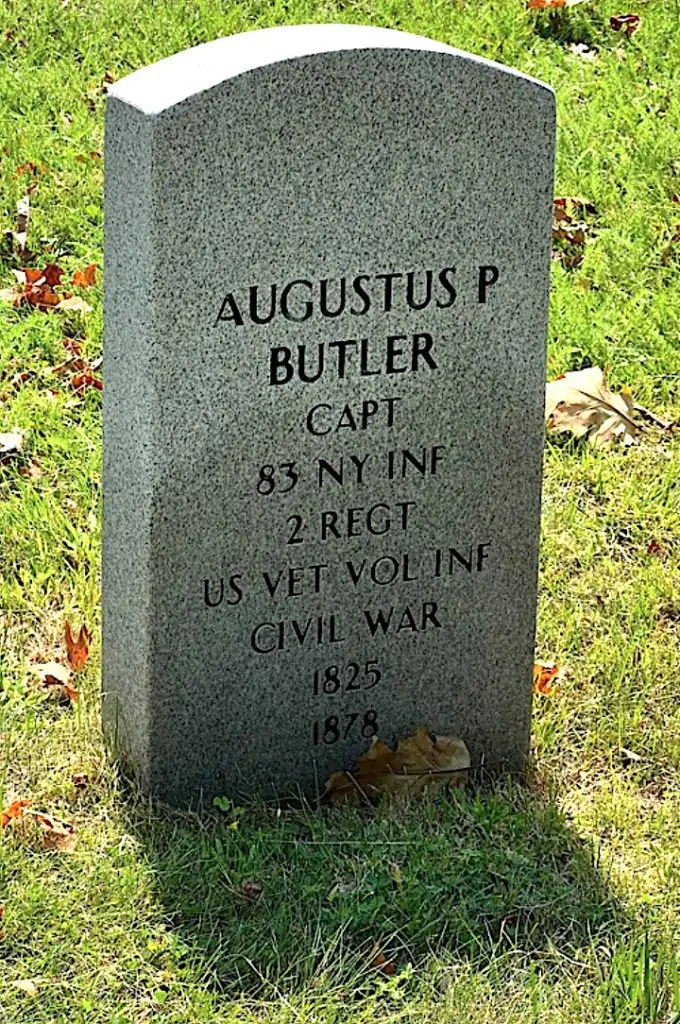
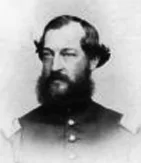
BUTLER, JAMES H. (1830-1905). Captain, 32nd New York Infantry, Company F. He was born and educated in Utica, New York, where his father, Comfort Butler, was a War of 1812 veteran who owned and operated a museum filled with stuffed animals and other curiosities. James Butler was a wholesale jeweler who came to New York City in 1852, went to California that same year, and returned to New York three years later. Butler enlisted as a captain at New York City on May 14, 1861, was commissioned into the 32nd New York on May 31, and served with the Army of the Potomac. Many officers in the 32nd had a connection to California; it was also known as the 1st California Regiment because it recruited men from the west coast.
According to his obituary in The New York Times, he fought at fifteen battles and numerous skirmishes including Bull Run, Virginia, but was only wounded once, receiving a bullet scratch on his left hand. At Antietam, Maryland, his company was forced to lie flat on the ground on their stomachs to escape annihilation. Among the other battles that he participated in were Fairfax Courthouse, Munson Hill, Seven Days, Fredericksburg, and Chancellorsville, all in Virginia, and Crampton’s Gap, Maryland. Although the obituary states that he was a lieutenant colonel on the staff of General Butler, his pension record indicates that his highest rank was that of captain. He mustered out on June 9, 1863, at New York City.
After the war, Butler was a diamond broker on Maiden Lane in Manhattan. He is listed as working in the diamond business at 9 Maiden Lane in the New York City Directories for 1875-1876, 1876-1878 and 1891-1892. In 1892, he lived at 55 West 28th Street in Manhattan. He was still employed in the diamond industry in 1900, according to the census for that year. Butler was a member of the George Washington Post #103 of the G.A.R. and the Military Order of the Loyal Legion. Active in civic life, his name was mentioned in The New York Times when he attended a dinner in Manhattan honoring California’s 31st anniversary as a state in 1881 and when he attended a reunion of his regiment in Ithaca in 1889. In 1884, his application for an invalid pension was granted, certificate 360,141. As per his obituary in The New York Herald, comrades from the G.A.R. and the Loyal Legion were invited to attend his funeral. He last lived at 43 West 27th Street in Manhattan. Butler’s death was caused by tuberculosis. His funeral took place at St. Luke’s Hospital in Manhattan. Section 29, lot 14797, grave 5.
BUTLER, STEPHEN H. (1839-1904). Private, 4th New York Cavalry, Company L; 9th New York Cavalry, Company L. A Brooklyn native, he enlisted there and mustered immediately into the 4th New York Cavalry on February 6, 1864, transferred into the 9th New York Cavalry on February 27, 1865, and mustered out on July 17, 1865, at Cloud’s Mills, Virginia. His application for an invalid pension was granted in 1891, certificate 703,871. A carpenter by trade, he last lived on Kings Highway in Brooklyn. he died from diabetes. Section 86, lot 31217, grave 142.
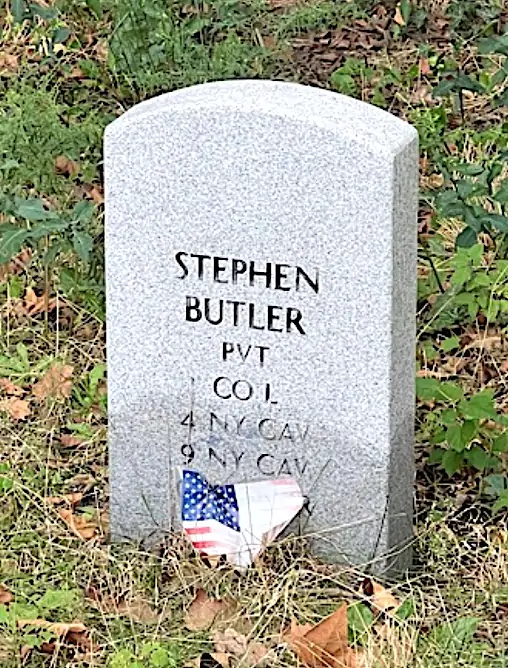
BUTLER, WILLIAM HARRIS (1843-1935). Private, 145th New York, Company E; 123rd New York, Company H. Born in New York City, he enlisted there as a private on August 15, 1862, mustered into the 145th on September 11, and transferred into the 123rd on December 9, 1863. He mustered out on June 8, 1865, at Washington, D.C.
In civilian life, he was in business with Mann & Mann, a Manhattan law firm, and the Nashville-Chattanooga Railroad. His application for an invalid pension was granted in 1905, certificate 1,107,076. He last lived at 136 Graham Avenue in Hempstead, Long Island. He died at age 92 from a gastric ulcer. Section 205, lot 27404.
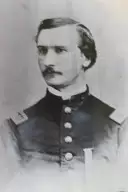
BUTTLE, RICHARD WARREN (1838-1898). Lieutenant colonel, major, and captain by brevet; first lieutenant, 133rd New York Infantry, Company D; 12th New York Infantry, Company D. Born in Dublin, Ireland, Buttle came to the United States as a boy with his parents, arriving in New York aboard the Atlas on November 8, 1848. He attended Oberlin College from 1855 through 1857. On April 19, 1861, he enrolled at New York City and mustered into the 12th Regiment, New York State Militia, on May 2, 1861. He re-enlisted on August 29, 1862, and mustered into the 133rd New York on September 24 as a first lieutenant. On January 10, 1864, he married his first wife, Helen Pamelia Barrett. He mustered out on June 6, 1865, at Washington, D.C. Upon his discharge, he mustered into the 12th New York Infantry. He was at the siege of Port Hudson, Louisiana, and was the first officer to volunteer for the Red River Campaign. On February 7, 1871, he was brevetted captain, major and lieutenant colonel for “gallant and meritorious services during the late War.”
Buttle’s first wife died in 1868; the couple had one son born in 1864. Subsequently, he married Adelaide Madge Hoffy at Christ Church in Brooklyn on November 8, 1871; they had two children. Employed in the woolen trade, he is listed as working in cloth in the Brooklyn Directory for 1880-1882. At that time, his business was at the corner of Church and Franklin Street in Manhattan; he lived at 362 Henry Street.
Remaining active in military affairs, Buttle was a member of the Military Order of the Loyal Legion, the Society of the Army and Navy of the Gulf, and the Ulysses S. Grant Post #327 of the G.A.R. He was also a member of the Amaranth Dramatic Society. As per his obituary in The New York Herald, members of the Grant Post were asked to attend his funeral in uniform. Samuel Buttle (see), who served in the 36th New York, was his brother. He last resided at 105 Berkeley Place in Brooklyn. His death was attributed to Bright’s disease. His funeral took place at the St. John’s P. E. Church at St. John’s Place and Seventh Avenue in Brooklyn. Section 202, lot 28870.
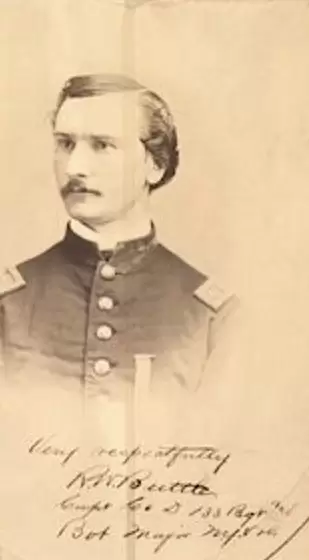
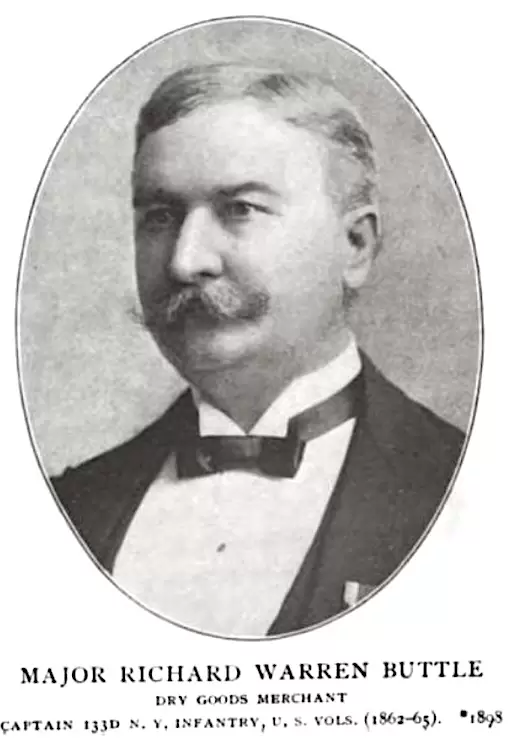
BUTTLE, SAMUEL WARREN (1835-1869). Private, 36th New York Infantry, Company G. Born in New Jersey, he enlisted and served in Company G of the 36th New York. Further details are unknown. He was the brother of Richard Buttle (see). He last resided on Mill Street in Newark, New Jersey. The cause of his death was listed as “congestion of the brain” (brain swelling). Section 152, lot 18262.
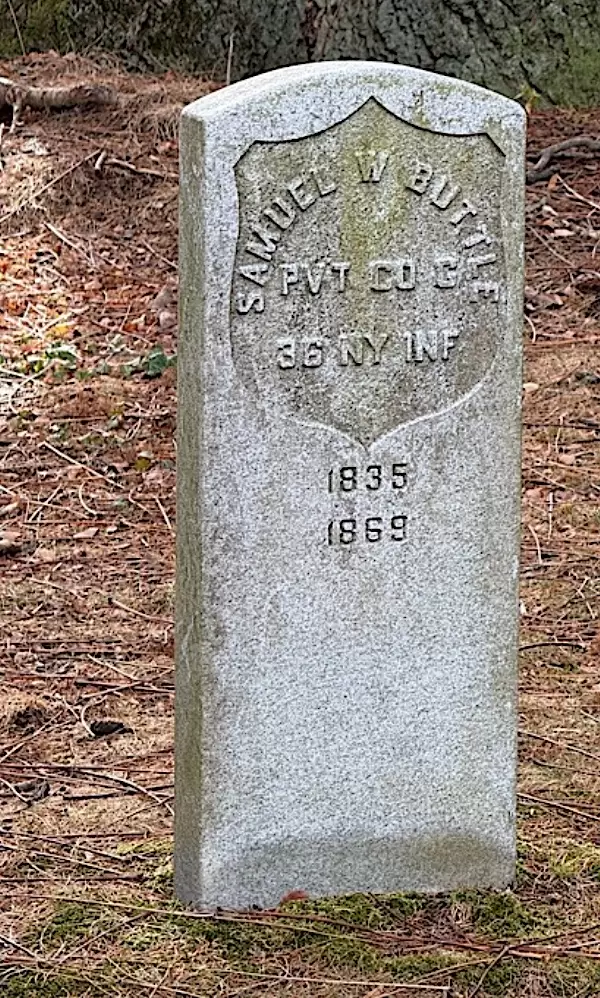
BUTTS, LORIN (or LORING) HYDE (1833-1915). Private, 81st Pennsylvania Infantry, Company K; 104th Pennsylvania Infantry, Company I. Butts was born in Pennsylvania. His obituary notes that his father was a professor and his mother, Harriet Hyde Butts, descended from Lord Carrington of England and was a sister of Colonel Hyde of the Continental Army.
During the Civil War, his first term of military service began on October 27, 1861, when he enlisted and mustered into the 81st Pennsylvania Infantry. As per his obituary in the Brooklyn Daily Eagle, which recounts his Civil War service, Butts was taken as a prisoner of war while in action and was incarcerated at Belle Isle, from which he was discharged for disability. He re-enlisted on March 6, 1865, mustered into the 104th Pennsylvania on that day, and mustered out on August 25, 1865, at Portsmouth, Virginia.
Butts’s application for an invalid pension was granted in 1882. His last residence was 744 Dean Street in Brooklyn. He died from nephritis and heart disease. He was survived by his wife, Lavina Kocher Butts, and their daughter. Shortly after his death in 1915, Lavina K. Butts applied for and received a widow’s pension, certificate 801,840. On November 12, 1918, his remains were removed from lot 34278 to its present location. Section 131, lot 35087, grave 2.
BYERS (or BYARS), RICHARD (1824-1864). Private, 90th New York Infantry, Companies H and E. Byers is not buried at Green-Wood; the inscription is a cenotaph in his family’s plot that honors his memory. Byers enlisted at Brooklyn as a 38-year-old private on September 30, 1862, and mustered into Company H of the 90th New York. On April 7, 1863, he was transferred intra-regimentally into Company E. As per his soldier record, he was taken as a prisoner of war on October 19, 1864, at the Battle of Cedar Creek, Virginia, and incarcerated at Salisbury, North Carolina; he died there of diarrhea on December 19, 1864. However, a record from Libby Prison in Richmond, Virginia, shows that a 28-year-old Richard Byars from the 9th New York died there on December 17, 1864. (The errors in regiment number, age and date of death might be transcription errors.) The plaque on his gravestone indicates that he died in Saulsbury Prison. In 1871, his children received a minor’s pension, certificate 151,555. Section 143, lot 22340.
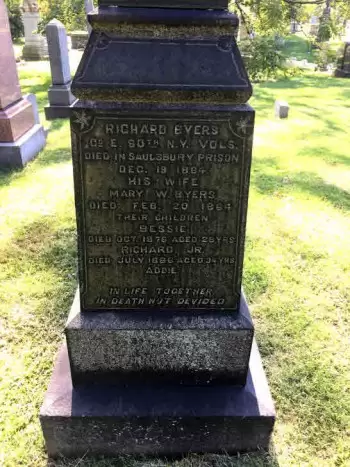
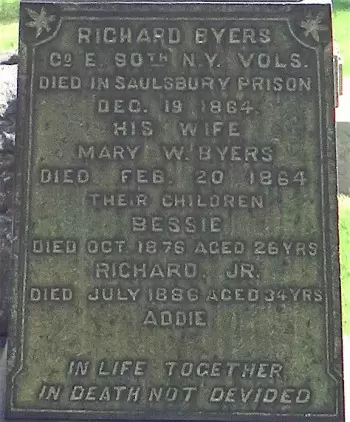
BYERS, SAMUEL (1840-1890). Private, 84th New York (14th Brooklyn) Infantry, Company A; 5th New York Veteran Infantry, Company I. Of Irish birth, Byers enlisted at Brooklyn as a private on August 20, 1862, and mustered into the 14th that day. On July 1, 1863, he was severely wounded in his thigh and intestines on the right side at the Battle of Gettysburg, Pennsylvania. Subsequently, he was transferred into Company I of the 5th New York Veteran Infantry on June 2, 1864.
Byers’s application for an invalid pension on May 11, 1867, was approved under certificate 98,782. He last lived at 368 Baltic Street in Brooklyn. His death was attributed to meningitis. In 1890, his child received a minor’s pension, certificate 384,145. Section 51, lot 11502.
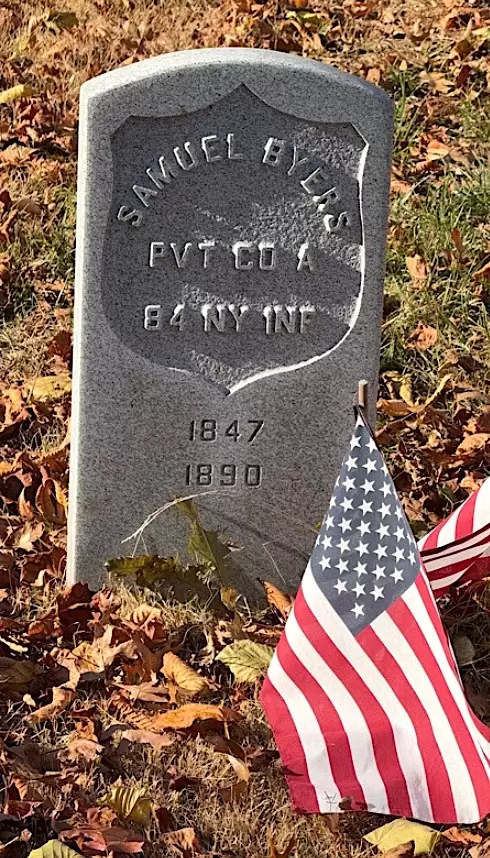
BYRAM, JOHN J. (1827-1862). Private, 51st New York Infantry, Company G. A native of New York City, Byram was 5′ 8¾” with hazel eyes, dark hair and a fair complexion. A bookkeeper by trade, he enlisted as a private on August 19, 1862, and mustered into the 51st New York the same day. His records indicate that he was in the 84th New York (14th Brooklyn), Company C, prior to his service in the 51st. He was killed at the Battle of Fredericksburg, Virginia, on December 13, 1862. Samuel Sims (see), Byram’s captain, wrote to Byram’s wife, on December 19, 1862:
Dear Madame:
It has become my most painful duty to notify you of the death of your husband which occurred at the battle of Fredericksburg Dec. 13th.
I sincerely trust that you will be …a knowledge of the manner of his death my help to alleviate a pang in your sufferings.
Our Regiment with the Brigade attacked the Rebel works early in the afternoon of the 13th. We had reached the further-point-gained by any of our troops after passing through a fearful fire of artillery. We laid near the brow of a small hill, delivering and receiving a terrible fire of muskets. Five of our color guard had been either killed or disabled. The color was falling the fifth time when your husband caught it. He bore it until a shot struck him in the head. He was pointing at a large cut in the flag and was saying, ‘See where our flag is struck again.’ These were his last words, his death was instantaneous. He was buried near the field Dec. 17th by a fatigue party from our side.
I must now tell to you of the esteem in which your husband was held by all of the officers…Pleasant Valley Md. and obliged cheerfully the fatiguing marches to this place. Our duties have been very severe but has never uttered a complaint—although he suffered a good deal from sore feet. In the last great Battle he was noticed and praised by all who saw him. His heroic death has won a place among the list of the many noble names who have bled to save our country.
My duty now is to forward a final statement of John’s death to Lorenzo—as Adjutant Genl. of the army and to effect a settlement of his affairs with the government.
Believe me dear madame to be sincere in sympathizing with you in this great bereavement.
Praying that God in his mercy may assist and strengthen you and grant you resignation.
I am sincerely your friend.
Samuel H. Sims
Capt. Co G 51st N.Y.
Any further information I can give upon your requesting will be promptly rendered.
In another letter, Sims praised Byram as one of the many “noble and heroic men who have died to save their country.” Byram’s body was never recovered. His widow, Mary Smith Clayton Byram, subsequently married William W. Davis (see). According to family lore, William and John were best friends and both were in the 14th Brooklyn at some point. William Davis visited Mary to pay his respects after John’s death; eventually the two married. Cenotaph is in section 55, lot 9367.
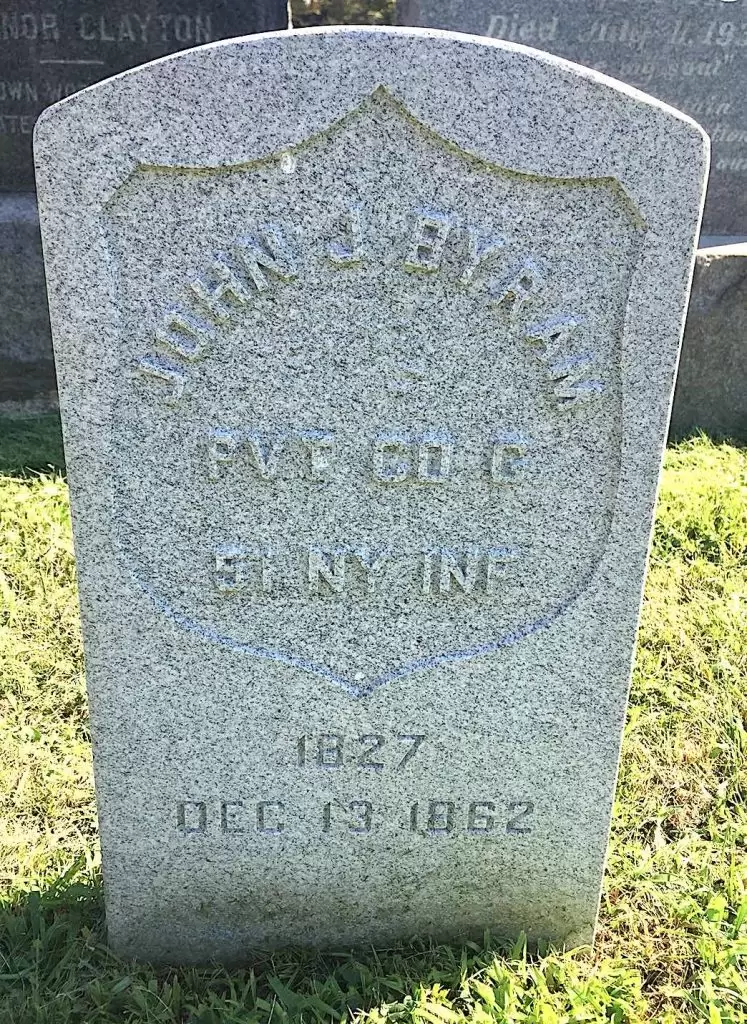
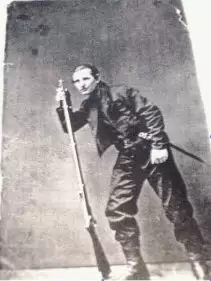
BYRD, FREDERICK (1842-1924). Private, 9th New York Infantry, Company F. A native of New York State, Byrd mustered into the 9th New York on May 4, 1861, and mustered out at New York City on May 20, 1863, as per the volunteer term of enlistment of two years. The 9th Regiment, better known as Colonel Hawkins’ Zouaves, was mainly a volunteer army and was famous for its colorful uniforms and bravery on the battlefield. The Hawkins’ Zouaves fought in the Battle of Antietam, Maryland, and suffered enormous casualties, including Byrd’s cousin John.
Byrd, however, spent much of the War garrisoned at Plymouth, North Carolina, and did not fight there. In a letter to his mother Mary Byrd, written July 8 and 9, 1861, Byrd talked about scouting and guard duty and mentioned a general inspection of his camp by General Benjamin Butler when “severe rules” were read about not taking and bringing home anything “valuable.” The letter concludes: “Don’t forget sending me a box as we get nothing much but hard biscuit and poor coffee and meat once a day.”
In 1898, he applied for an invalid pension, application 1,208,922, but no certificate number is listed. His pension record indicates that he was also known as William F. Byrd, and had additional service in the 56th New York National Guard. In 1900, when he was living in Brooklyn according to the census, his pension application was approved, certificate 1,077,146. He last resided at 626 Madison Street, Brooklyn. Byrd died from heart disease. Section 46, lot 6454, grave 1.
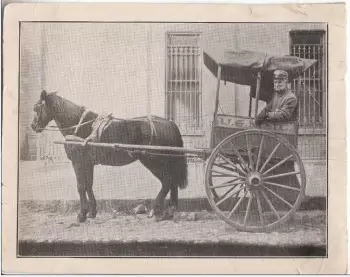

CADMUS, JR., RICHARD B. (1836-1901). Private, 13th Regiment, New York State Militia, Company C. A native of Brooklyn, Cadmus enlisted as a private in 1861 and served with the 13th Regiment during its three-month activation.
In civilian life, he was employed as an oil superintendent. He is likely the Richard B. Cadmus Jr. listed as a painter in the Brooklyn Directory for 1867-1870. In 1889, he successfully applied for an invalid pension, certificate 1,020,920. Cadmus last lived at 41st Street and Felix Street in Brooklyn. His death was attributed to tuberculosis. Section 119, lot 89421, grave 3.
CAIN, HARRISON (1840-1893). Sergeant, 10th New York Infantry, Companies A and B. Born in New York City, he enlisted there as a private on March 10, 1862, and mustered immediately into Company A of the 10th New York. On April 26, 1863, he had an intra-regimental transfer into Company B. On October 20, 1863, he was promoted to sergeant, and mustered out on March 14, 1864, at Stevensburg, Virginia. His last residence was 264 8th Avenue in Manhattan. Shortly after his death from paralysis in 1893, Mary Cain, who is interred with him, was granted a widow’s pension, certificate 375,771. Section 33, lot 9390.